

Sustainable Tourism in Thailand – Ecotourism, Wildlife and Culture Guide
- Last Updated: January 19, 2024
Thailand, the Land of Smiles, has firmly cemented itself as one of the most popular tourist destinations on the planet.
With 39 million people visiting the Southeast Asian nation in 2019 , the word is well and truly out on just how magical Thailand really is.
The international tourism industry in Thailand really started back in the 1970s, when travellers made their way here along the old ‘Hippie Trail’ from England.
This paradise was their reward after months of tough overlanding, with swaying palm trees, white-sand beaches, hospitable locals, and some of the tastiest food imaginable.
Today the magic is still alive and well in Thailand, and with so many incredible places to visit , it’s the kind of place you can visit again and again and always discover something new.
Locals welcome tourists with open arms, excited to show their local culture and customs to visitors and to improve their own livelihoods through businesses that cater to international travellers.
The impacts of the tourism industry on Thailand haven’t always been positive though, and with the growing number of people coming every year, there has been a number of issues arise.
As a responsible traveller , it’s important for us all to do our part to protect the countries we visit, including the environment, culture, local community, and wildlife.
READ MORE: Don’t miss our comprehensive guide to sustainable tourism .
Table of Contents
Closing Popular Tourist Destinations
‘no foam no plastic’, new heaven reef conservation, elephant nature park, the soi dog foundation, the gibbon project, phuket, bangkok tree house, soneva kiri – koh kood, rabeang pasak treehouse resort – chiang mai, always show respect to the king, do not turn your back towards buddha, watch where you point your feet, do not touch a person’s head, show respect to the monks, dress modestly, cover-up in temples, do not raise your voice, try to learn a few thai words, barter, but don’t be extreme, long-neck tribes, minimise your plastic use, do not litter, take public transport where possible, oceans and marine parks, travel off the beaten path, local community based tourism in thailand, sustainable tourism in thailand – the ultimate guide.
We’ve been fortunate enough to spend almost an entire year travelling and living in Thailand, and it is honestly one of our favourite countries in the world.
As part of our travels we’ve seen the best, and worst, of tourist behaviour and impacts here, which is why we have published this guide.
We are big advocates for sustainable tourism, and we are pleased to see it’s not just a global trend, but a movement that even the Thai government is taking very seriously.
Before you decide to travel to the Land of Smiles, make sure you read up on these tips and ideas on how to travel to Thailand responsibly.
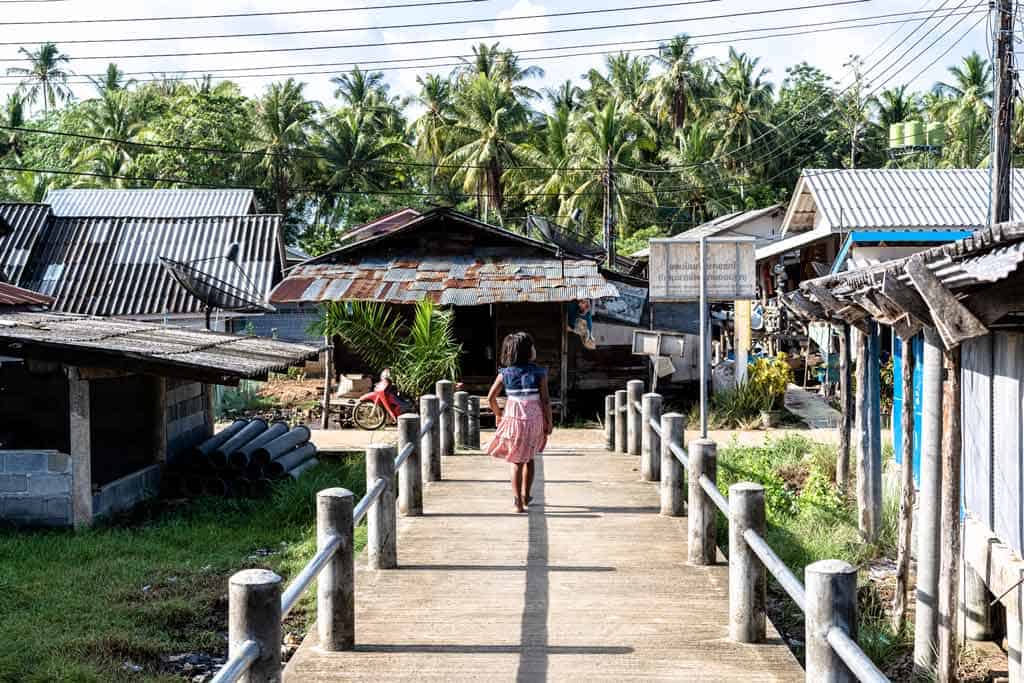
The Thai Government’s Own Initiatives
In recent years, the Thai government has seen the impacts of the tourism industry, both positive and negative, and has taken a firm stance to improve sustainability throughout the Kingdom.
It’s uplifting to see a government take what may seem like drastic measures to protect their own environment and local culture, and they have become an example to other Asian nations on how sustainable tourism can really be beneficial.
To read more about this, be sure to check out their dedicated website, 7 Greens .
Here are some examples of what they have done in recent years.
Every year the Department of National Parks, Wildlife and Plant Conservation takes extreme measures to protect the most heavily-visited regions of the country by closing them to tourists.
The biggest example of this when Thailand closed Maya Bay, the island close to Koh Phi Phi , which was made famous when featured in the movie The Beach.
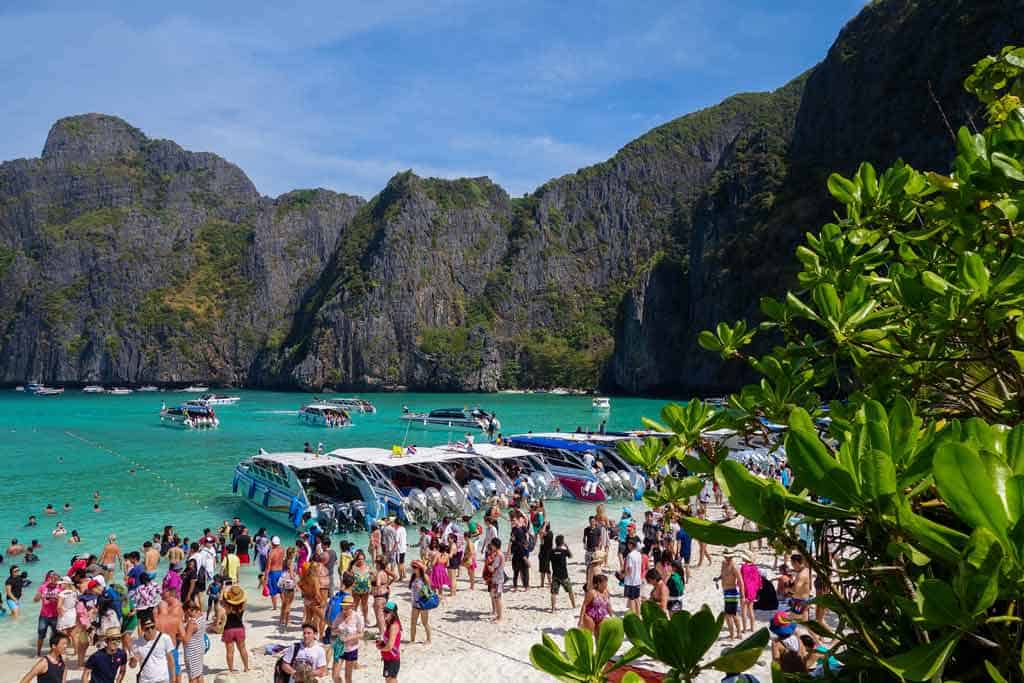
Over the years Maya Bay became a victim of its own beauty, with millions of tourists flocking into the narrow cove.
The huge numbers of people resulted in severe damage to the ecosystem, with marine life disappearing, waters becoming polluted and trash piling up.
The government closed access to the island in June 2018, citing the need for it to recover.
They are doing similar things to other popular destinations, often during the rainy season when the environment is at its most fragile, and are seeing excellent results.
On some of the most popular beaches in Thailand, the government has completely banned smoking.
They saw the damage cigarettes were doing, with tourists and locals leaving their butts on the ground, and the smoke causing health issues, and decided to remove the problem completely.
This ban is in effect in Phuket, Phang-nga, Krabi, Trang, Samui, Hua Hin, Cha-am, Chon Buri, Rayong and Trat.
The other big initiative that the Thai government and local businesses have introduced as of August 2018 is banning single-use plastics from all 154 national and regional parks around the country.
And in 2020 Thailand took it a step further by banning single-use plastic bags, with an aim to have these completely eradicated from all stores by 2021.
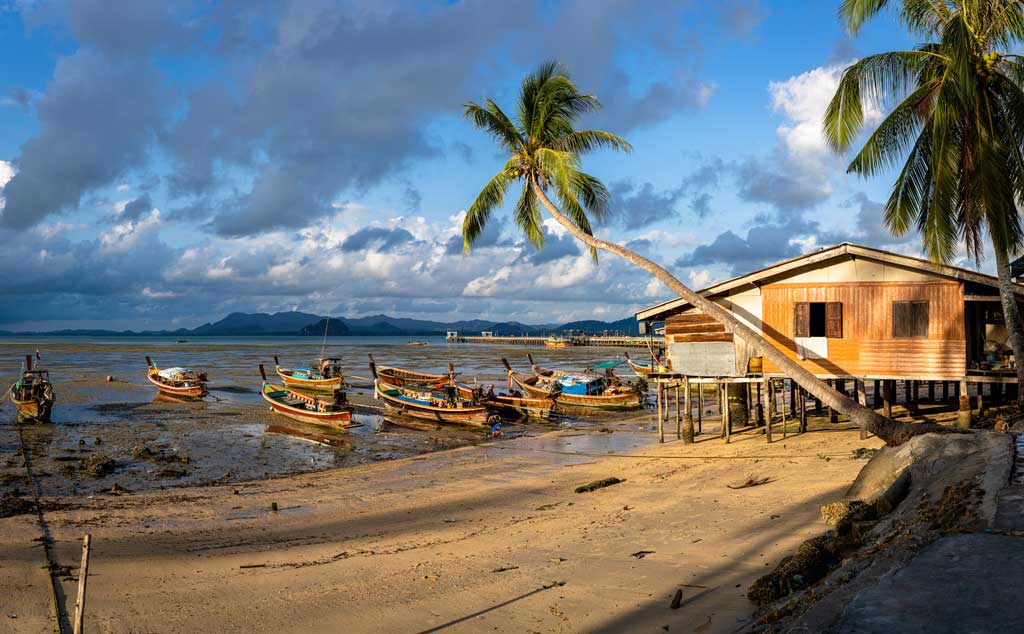
Ecotourism in Thailand
What is ecotourism? It is defined as: “tourism directed towards exotic, often threatened, natural environments, intended to support conservation efforts and observe wildlife.”
The concept of ecotourism in Thailand isn’t new, but it was always more of a niche offering compared to the typical resort-style travel that many visitors would do.
Today it is a different story though, and more and more businesses are incorporating ecotourism practices into their products.
You can find a variety of conservation projects in Thailand, focused on sustainable travel and environment and wildlife protection.
Environment Conservation Projects
Here are some of our favourite conservation projects focusing on sustainable travel and the environment:
Based on the spectacular island of Koh Tao, the New Heaven Reef Conservation , this organisation runs marine-specific courses and projects to protect and study the underwater world in the Gulf of Thailand.
Trash Hero is an initiative that has gone global but was started right in Bangkok.
According to their website, “TRASH HERO is an energetic, volunteer-led movement that drives change within communities around the world, motivating and supporting them to clean and prevent plastic waste.”
So next time you’re in Bangkok, get in touch with them and join the crew for a waste clean-up.
Wildlife Conservation Projects
We’ll go into the wildlife activities further below in the article, but there are some excellent wildlife conservation projects that you can support when practicing sustainable travel in Thailand.
By far the best elephant sanctuary and conservation project in Thailand, Elephant Nature Park has been committed to protecting elephants since 1998.
Founded in Chiang Mai by the incredible Thai lady, Lek, ENP now has a number of projects around the country, as well as in Cambodia and soon Myanmar.
You can visit Elephant Nature Park for a day, or even volunteer for up to a month.
The Soi Dog Foundation has made it their mission to protect the thousands of stray dogs that are found all over Thailand and to end the dog meat trade in Southeast Asia.
You can help out by donating to their cause, or volunteering when in Bangkok or Phuket.
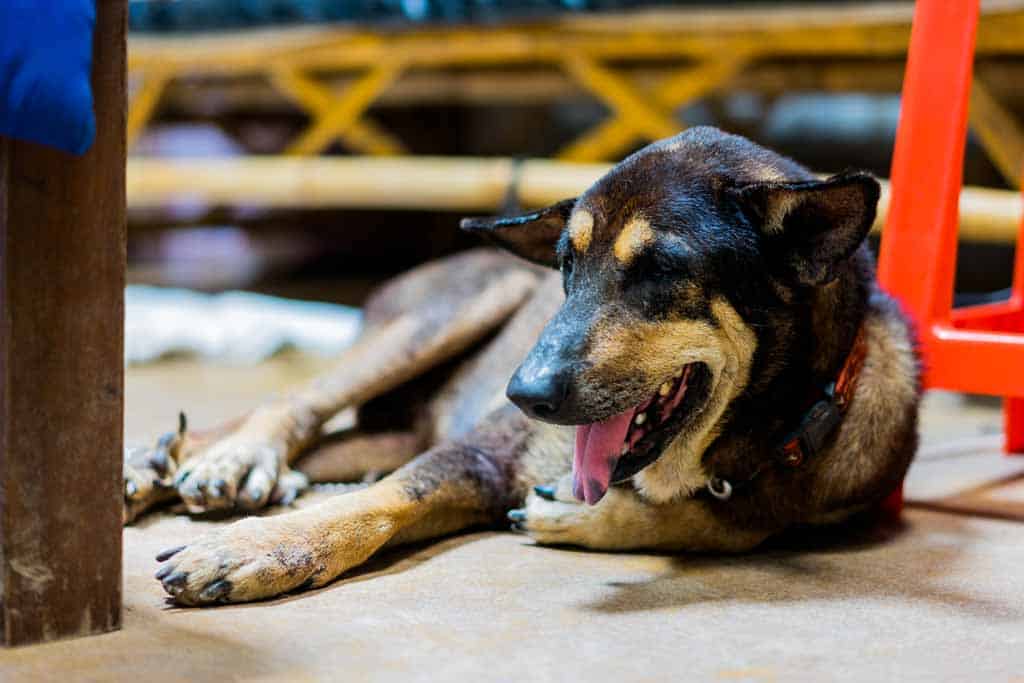
The Gibbon Project is a fantastic conservation initiative that can be found in the popular resort town of Phuket.
The project rescues and rehabilitates these gorgeous, yet endangered, monkeys and then reintroduces them into protected natural habitats.
You can visit their facility in Phuket if you book ahead.
Wildlife Activities
Thailand is home to several impressive wildlife species, which many tourists naturally want to see when they travel to the country.
In general, the best way to stay responsible when it comes to travelling in Thailand is to not take part in any activity that exploits wildlife.
Perhaps the main animal people would like to see in Thailand is an elephant.
These beautiful, intelligent, and enormous creatures live deep in the jungles of Thailand and have been a part of local culture for centuries.
But did you know there is an estimated 3800 captive elephants in Thailand, with perhaps less than 1000 in the wild ?
One popular activity is to ride an elephant in Thailand, however, this is actually a very irresponsible thing to do for several reasons.
- An elephant, while very strong, has not evolved to carry weight on its back.
- The process of ‘breaking’ an elephant in order for it to be safe around tourists is extremely distressing.
- Elephants used for riding are often overworked and malnourished in order to maximise their profit margin.
It is extremely important that you never ride an elephant, no matter how much you think it would be ‘fun’ or ‘cool’, and never visit an elephant show where they are forced to perform tricks.
Instead, it is much more wholesome to visit a reputable elephant sanctuary where the animals have been rescued and placed in a protected natural environment to live out their lives the way they were meant to.
Spending time around an elephant is an experience you will never forget, and is something you absolutely should do while visiting Thailand, but please do so in an ethical and responsible way.
We highly recommend the following sanctuaries:
- Elephant Nature Park in Chiang Mai
- Surin Project in Surin
- Elephant Haven in Kanchanaburi
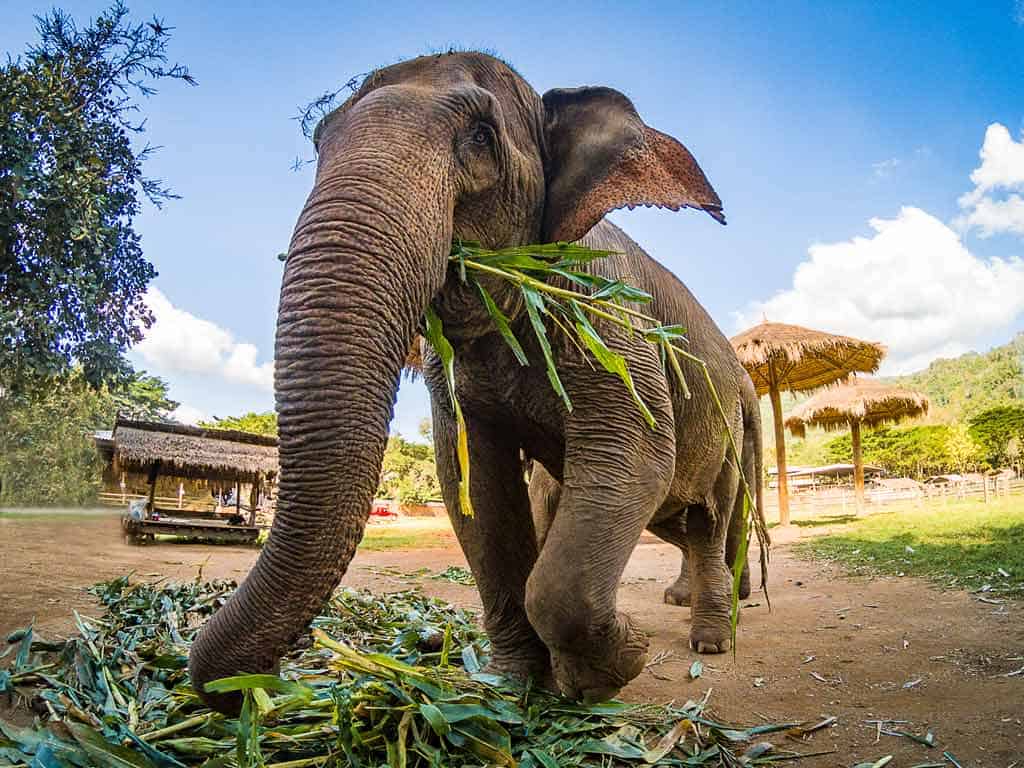
Another popular attraction for first-time visitors to Thailand are the ‘Tiger Temples’ that offer the chance to get up close and personal with a tiger.
As tempting as it is to get your selfie with a tiger, the truth is that what happens behind the scenes at these places doesn’t always have the tigers’ best interests at heart.
A tiger sanctuary in Kanchanaburi was raided in 2016 due to suspected trafficking and illegal breeding, and the Thai government ultimately seized all the animals that were on the property.
So where can you see a tiger in Thailand?
The World Wildlife Fund estimated that there are only 189 tigers in the wild , so unfortunately the chance of seeing one in the wild is very slim.
It’s not all bad news though. Tigers have recently been caught on tracking cameras in the far north of the country, showing that they are starting to make a comeback thanks to the Thai government’s restrictions on poaching and illegal logging.
There are currently no ethical tiger sanctuaries in Thailand.
There are five different types of monkeys in Thailand, and you will find them everywhere.
If you head to the south of the country they are extremely prominent around the islands, especially in places like Krabi.
Seeing them is always quite exciting, however, just like elephants, many macaques in Thailand have been captured and forced to perform tricks and shows for tourists.
Don’t support these shows, and instead hope to see some monkeys in the wild.
READ MORE: Be sure to read our comprehensive guide to travelling Thailand here .
Eco-friendly Accommodation in Thailand
Thailand has every style of accommodation you could ever imagine, from world-class 5-star resorts to basic bamboo shacks.
When it comes to choosing the level of luxury you want, the limit really is only your wallet.
However, on an eco level, the 5-star resort might be worse than the bamboo shack when it comes to looking after the environment.
This can be for a number of reasons, whether it is due to overtourism, large resorts not being able to control their environmental footprint properly, or putting an emphasis on profits.
And the larger the resort, the larger the impact. That’s why it’s important to look for eco-friendly accommodation when you practice sustainable travel in Thailand.
So what makes a hotel or guesthouse eco-friendly?
We wrote a dedicated post on how to choose sustainable accommodation here , but let us give the main pointers again.
This is what a hotel can do to try and focus more on sustainable travel:
- Limiting energy consumption
- Limiting water consumption
- Reducing waste production
- Using renewable energy
- Promoting environmental education
- Contributing profits to green charities
- Using recycled and locally-sourced products
It seems pretty straightforward, and in all likelihood, you’re probably doing a lot of these things in your own home as well.
But when it comes to the hotel industry, it’s easy to do what is known as ‘greenwashing’, where they claim to be eco-friendly by doing a few things like telling guests to watch their water use, but then don’t do anything else on their end.
We recommend you give the article above a good read to get a better idea of this, but for now let us showcase some of the best eco-friendly hotels in Thailand.
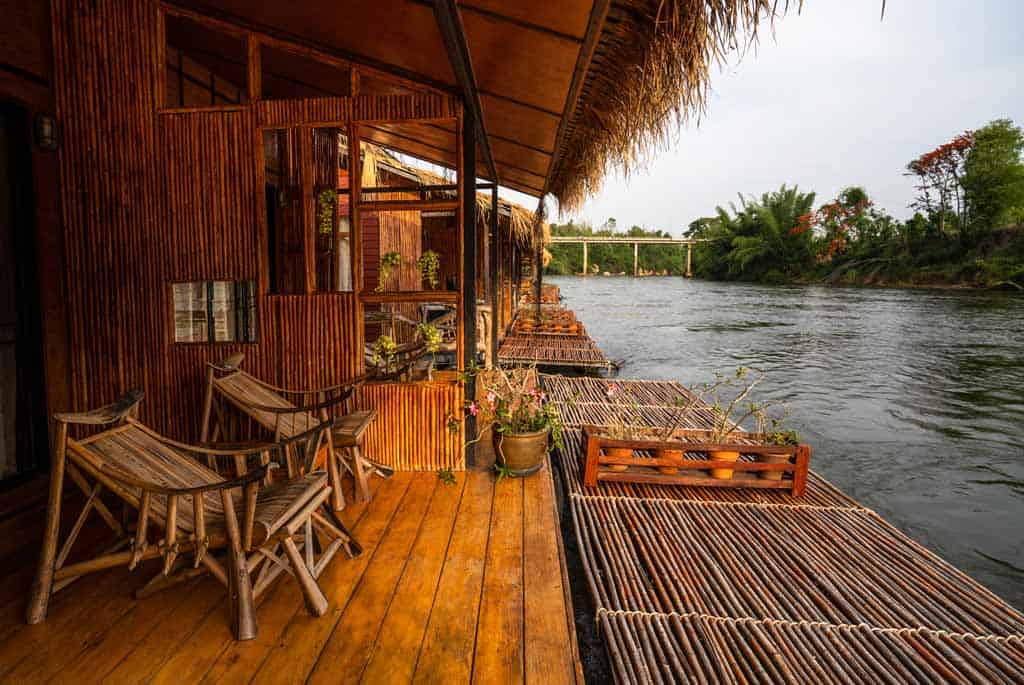
Located in a literal jungle deep in the urban jungle of Bangkok, the Bangkok Tree House is one example of an accommodation that is not only doing their part to protect the environment, but also providing a unique experience for their guests.
Their ‘nests’ live high in the canopy, and you’re sure to fall in love with what they have built.
Bangkok Tree House is also fully committed to being green, and they’ve minimised their carbon footprint in every way possible.
They also use vertical gardens to grow their food and vegetables, and recycle or reuse all of their materials.
The island of Koh Kood is the go-to destination for lovers of luxury, and the swaying palm trees over powder sand beaches is a real drawcard.
If you do visit, we recommend staying at the number 1 eco-resort on the island – Soneva Kiri .
This is the one place where you can splurge out for an unparalleled experience (each villa comes with private infinity pools and a personal butler), knowing that your money is supporting community-based tourism and protecting the environment.
Soneva Kiri puts their profits towards coral restoration projects and supporting local communities, raising close to $6 million for people in need.
They are also completely carbon neutural and a pillar of sustainable travel.
If you’re travelling on a budget but still want to do what you can to support sustainable travel and ecotourism in Thailand, it’s worth checking out Rabeang Pasak Treehouse Resort in Chiang Mai.
The property is made up of sustainably-built treehouses just outside of the city, set in a stunning forest landscape with a focus on minimising their footprint.
The eco friendly facilities are basic, but you’ll fall in love with the simple way of living surrounded by the sound of nature.
Culture and Customs – Respecting the Locals
You may feel that sustainable tourism is all about protecting the environment and wildlife, but there is another element that needs to be considered – the human element.
One of the big rewards of travelling the world is having the chance to learn about new cultures, and in Thailand, the culture is one of the most fascinating you can encounter.
The predominantly-Buddhist nation is built on the ethos of kindness, hospitality and respect, and as soon as you touch down here for the first time you’ll know exactly what we mean.
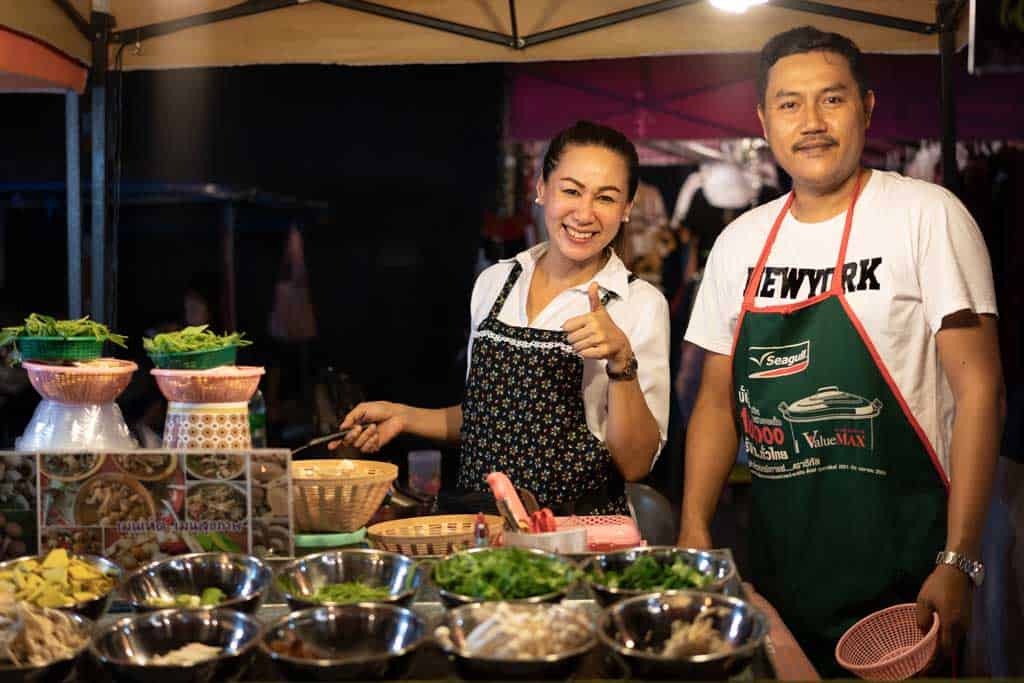
People bow (known as wai) to greet to each other with a warm “Sa wa dee”, and they finish each sentence with “ka” or “krup”, depending on whether they’re addressing a male or female, as a sign of courtesy and respect.
A visit to a Buddhist temple also gives a unique insight into the beliefs of the Thai people, and one of the best things you can do is simply sit and watch as they pray and make their offerings to get a better understanding into what Buddhism is about.
It’s important to open your heart and mind to these local customs when you travel to Thailand.
Things may be different to what you’re used to at home, but isn’t that the joy of travelling?
There are a number of unique customs that Thai people have that you should keep in mind and respect when visiting the country.
Here’s a breakdown of the most important ones.
The King of Thailand is the most revered person in the country, and Thai people love him dearly.
Do not show any disrespect towards him or the Royal Family (in fact it is against the law to do so) by talking negatively about them.
Anything with their likeness on it is also considered important, such as the local money that has the King’s portrait printed on it, so be careful not to cause any damage to this.
As an example, if you drop a note, do not step on it with your feet to stop it from blowing away, as this is considered disrespectful. Instead, pick it up with your hand.
When visiting a Buddhist temple, always face the Buddha and don’t turn your back towards him.
The proper way to exit a temple is to walk backwards to the door, turn at the last minute.
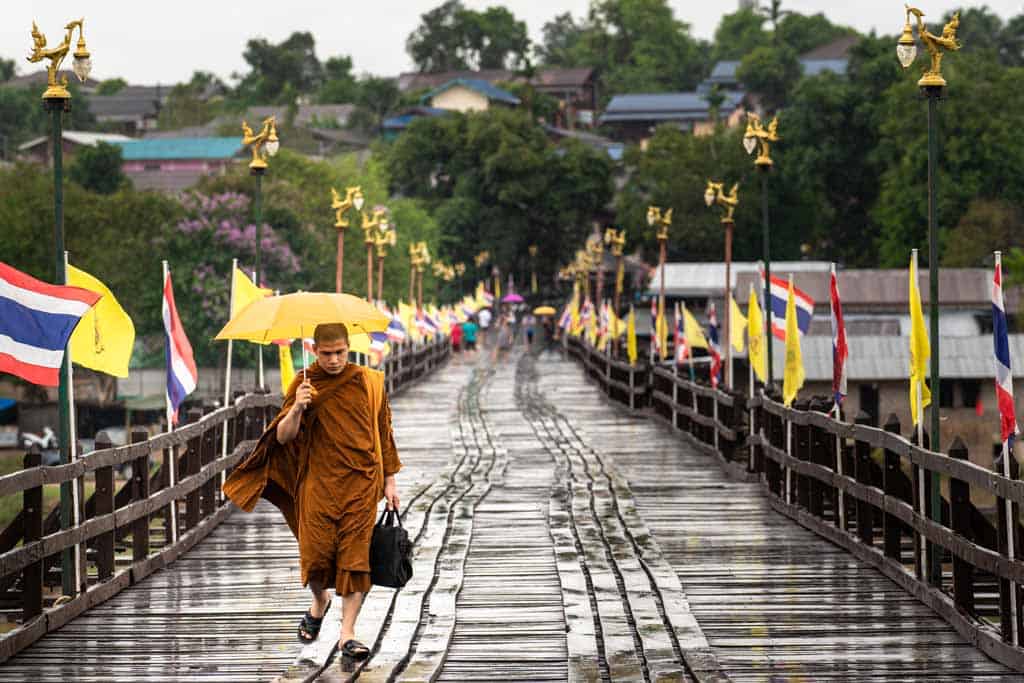
The feet, being the lowest part of the body, are considered to be dirty, and as such make sure you never point your feet towards somebody on purpose.
That is why Thais tend to sit on their feet or cross their legs, rather than sitting with their feet spread out in front of them – to make sure they don’t point them at another person, or Buddha.
The opposite of the feet, a person’s head is considered to be the most important part of the body, and it is disrespectful to touch somebody’s head.
When you see a Buddhist monk, whether it’s in a temple or out in public, always show respect to them.
Ways you can do this are to bow when they walk past, try to keep your head level below theirs (remember, it’s the most important part of the body), and giving up your seat for them.
Thai people are very modest and can be somewhat conservative. So you should make sure you always dress appropriately.
As an example, when you’re at the beach it’s ok to wear swimwear, but when you leave the beach make sure you cover up.
Do not wear a bikini or no shirt into a store or restaurant, and don’t walk around town showing excess skin, as this may make some locals feel uncomfortable.
As a good rule of thumb, look around at what the locals are wearing. If they’re not in a bikini, you shouldn’t be either, no matter how hot it is.
As an extension of dressing modestly, if you are entering a temple, make sure you wear appropriate clothing.
This includes covering your shoulders (ladies can usually get a sarong at the door to do so).
Thai people hate confrontation and raising your voice and yelling is one of the most disrespectful things you can do.
Even if you’re feeling frustrated at a lack of communication, or feel as though you may be getting taken advantage of in a transaction, keep your cool and speak in a normal tone.
You will achieve nothing by screaming at somebody, and you will lose all respect.
Always be polite, and the locals will be the same to you.
The Thai language is notoriously difficult to learn for English-speakers, and nobody expects you to become fluent in Thai during a holiday.
But locals will be very appreciative if you at least put a little bit of effort into speaking their own tongue.
Just pick up the basics, such as hello, thank you, how much, goodbye, and perhaps try to count to 10.
If you are shopping for souvenirs in a market, it’s normal to barter, but don’t go over the top and try to negotiate an extremely cheap price.
You might think it’s a game, but remember that the locals need to make a living too, and a few dollars here and there will help them out a lot more than it will you.
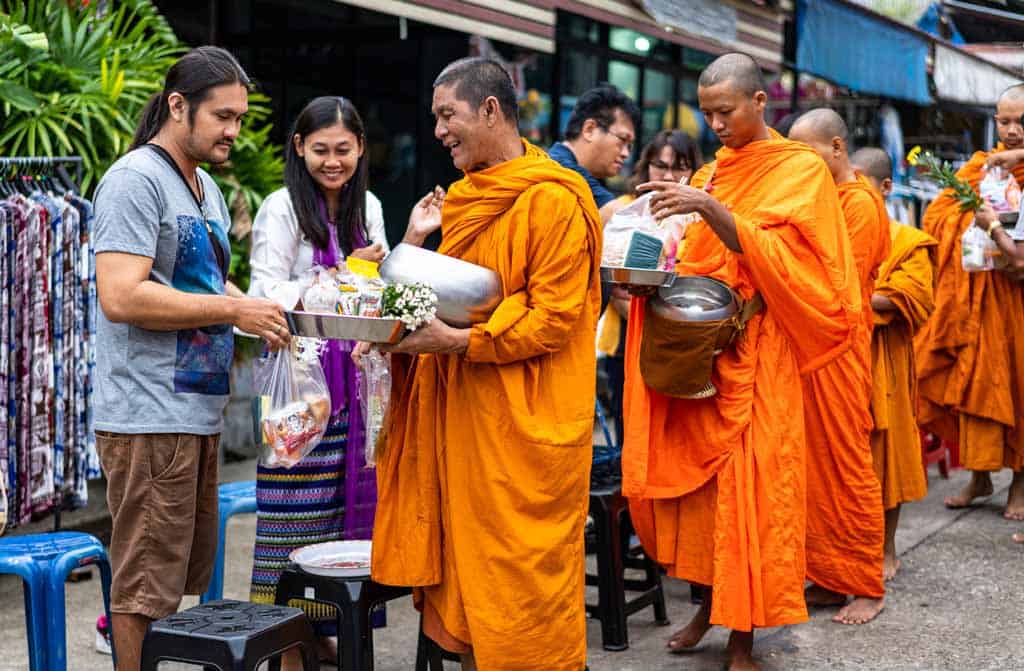
Unethical Attractions Involving People
On an ethical level, there are a number of tourist activities and attractions that exploit the wonderful local people of Thailand.
As a general rule of thumb, be very cautious about joining any cheap tour that involves a visit to a minority tribe, involves children, and sexual exploitation attractions such as the infamous Ping Pong Shows of Phuket and Bangkok.
These are some of the most important ones to avoid.
In the north of Thailand, the famous long-neck tribes from the Karen and Kayan ethnic minority communities have been a unique example of where a tradition has been exploited for tourist reasons.
Many travellers want to come to these remote villages to see the practice of women putting rings around their necks to elongate them.
But what few people realise is that this tradition causes extreme health problems.
In fact, many of these communities have expressed a desire to stop putting themselves through such a problematic modification of their bodies, but there is one reason to continue it – tourist dollars.
If it wasn’t for international tourists spending money to visit their tribes, they would stop the practice and return to their normal lives.
Another issue is that most of the money from these hill tribe tours don’t actually go to the local communities. Instead they are kept by the operators, and the villages make their money by trying to sell handicrafts.
Over the years the concept of ‘voluntourism’ has become popular for many visitors who wish to give back to the communities they are visiting.
While this is a noble idea, and for the most part people’s hearts are in the right place, there are issues with this type of tourism.
The biggest concern is when it comes to visiting orphanages.
Unfortunately there are several children who have been orphaned in Thailand, and it’s only normal to want to help them.
But unless you have experience with child care in these exact environments and are planning to stay for a long time, a day trip to an orphanage isn’t the best way to do this.
Instead the best way to help is to donate money and supplies through reputable charities.
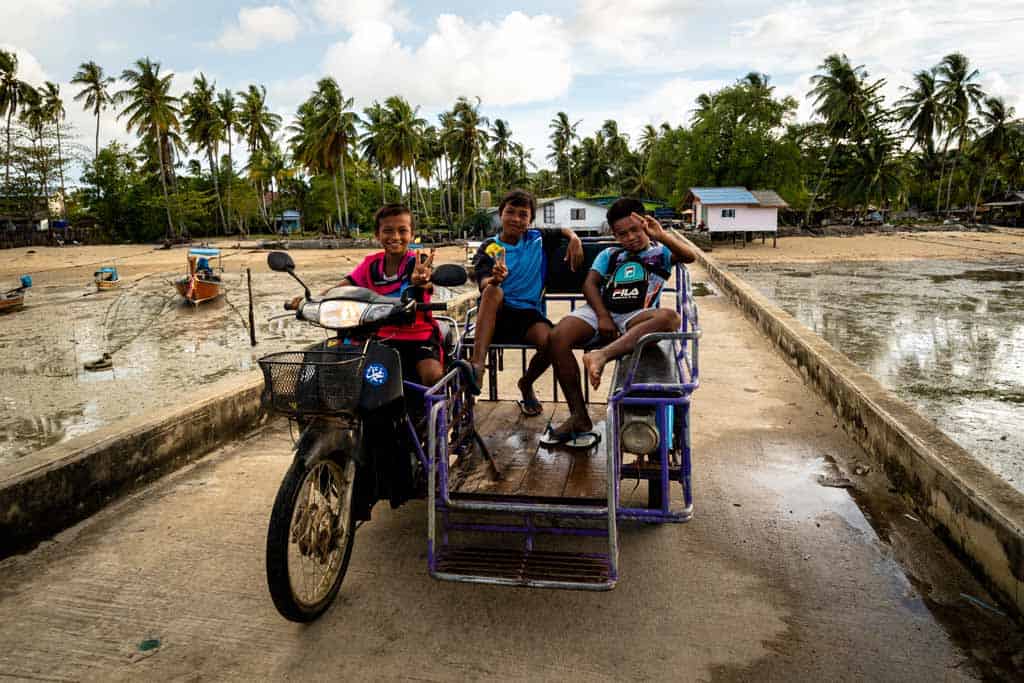
Protecting the Environment
Thailand really is one of the most beautiful countries in the world, and it has almost every type of landscape you could wish for.
When you decide to visit, it’s important to minimise your footprint and protect this spectacular environment.
Here are the best ways to do just that.
While Thailand is taking steps to remove all single-use plastics by 2021, you can do your part as well by bringing your own reusable items.
Make sure you add these to your Thailand packing list :
- A reusable water bottle. Not only can you usually refill these from large jugs at your accommodation, Thailand also has reverse osmosis machines on almost every city block so you can get drinking water for as low as 1THB per litre.
- A carry bag. Don’t take a plastic bag when you shop, and instead bring your own cloth one.
- Metal cutlery. You’ll most likely be eating a lot of delicious food on your trip, but don’t just always grab the plastic cutlery available. Throw your own in your bag and save on waste.
This one is pretty self-explanatory, but you’d be amazed at how many tourists we’ve personally seen throw their rubbish on the ground or off the side of a boat.
Under no circumstance should you ditch your rubbish anywhere but in a bin.
No matter how much of an inconvenience it is to carry until you find one, do not contribute to polluting the earth by being careless.
Carbon emissions from airplanes and vehicles are quite high around the world, but you can minimise your own carbon footprint in a few different ways.
First of all, don’t take any more flights than you absolutely have to. For example, rather than flying from Bangkok to Chiang Mai, why not take the train?
Second, always go for public transport where possible. Take a public ferry or songthaew instead of renting a private boat or car.
Third, and even better for the environment, walk or rent a bicycle to get around.
Take extra care when spending time in the stunning Andaman Sea and Gulf of Thailand.
Plastic and trash often end up in the oceans, killing marine life and polluting the sea for future generations.
Also try to avoid any overcrowding of popular destinations. The last thing we need is another Maya Bay catastrophe.
Another way you can protect the oceans is to never touch sea life or coral.
This includes standing on reefs when snorkelling or swimming, and not collecting souvenirs from the sea.
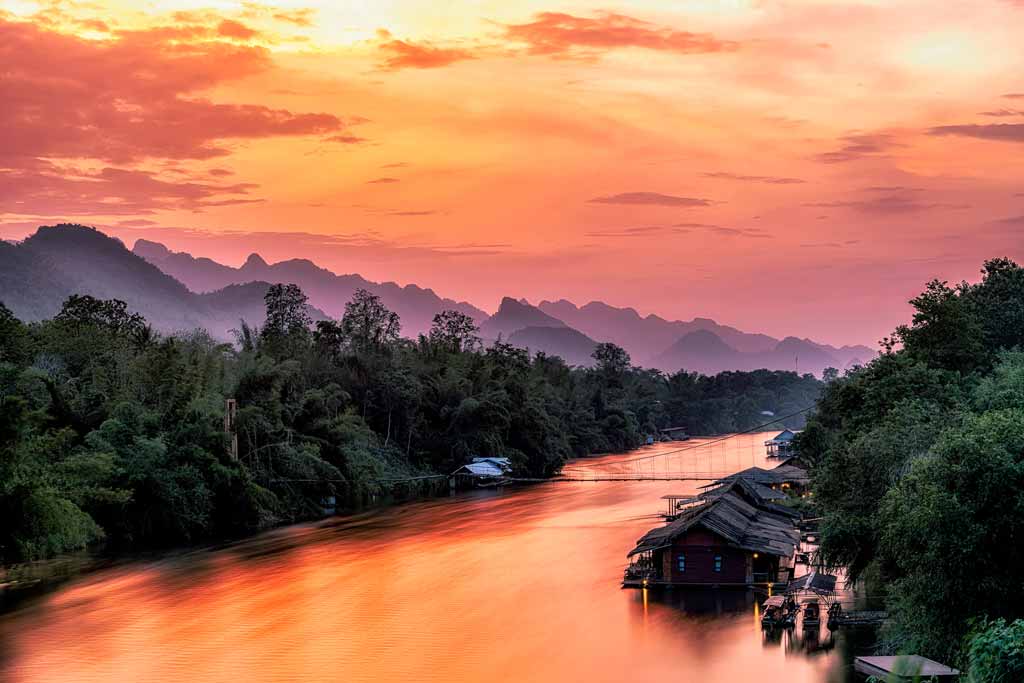
Avoiding Overtourism
Overtourism is when the amount of visitors a place receives reaches a level that is no longer sustainable from an environmental or societal viewpoint.
We’ve dived deeper into overtourism and ways you can combat this in this detailed guide , but we’d like to give some ideas here on how this applies specifically to Thailand. These tricks will help you navigate the tourism industry in a responsible way.
Rather than spending all your time in the most popular destinations in Thailand, consider visiting places that fewer tourists get to.
For example, Chiang Mai is absolutely incredible and definitely deserves a few days to explore, but when you’re finished here you can visit the lesser-visited Mae Hong Son.
Down in the south get out of Phuket and check out Trang or Koh Mook instead.
The benefits of getting off the beaten path is that you’ll have the chance to spend time in places that not as many international tourists see, and you’ll spread your tourist dollar to communities that really need it.
Finally in our sustainable tourism in Thailand guide, we will touch on the concept of local community based tourism.
Local community based tourism is where a visitor spends time in a local village and spends their money directly with vendors and small businesses rather than big operators or companies. Putting your energy and money into community based tourism rather than the big tourism industry is a great way to support the locals.
This simple mindset and action when travelling can have tremendous benefits for a local community and economy, and in a country like Thailand it is very easy to do.
Just like getting off the beaten path, we recommend you visit places that don’t see as many tourists and booking accommodation and activities directly with businesses.
You can spend the night in local guesthouses or eat at local restaurants to help inject your money directly into the local communities. There are many ways to try local community based tourism!
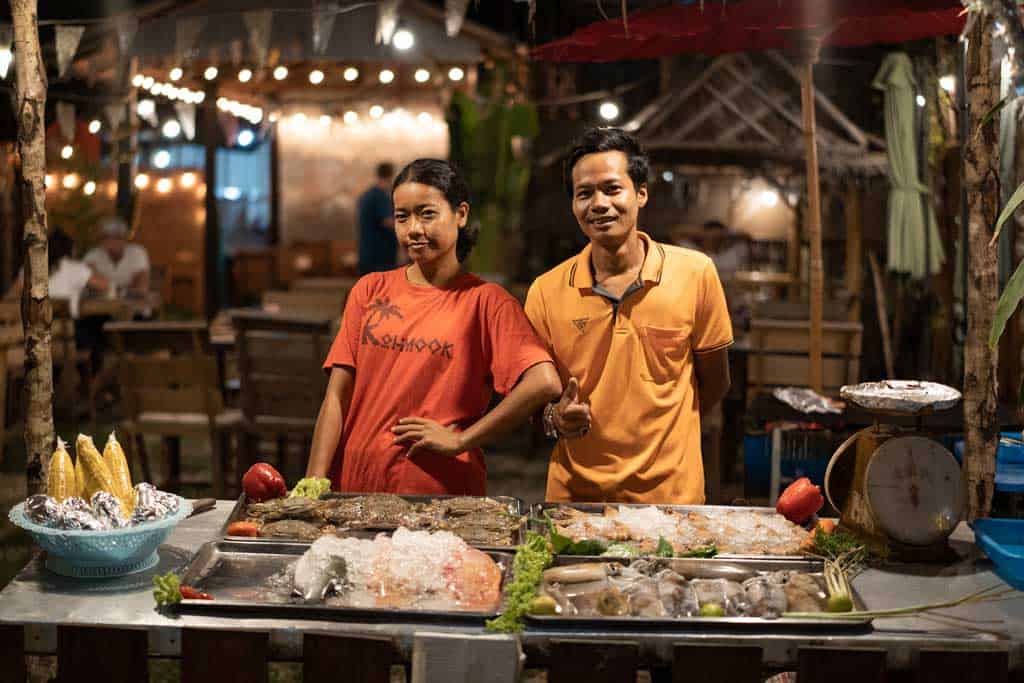
Alesha and Jarryd
Hi, We’re Alesha and Jarryd!

We’ve been traveling the world together since 2008, searching for the planet’s best destinations and adventures.
Love Travel?
Sign up for our free weekly newsletter for the best travel tips, ideas and deals!
We respect your privacy. Unsubscribe at any time.
READ MORE...
GoPro HERO 12 Review – Is it Worth Buying in 2024?
Surviving The World’s Most Dangerous Hike – Mt Huashan
10 BEST Things to Do in Ao Nang, Thailand [2024]
Related Posts
The nas backup workflow – how pros backup photos, the ultimate guide to hiking in new zealand (2024), the perfect tarkine drive itinerary in tasmania, we’ve joined the kathmandu family, 5 thoughts on “sustainable tourism in thailand – ecotourism, wildlife and culture guide”.
thank you for helping me with my school
You are welcome. So glad we could help. 🙂
Thank you so much!!!!!!!!!!!!!!!!!
I loved reading all your sustainable recommendations. I am planning to visit Thailand sometime next year, so this is super useful and informative! The elephant sanctuaries are on my list.
So glad you found the article helpful. It is so important to travel sustainably and know about the tours and the companies that you go with. Hope you have a great trip next year to Thailand. It is an amazing country. Definitely do your research on the elephant sanctuary. They can easily name themselves this but sometimes they are not a sanctuary. There is no one monitoring this in Thailand. Have a good one.
Leave a comment Cancel reply
Save my name, email, and website in this browser for the next time I comment.
Thailand Travel Stories
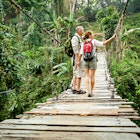
Dec 27, 2023 • 7 min read
From easy day strolls in Bangkok to treks in the jungle and a climb to the country's largest waterfall, here are the best hiking routes in Thailand.

Dec 21, 2023 • 9 min read
Get to know Thailand with this guide to the top things to do, from touring ancient ruins to swimming in the Andaman Sea.

Dec 21, 2023 • 6 min read
Thailand's beaches are dreamy for travelers with kids, but there is so much more to explore. Here are the best things to do as a family.

Dec 16, 2023 • 9 min read
Decide where to spend your time in Thailand with this guide to the best places to visit.

Nov 18, 2023 • 7 min read
These are the best beaches on Thailand's mainland and islands.

Nov 11, 2023 • 7 min read
Your transportation cheat sheet for getting around Asia's second most-visited country.

Oct 30, 2023 • 10 min read
Driving in Thailand is an adventure, but the rewards are massive. Visit backwater villages and outlying temple towns on these top road trips in Thailand.

Oct 28, 2023 • 7 min read
From packing to local etiquette when you're there, these top tips can help visitors plan the perfect trip to Thailand.

Oct 28, 2023 • 10 min read
Temple-tastic Thailand is one of the top traveler stops in Asia, and a trip here doesn’t have to cost the earth if you follow our smart travel tips.

Oct 16, 2023 • 6 min read
From commuter to long-haul, third-class seats to luxury cabins, wooden benches to sleepers, the following are some of the best train trips in Thailand.

Oct 3, 2023 • 14 min read
From family travelers to backpackers, our first-timer's guide to visiting Thailand has all you need to know to plan the perfect trip.
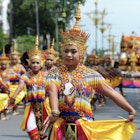
Sep 26, 2023 • 6 min read
There is much more to southern Thailand than Phuket, Krabi and the Phi Phi Islands. Here are lesser-known places to for discovering this exciting region.

Jan 13, 2023 • 3 min read
So many wonderful things to see around Bangkok, so little time. Enter Thailand expert Austin Bush, who recommends two of his favorite day trips.

Apr 8, 2022 • 6 min read
There’s more to this Thai New Year celebration than getting wet. Here’s how and where to celebrate Songkran in Thailand.

Feb 18, 2022 • 7 min read
Finding a perfect island escape in Thailand is easy. Here's how to choose between the idyllic gulf islands of Ko Samui, Ko Pha-Ngan and Ko Tao.

Feb 14, 2022 • 5 min read
Considering a trip to Chiang Rai? Here's everything a first-timer needs to know about the city, from how to get there to the best things to see and do.

Jan 21, 2022 • 9 min read
Before you book that elephant encounter in Thailand, read on to find out how to put Thailand's elephants' welfare first.
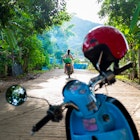
Dec 28, 2021 • 11 min read
Get an authentic taste of Thailand's northwest corner with this ultimate guide to driving the Mae Hong Son loop on a motorbike.

Nov 22, 2021 • 5 min read
Take the scenic route on these vivid journeys through the lush Thai countryside. Here are 3 you're going to love.

Sep 6, 2021 • 7 min read
Rich with wildlife, stunning landscapes and beautiful underwater scenery, Thailand's national parks are another major draw to this incredible country.

Sep 11, 2020 • 3 min read
With some destinations in Southeast Asia starting a phased reopening, Lonely Planet outlines when you can go, and what the restrictions are.

May 19, 2020 • 6 min read
Experience the tantalizing culture of Thailand from your very own living room with these virtual travel experiences you can do at home.
- Food & Drink
- What to pack
- City Guides
- Travel Hacks
- New Zealand
- North America
- Latin America
Copied to clipboard!
Sustainable Travel
Your guide to travelling sustainably through Thailand
By Sandeep Sandhu
Sandeep is a freelance writer from London and loves Alice Munro, eating his way through every country he visits, and terrible puns. He has spent extensive periods of time travelling across Europe and SE Asia, and has also lived in Central America.
Published on Apr 02, 2024
In partnership with Amazing Thailand
So, you’ve been bitten by the travel bug, but want to ensure your dream Southeast Asia vacation isn’t an environmental nightmare. Thankfully, there’s been a lot of improvement in this area over the past few years, and sustainable travel in Thailand is no longer something that requires immense planning. In fact, it can be achieved with relative ease.
A whole host of sustainable tour operators, responsible accommodation options, and pro-environment initiatives have popped up in the stunning nation over the past decade, driven by the local populace, government pressure, and a new breed of travellers who view sustainability as key to their plans.
Whether you want to see the highlights of Northern Thailand or explore the entire country with a Total Thailand tour , it’s now easier than ever to do so with a clean conscience. Check out below to see our guide to sustainable travel in Thailand!
Feeling inspired?
Thai Island Hopper West
A change in attitude from the thai government.
After The Beach came out, the Thai government famously restricted access to the location it had been filmed in, Maya Bay. This was because the tourist numbers were beginning to damage the surrounding natural ecosystem. The stunning spot is now partially reopened, but visitor volume is being kept in check.
The government has also introduced some other responsible initiatives in recent years, like the banning of single use plastic bags in supermarkets. While Thailand has a long way to go in this respect, the progress is welcomed.
Image source: Contiki
1. Make a difference before you’ve arrived
There’s plenty you can do to engage in sustainable travel in Thailand before you’ve even stepped foot into this beautiful nation.
One of the easiest and best is to ensure that your toiletries are made sustainably. This means using products with non-toxic ingredients, and no microplastics. You can also order items you need for your travels that arrive in recyclable or biodegradable packaging, instead of reams of plastic.
Another great idea is to pack some reusable food containers. Snacking during long journeys often can’t be avoided, but you can do so without having to use plastic carrier bags if you plan ahead. Items like beeswax food wrapping are space efficient and incredibly useful, while also being reusable and biodegradable.
One of the simplest and most common ways to pack sustainably is to ensure you have a reusable water bottle. Tap water isn’t drinkable in Thailand for the most part, and water in plastic bottles is incredibly cheap, so it’s easy to get into a cycle of simply buying a new one every time you head out. However, in tourist areas there will be a number of spots where you can fill up your bottle — vital under the scorching Thai sun!
If you really want to take it up a notch, tools like the Lifestraw will make it even easier to avoid buying plastic bottles. You can use this in conjunction with things like iodine tablets to safely drink tap water from almost everywhere in Thailand.
With that said, it’s still best to check, as some of the places you’ll visit on a Thai Island Hopper East trip will have such high heavy concentrations of metal in the water that filtered water is a must even with a tool like the Lifestraw.
10 most sustainable countries to visit right now
2. be proactive.
Sustainable travel in Thailand can be about much more than making sure you are making a minimal impact on the environment. In many ways, you can actually do something positive!
There are tons of volunteering options available in the Southeast Asian nation that can help you in this aim. You can donate your time to animal shelters in exchange for accommodation, or give your money to wildlife conservation areas that have sustainability at their heart.
It’s easy to make a difference outside the animal kingdom, too. Initiatives like Trash Hero (which began in Thailand) organise groups of rubbish collectors to clean areas of debris and other trash, once again allowing these spaces to breathe properly. Not only will you feel good, but it’s also a chance to meet locals and other travellers who have the same mindset as you when it comes to sustainable travel in Thailand.
3. Eat well but also right
As a food destination there are few countries better than Thailand, and that’s largely driven by its delicious street food culture. However, as of right now, single-use plastics are the go-to when it comes to serving customers – so be mindful of this.
Some of this can be abated by being proactive and bringing your own containers and utensils to stalls, but that can be unwieldy and leave a mess in your bag. It’s best to look for street food stalls that use wooden utensils, and biodegradable paper or rewashable plates. However, that’s easier said than done.
Really, the best way to enjoy the glorious Thai food culture while also ensuring your environmental impact is kept to a minimum is to visit local restaurants. Many of the best sit-down spots offer incredible value, so you won’t be losing out from a budgetary perspective, and you can also bask in your post-meal satisfaction without any of the guilt that comes from utilising single-use plastics.
Northern Thai Highlights
4. stay in accommodation that puts sustainability at the heart of everything it does.
Whether you want to stay in a wooden hut or a luxury hotel, you’ll be able to in Thailand. The wealth of accommodation choices available is one of the reasons the country is such a popular destination, but among the numerous options there are some that are perfect for those looking to engage in sustainable travel in the country.
Sustainable accommodation isn’t limited to one price point, either. You can have cheap hostels that aren’t so good for the environment, and 5-star spots that would receive approval from Greta Thunberg. So, no matter your budget, you will be able to find something. There are a few factors to look out for. The World Travel Awards and organisations like Green Tourism are reputable in terms of certifying whether or not a hotel or hostel is really sustainable.
On a more practical note, you can see if your accommodation limits unnecessary energy consumption (turning air conditioning off in empty rooms, having a lights out policy after a certain time, and similar rules), as well as their water consumption.
Hotels and hostels which offer recycling services are also a great choice, as are those that get some of their power from renewable sources. Bangkok gets nearly 4,000 hours of sun a year on average, making it an excellent place for solar panels.
You can also see how directly your accommodation is promoting environmental education. This may be by something as simple as explaining why they limit their consumption, or by something more practical like offering tours and activities that focus on sustainability. They may also donate to local green charities and use recycled or locally sourced products, both of which are vital parts of sustainable travel in Thailand.
5. Keep your wildlife tourism wild
Thailand is home to hundreds of unique animal species that many people dream of having a chance of seeing, from elephants to tigers to monkeys. However, this means that many so-called sanctuaries up and down the country engage in unethical and harmful practices, including whipping and drugging animals.
Thankfully, there’s a new wave of responsible wildlife attractions that put animal rights at the heart of what they do. Respect for the natural world goes hand in hand with sustainable travel in Thailand, so make sure that if you do go and see some incredible creatures, you’re doing so in a place they’re treated well.
Elephant sanctuaries are a big business in the country, and with some research you can ensure your once-in-a-lifetime chance to see these majestic animals is done so at a venue that treats them well. Although there are a few things to look out for, if the elephants roam free and don’t give rides, that’s a good start. Luckily, travelling with Contiki makes it easy to ensure you’re always engaging with wildlife responsibly because we only partner with rescues that truly care.
One experience that is never ethical is sitting close to and stroking a tiger. Either it’s a cub that’s had its mother taken away, or it has been heavily sedated so that it doesn’t attack. There are rescue centres that take in the big cats, and you may be able to get a glimpse of them from behind security glass, but that’s about it. And, given that tigers are cold-blooded killing machines when they’re not doped up, that’s for the best.
10 ethical animal experiences that enjoy wildlife responsibly
6. take your time to get around.
Look: we know Thailand is massive, and that trips often come with a hard time limit. The temptation to fly up and down the country so you can see all of it is very strong, but as far as sustainable travel in Thailand goes, it’s not a great practice.
The best thing to do in this situation is to see the journey as being just as important as the destination, and thankfully Thailand’s natural beauty makes that easier than ever. The country is connected by train, ferry, and coach, and these transport options often go through some absolutely heavenly scenescapes.
Inter-country travel also benefits from these land connections, so you can have an Asian Adventure without flying. And that’s not mentioning the fact that many of these routes are experiences in themselves, like the famous slow boat from Thailand to Laos that goes down the Mekong Delta .
Additionally, in Bangkok there is an astoundingly cheap, clean, and efficient public transport system, so you can easily get around the big city without having to take cars or tuktuks. Electric tuktuks are becoming more and more popular in Bangkok these days! Not only will you be contributing to a culture of sustainable travel in Thailand, but you’ll also get a better feel for the city, enhancing the authenticity of your experience.
10 best islands in Thailand you need to visit
28 interesting facts about thailand, want to encounter elephants ethically visit phuket with contiki, stop dreaming and make sh*t happen.

1 country, 9 days
Thai Island Hopper East
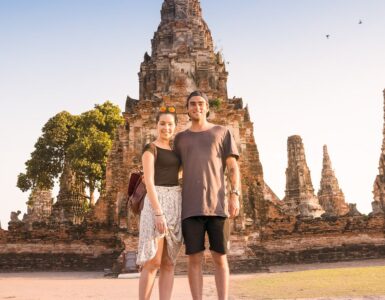
1 country, 8 days

1 country, 14 days
Total Thailand
- Work With Us
- Blogging Bootcamp

- Van Conversion Academy
- Campervan Shop
- Campervan Rentals
- Plan a Trip
- Itineraries
- Destinations
- Responsible Travel
- Family Travel
- Budget Travel
- Scuba Diving
- Travel Credit Cards
- Digital Nomad
- Teach English Abroad
- Blogging Resources
- Income Reports
- Travel Shop
- Meet Katie & Ben
- About Two Wandering Soles
- Personal Stuff
- Portfolio & Press
How to Travel Sustainably in Thailand and Why You Should Care
Home » Blog » Thailand » How to Travel Sustainably in Thailand and Why You Should Care
Tourism has affected Thailand in so many ways, and there are many issues you’ll be shocked to learn about. As tourism in Thailand continues to skyrocket, it’s more important than ever to support ecotourism and travel sustainably. We’ve put together out best tips so you can travel more responsibly in Thailand.
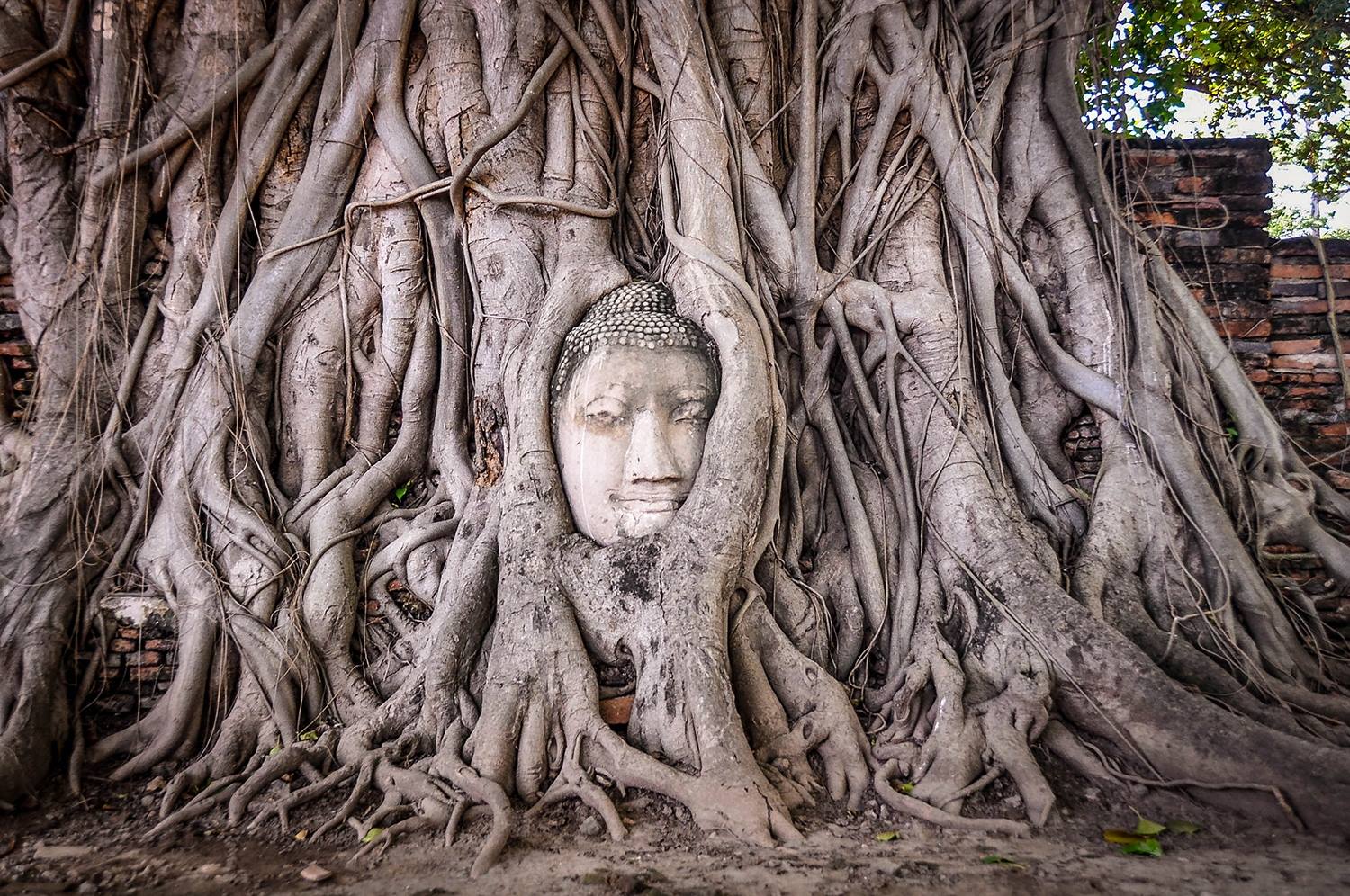
We have spent a lot of time traveling around Thailand and while we seriously love this country, there are many things that make us cringe.
I’m going to give it to you straight:
Tourism has had many negative effects on Thailand.
Animals are exploited of for the benefit of tourists and pristine environments have been compromised. Communities have been taken advantage of in the name of tourism and the nation faces water and air pollution.
As a traveler in Thailand you are contributing to these issues, whether you are aware or not. We, too, are guilty and have made mistakes.
But the good news is there are several things you can do to lessen your impact on your travels in Thailand.
Before hopping on a plane, read this article and educate yourself on the ways you can travel better.
1. Eat less seafood in Thailand
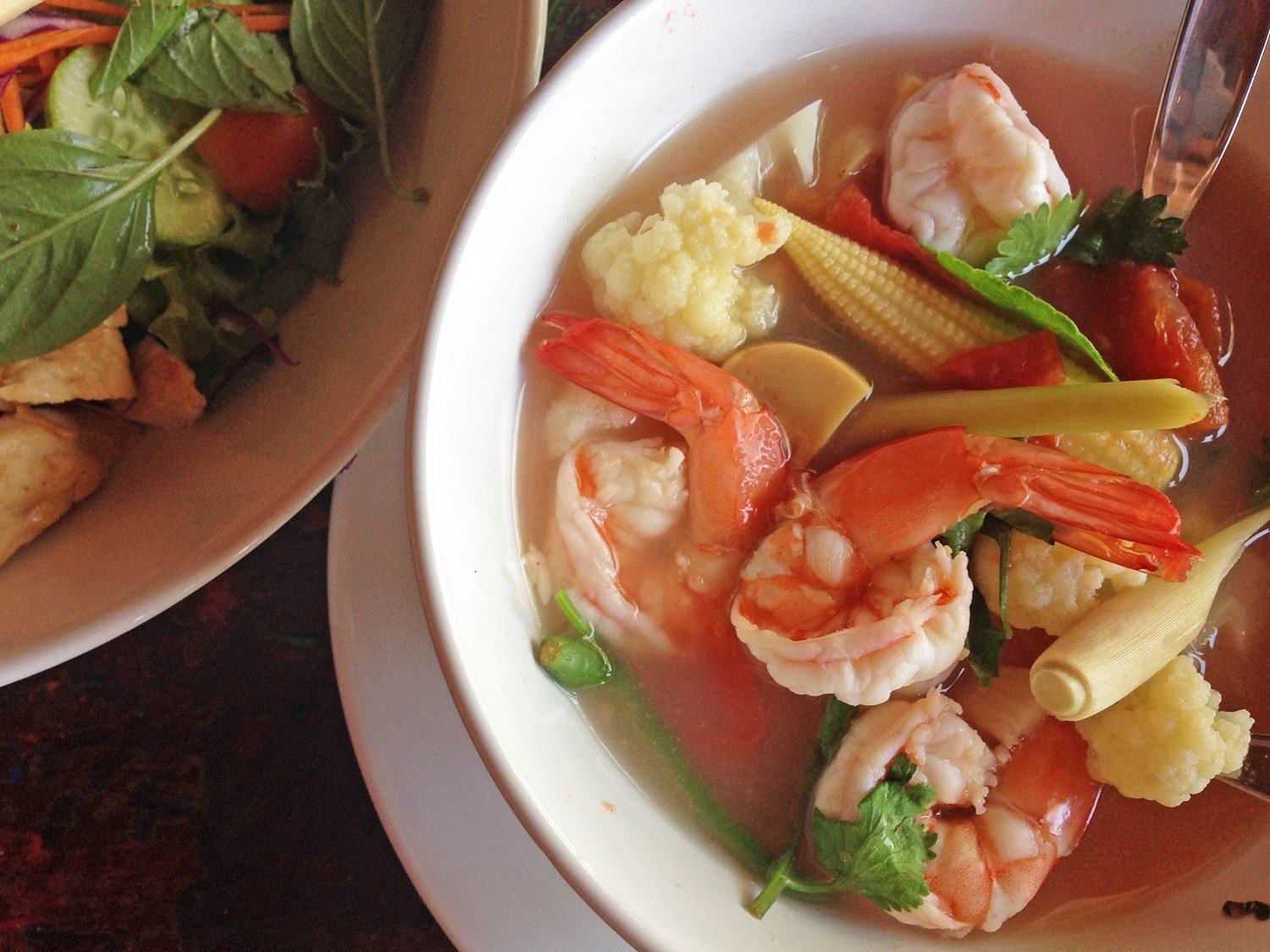
You may be dreaming of Pad Thai with shrimp ( pad thai goong ), a fresh grilled fish or Green Curry with seafood ( kaeng khiao wan goong ), and I don’t blame you — they’re delicious. But here’s something you may not know: Much of the seafood in Thailand is unethically sourced.
Two of the issues with seafood in Thailand are:
Overfishing: The seas around Thailand have been drastically overfished. Some of the time, the methods used to fish can destroy the surrounding environment. For example, one method employed is to send electronic pulses into the water, which kills the fish in an area and sends them to the surface. This means many fish that aren’t even eaten are killed.
Slave Labor: Thailand’s seafood industry has been exposed by human rights organizations for practicing forced labor and human trafficking . Back in 2014, migrant workers revealed that they had been enslaved, forced to work 20-hour shifts, were tortured and witnessed execution-style killings. The government claims to be cracking down on this issue, but according to some sources , many of these human rights violations are still happening.
Remember as a consumer, you are creating a demand. When there is demand for shrimp, for example, these methods will still be employed. Only when consumers refuse a product will things change.
I’m not going to pretend that we’re perfect. While living in Chiang Mai , we refrained from eating seafood (except for the few times we had sushi).
However, while traveling in the Thai islands , we ate a few dishes with prawns and had fish two times. But we consciously ate less than we normally would. We also try to eat seafood only from restaurants that have “sustainable fishing practices”. Baby steps, I know, but it is something.
What you can do:
Eat less seafood. Instead of ordering shrimp at every meal, cut back and make it special. Or avoid it altogether.
Support restaurants that advertise sustainable fishing practices.
Planning a trip to Thailand? Find out the best time to visit based on regional weather and events you don’t want to miss!
2. Be careful with Elephant “Sanctuaries”

Just about everyone that visits Thailand wants to see elephants. And I understand: They are beautiful, gentle creatures, and most of us have never had the opportunity to get close to them.
It is becoming more well-known that riding elephants is incredibly harmful to the animals, and less and less people are participating in this practice while in Thailand, which is wonderful. Instead, many people are now choosing to visit elephant sanctuaries while in Thailand.
The problem is this: Some businessmen and women have taken note of this demand, and have transitioned their elephant camps to “sanctuaries” in pursuit of money without really changing the way the elephants are treated.
Don’t go elephant riding. At all. Period. If you want to know more about this issue, read this article from BBC or PETA or The Independent . Heck, a quick Google search will give you more horrifying information than you’d ever want to know…
Do your own research of elephant sanctuaries. Check out reviews and read up on their practices. If they are vague, that can be a good indicator that they aren’t truly a sanctuary.
Book your elephant experience in advance. The good sanctuaries only allow a small number of visitors per day and they fill up fast. If you wait, you risk having to book with whatever is available. Which won’t be a good option.
Share YOUR experience. If you noticed bad things happening at the “sanctuary” you visited, write a review or email the organization. Mistakes happen, and you may have unintentionally supported a company that is more concerned about money than the animals’ wellbeing. The only way this is going to change is if you share this experience so others can choose whether or not they want to support it.
More information on Animal Tourism: Elephants aren’t the only animals being mistreated. While traveling in Thailand, you’ll likely see signs advertising places to pet tigers and watch monkeys jump through rings of fire. Our advice is to avoid animal encounters in Thailand unless it is a true sanctuary or rehabilitation center.
3. Think before visiting Hill Tribes
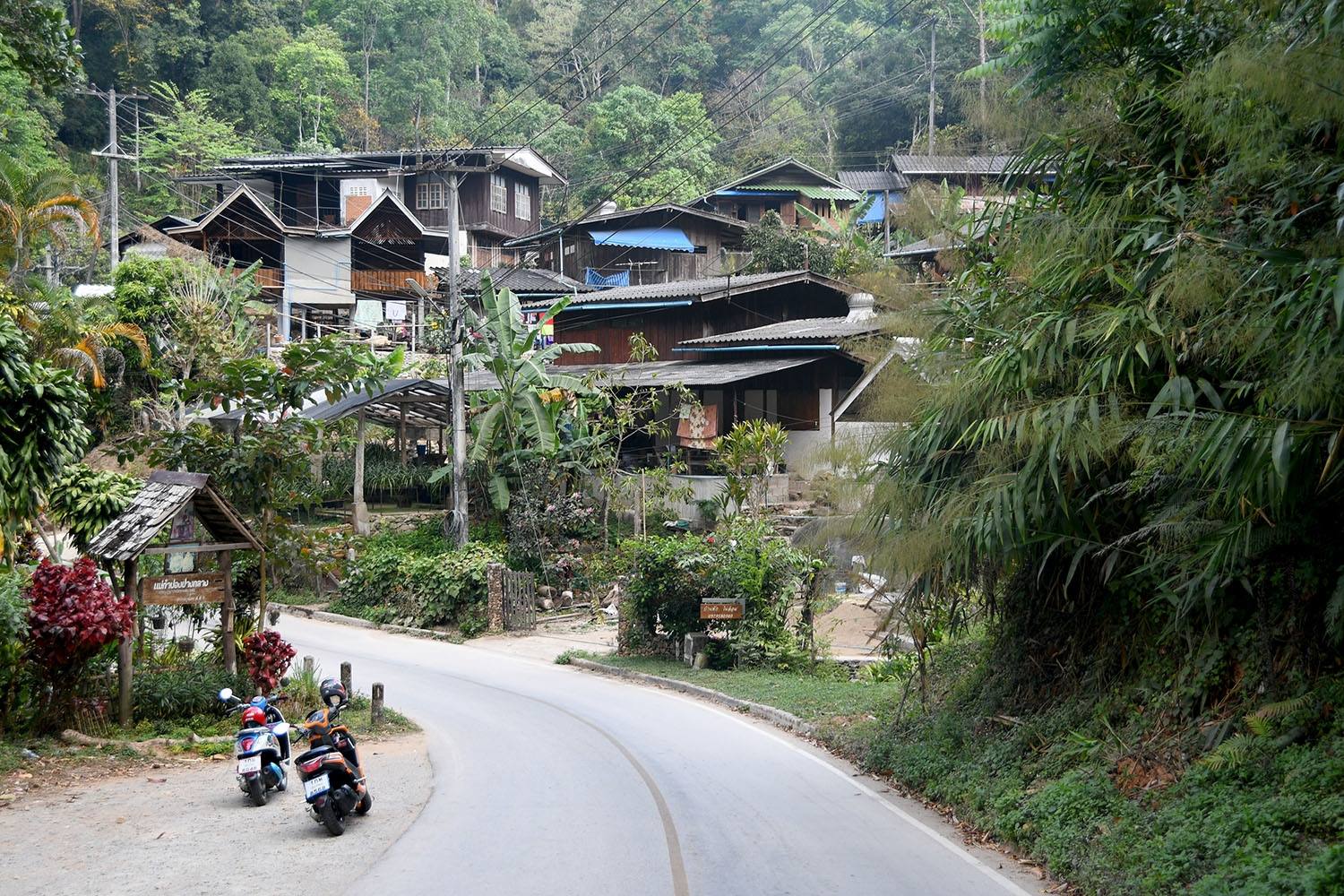
I get it — visiting hill tribes has a certain appeal, as it is an opportunity to experience a culture drastically different than your own. There are numerous tour operators in Chiang Mai , Pai and other parts of northern Thailand that sell packages that promise “up-close visits with long neck people”.
We have some ethical concerns about this type of tourism, and it just never felt right or authentic to us. For that reason have opted not to visit the hill tribes on a tour.
But that doesn’t mean it’s wrong or bad to visit.
Do your own research on this issue and make an informed decision. This article has an interesting perspective on hill tribes in Thailand and what it’s like to visit as a tourist.
If you want to experience small villages, consider hiking or driving a motorbike through the countryside. Stop in a village and support the locals by getting lunch, buying a coffee or purchasing a handicraft.
If you do choose to visit a hill tribe with a tour, be sure to choose a reputable company.
4. Avoid sex tourism
Unfortunately, Thailand is well-known for its sex tourism industry. Just watch the Hangover II and you’ll know what I’m talking about.
Know that some of the women (and men) who work in the sex industry are not working voluntarily. Visiting a ping pong show is likely supporting the sex tourism industry.
I’ll be honest: During my first visit to Thailand (back in 2011) a couple friends and I went to a ping pong show. I naively thought it would be similar to visiting a Strip Club in Vegas. I later learned that these shows are often intertwined in sex trafficking, and I am deeply embarrassed that I inadvertently supported this industry.
Instead of seeing a ping pong show, consider going to a cabaret/burlesque show.
Don’t support prostitution. Duh. This is especially common in some districts of Bangkok, Chiang Mai and Phuket.
5. Say No to Plastic
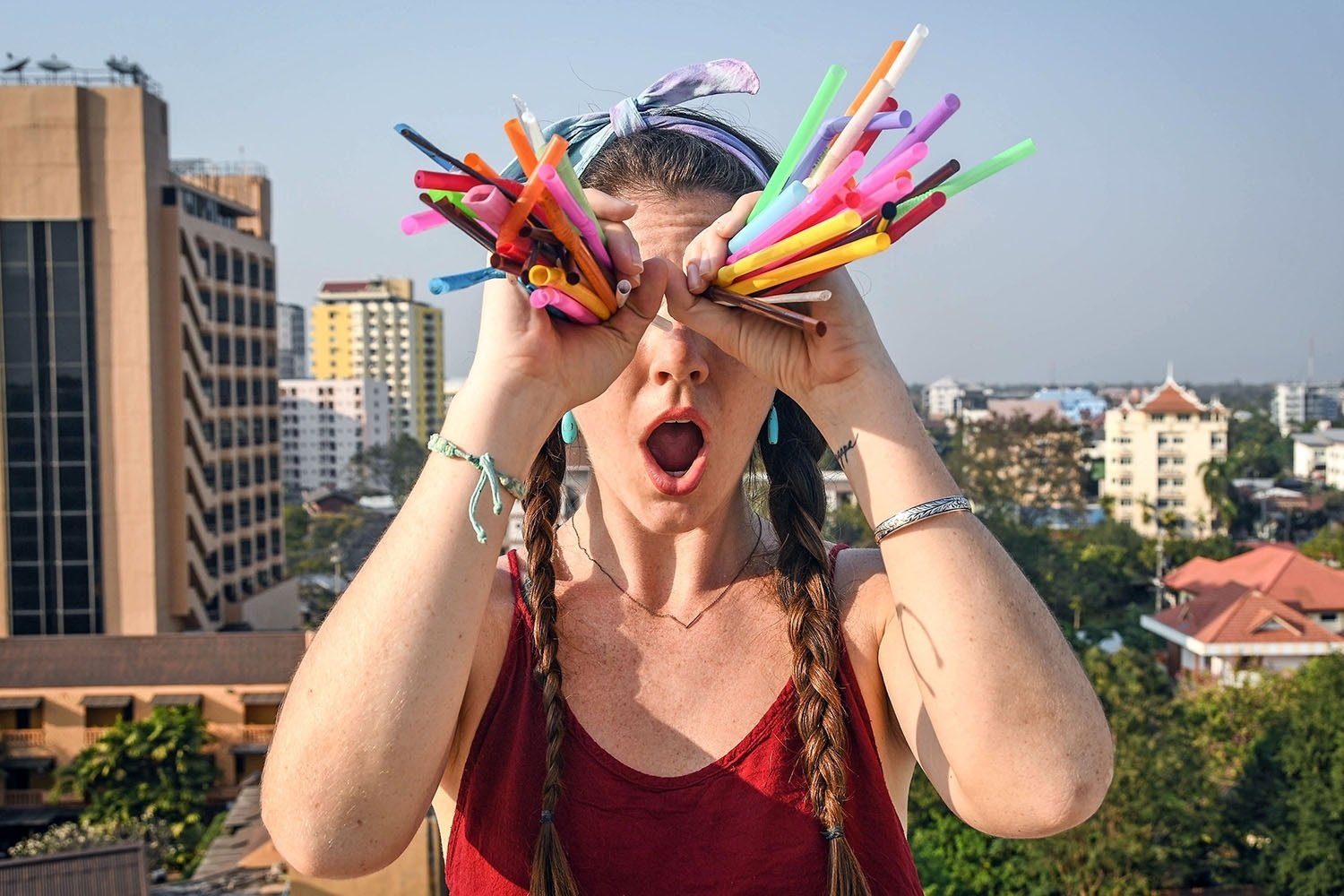
You are probably somewhat aware that plastic consumption in Southeast Asia is seriously out of control. Purchase one item at 7-Eleven, no matter how small, and it is placed in a plastic bag.
And even worse, order a drink from a street stand and it will come in a plastic cup with a plastic lid and have a plastic straw. Then, a plastic handle is attached and it is placed inside a plastic bag. That is 5 pieces of plastic for one fricken’ Thai iced tea. Ridiculous!
Start getting the the habit of saying no to plastic. And before you roll your eyes and say, “I’ll just recycle it,” hear me out.
Frankly, it is difficult to recycle in Thailand. Many cities don’t have the infrastructure easily accessible, and quite honestly, many travelers just don’t recycle when they’re vacationing.
In a recent study from Explore , a U.K.-based adventure travel tour operator, they found that only 37% of British travelers recycle when on vacation whereas 77% of them recycle when they’re at home.
Yes, recycling is a wonderful thing and it’s great to do it as often as possible. But it’s even better to just pass on plastic so you, like all those Brits in Explore’s study, aren’t tempted to toss a plastic bottle in the trash because you can’t find a recycling bin.
In their study, Explore noticed people often don’t follow the same environmentally-conscious practices they do when at home. In an effort to educate and encourage people to travel more responsibly, Explore created a 2018 Travel Pledge to be an example and resource for the tourism industry.
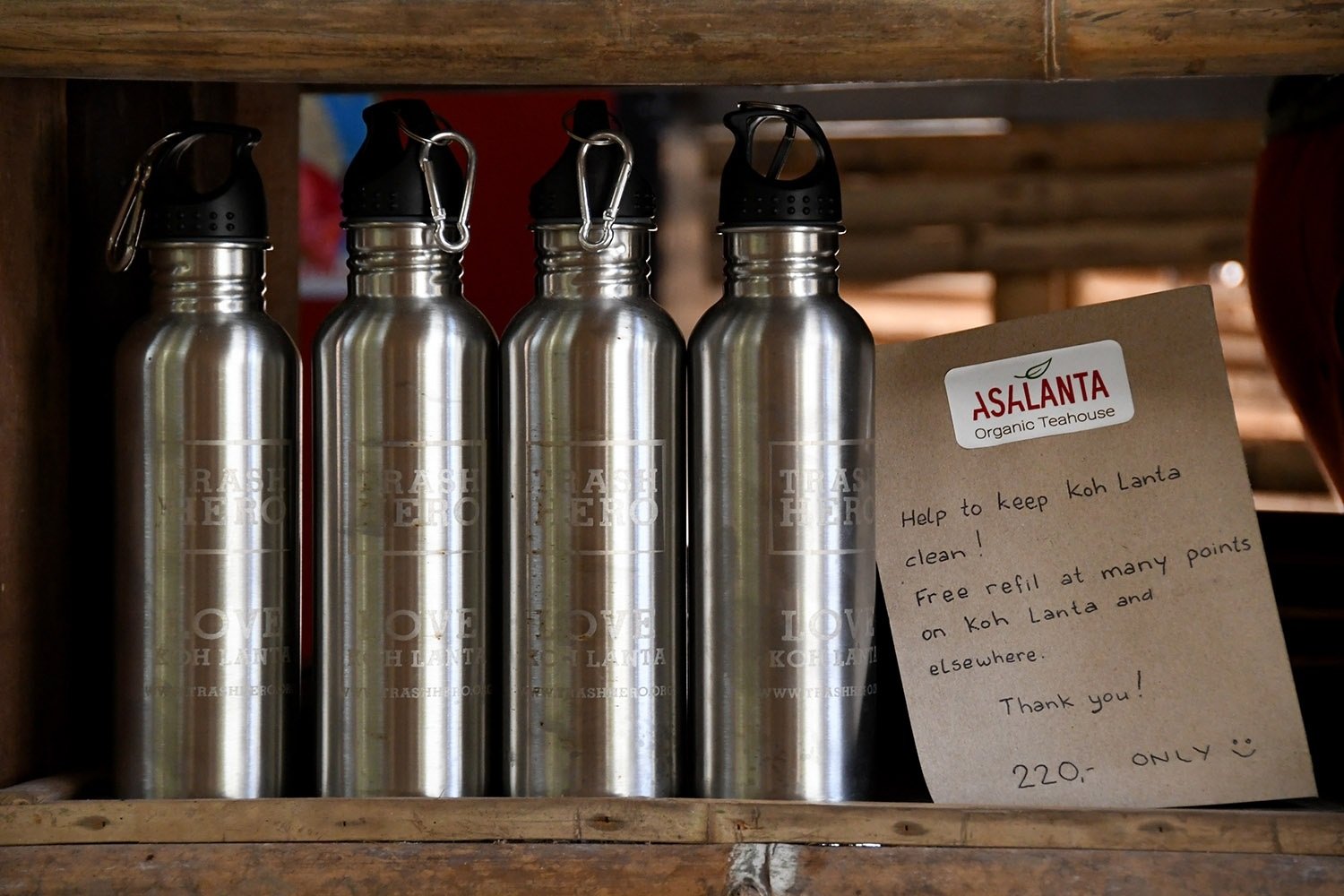
The best way to avoid plastic consumption is to be prepared:
Bring your own reusable bag (There are tons on the market but we love this one from Tree Tribe because it stuffs up super small, is made with recycled materials and 10 trees are planted with your purchase)
Carry a reusable straw and memorize this phrase (you will definitely need it!):
If you’re a woman: “ mai ao lawd ka ” = I don’t want straw, please.
If you’re a man: “ mai ao lawd kap ” = I don’t want straw, please.
Travel with a water bottle and refill it when possible. Many hotels have a large jug you can use. You can also find refill stations on the streets that are very cheap. We’ve also used our Steripen in Thailand to sterilize water from the tap to make it safe from drinking. And when you have no other options, buy the big 5-liter jugs of water from the convenience store to refill your bottle instead of those tiny 16-ounce ones. Not only will you save plastic, but it’s cheaper too!
If you do get plastic on vacation, please go out of your way to recycle it properly.
Read More: Eco Friendly Travel Gear – this packing list will help you travel more sustainably!
6. Be responsible at Full Moon Parties

We’re not going to sit here and preach that you shouldn’t participate in a Full Moon Party. We did it once, and we had fun.
But, I will say this:
Full Moon Parties in the Thai islands are responsible for an incredible amount of waste. Like, a disgusting amount.
We woke up the day after the party and walked along the beach to find all sorts of stuff — straws, water bottles, Styrofoam, shoes, condoms — floating in the ocean.
If you choose to take part in the debauchery (we’re not judging; it can be fun once in a lifetime experience), be conscious about your own waste. There’s not much you can do about anyone else in their varied states of inebriation, but you can take responsibility for your own actions.
Throw rubbish in the bins instead of on the ground. Duh.
Carry your own reusable straw and refuse the plastic ones in buckets (they often put a handful of dirty straws in one bucket!).
Participate in a beach cleanup the morning after. Doesn’t sound all that glamorous, but it can be eye-opening and will prevent some of the waste from reaching those fishies and beautiful coral reefs.
7. Say no to shark products
Shark fin soup is commonly sold in Bangkok’s Chinatown , and while trying it may sound like something to “tick off the bucket list”, we urge you to reconsider.
Several species of sharks are on the brink of extinction, and activists blame their endangerment largely on the demand for shark fin soup.
Did you know that an estimated 1 million sharks are killed each year? Many of these sharks have their fins cut off then are thrown back into the ocean to bleed to death. We learned about this on our Similan Islands liveaboard dive trip because the company we booked with, Wicked Diving , is a partner with Shark Guardian , an charity that supports the education and protection of sharks.
Sharks are a very misunderstood animal, and people often don’t realize that they are an essential part of the marine ecosystem. Plus, their bad rep is not exactly deserved – more people die each year in toaster accidents than in shark attacks.
Don’t eat at restaurants that serve shark fin soup.
Don’t buy shark souvenirs (like shark teeth).
In recent years, shark products have become harder to find in Thailand, but they’re still there. Be a conscious consumer and avoid them.
Related: Read more about shark products at Fin Free Thailand .
8. Be careful underwater
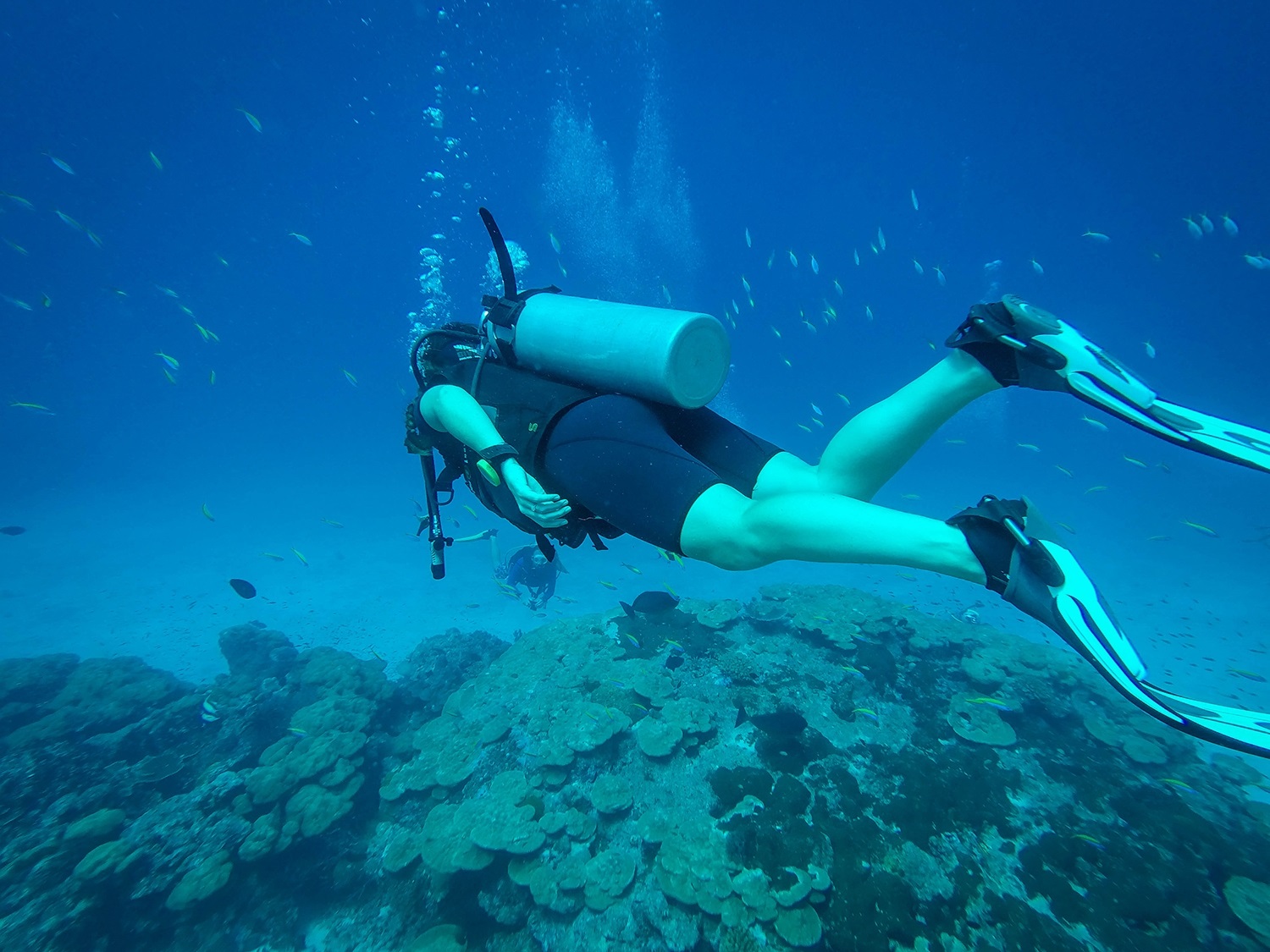
Thailand is a fantastic place to experience the underwater world! Koh Tao is famous for quality yet inexpensive Scuba certification courses (we got certified there and had a great experience!), and many of the Thai islands boast wonderful diving and snorkeling.
However, with so many tourists putting on masks and fins and jumping in the ocean, it’s more important than ever to be a responsible diver or snorkeler.
Don’t feed fish! It’s not natural for them to eat bread or bananas or whatever else you’re giving them. They can find food for themselves and it can be harmful for them to learn to take food from humans.
Don’t touch or pick up any marine life. We’ve gone on a few snorkeling trips where the guides have picked up starfish to show us, but it rubbed us the wrong way. Touching them or moving them can cause them harm, and there’s no reason we need to manipulate them.
Don’t touch or stand on coral. Be sure only to stand on sand or rocks. It can cause irreparable damage when humans stand on coral. And touching the reefs transfers oils from our hands that are not natural underwater. Be a passive observer instead!
Choose dive companies that are eco conscious! For example, we did a 3-day scuba liveaboard trip in the Similan Islands and found there were a ton of companies to choose from. We ended up booking our trip with Wicked Diving because they have very strict environmental policies.
Wherever you are diving in the world, it’s important to be aware of how you are treating marine life.
Looking for a Liveaboard diving experience? We put together a detailed guide to diving in Thailand including our recommended Liveaboards for every budget.
9. Choose tour companies wisely
When booking tours, be sure to do some research.
While doing your research, be wary of “green washing” (aka companies that claim to be environmentally conscious without following through).
We’ve seen firsthand that many companies or hotels put buzzwords like “green” or “eco” in their name without doing anything to mitigate their impact on the environment. If a company claims to be sustainable, they should be able to answer questions like:
“What is this company doing to lessen its carbon footprint?”
“How are you giving back to your local community?”
“How will my money be used for improving and protecting the environment?”
We have a lot of power when we choose companies. Remember that you are essentially “voting” with your money.
When you support a company that does not respect the environment, you’re telling them it’s okay to continue these practices. However, when more and more consumers choose responsible companies, the competition will notice and start making positive changes as well.
Research companies before booking a tour
Be willing to pay a little more to choose a company that is environmentally conscious
Spread the knowledge. When you find a company that is doing good, praise them. Write reviews online too so other travelers can support them. And if you notice a company is not following through on their promises, talk to them about it and write a review online so other guests can choose whether or not they’d like to support the business.
10. Participate in a beach clean up
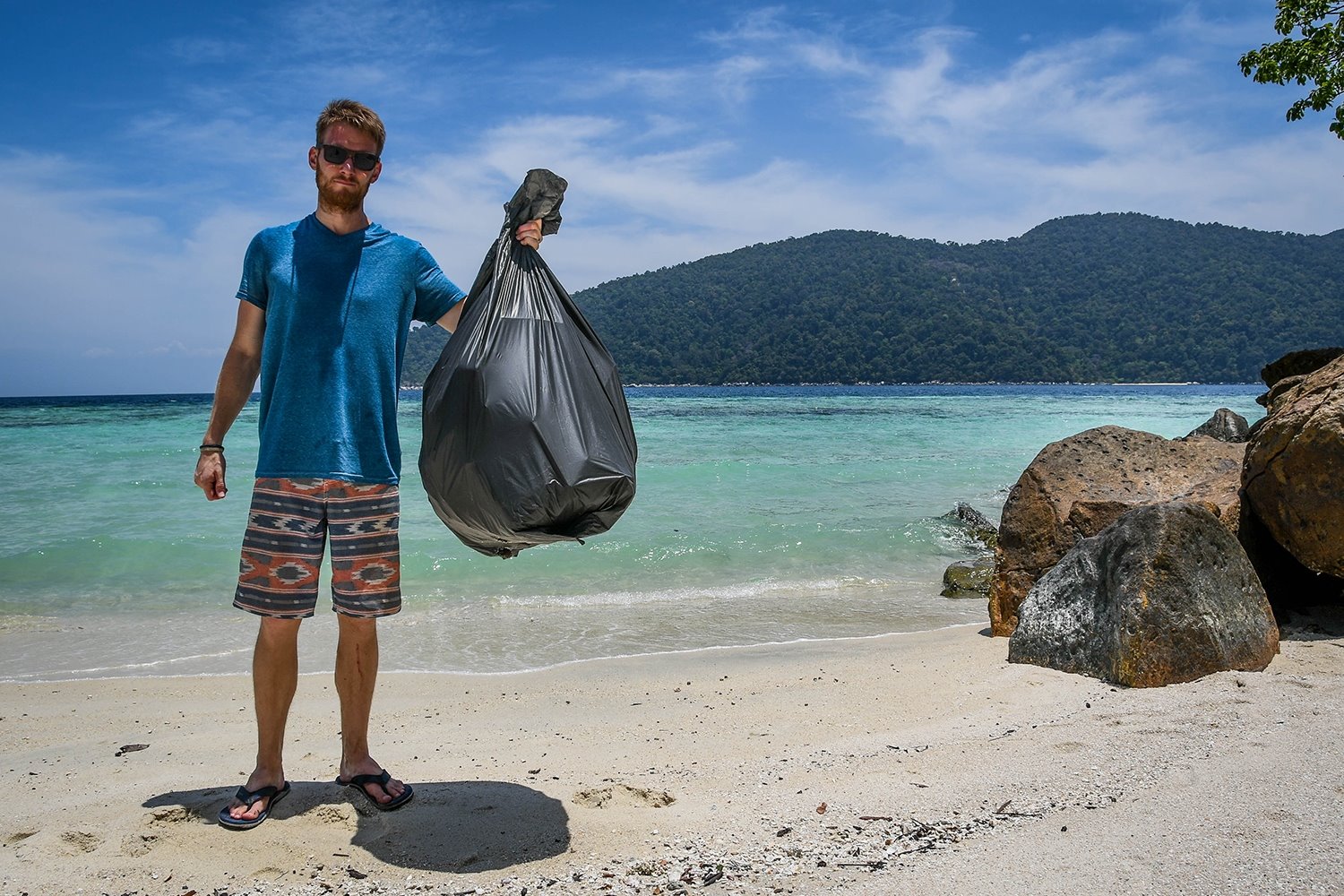
If you want to really make a difference while traveling in Thailand, consider participating in a beach clean up. Trash Hero is really cool organization that leads weekly clean ups all around Southeast Asia.
We participated in a beach clean up while staying on Koh Lipe and had a really good, eye-opening experience. We felt like we made a tangible difference (even if if was small!) and saw firsthand how much trash actually washes up on even the most remote islands.
Plan to do a beach clean up during your trip! Check out Trash Hero’s website for more details.
Tell other travelers you meet along the way about the beach clean ups. The more people that know the better!
Trash Hero accepts donations and also sells t-shirts and reusable water bottles. If you can’t donate your time, consider supporting with a donation or purchase.
11. Avoid flights when possible
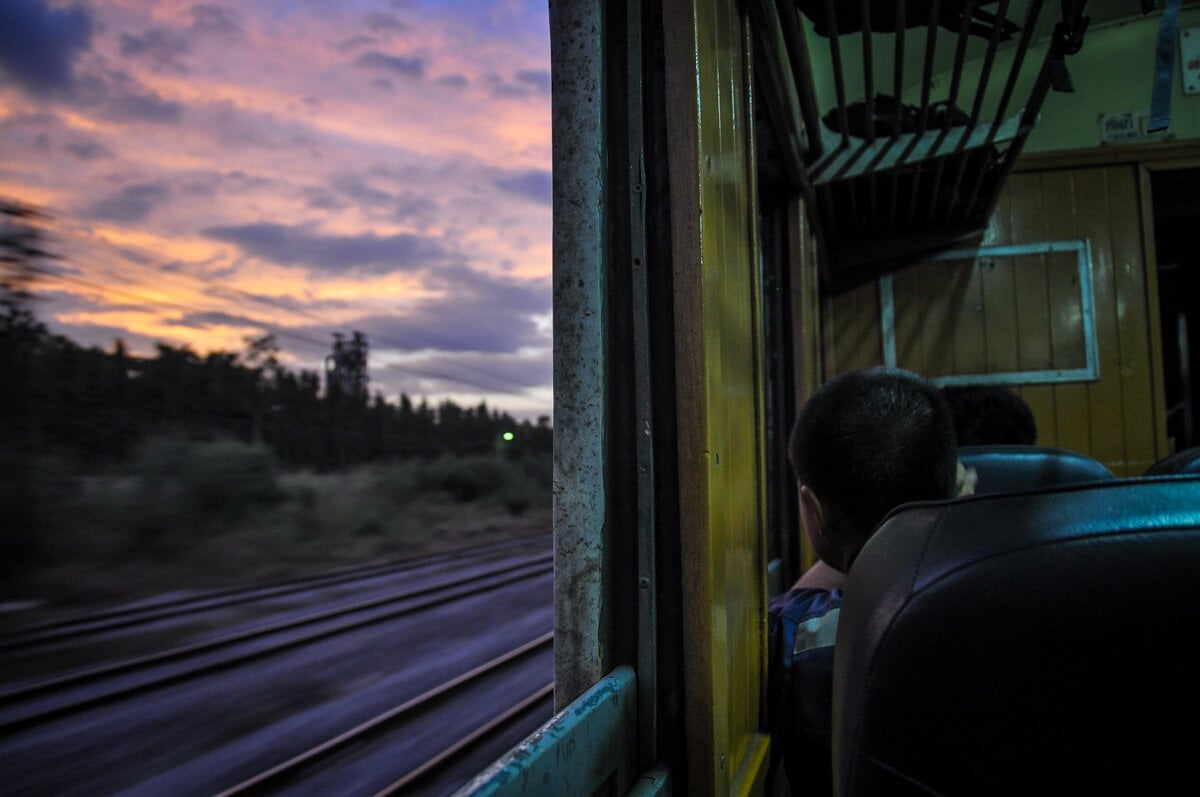
Taking the train from Ayutthaya to Chiang Mai is a long journey, but it is quite the adventure (and it’s super cheap!).
Getting to Thailand will require a flight for most travelers. But once you’re in the country, it is very easy to travel via bus, shuttle, ferry and train! We’ve taken all the above, and not only are they better for the environment (saving lots of CO2 emissions compared to flights), but they’re super cheap modes of transport too.
If you have the time to travel slowly, avoid taking flights within Thailand. You might even come away with an adventurous story that would never happen had you taken a regular flight.
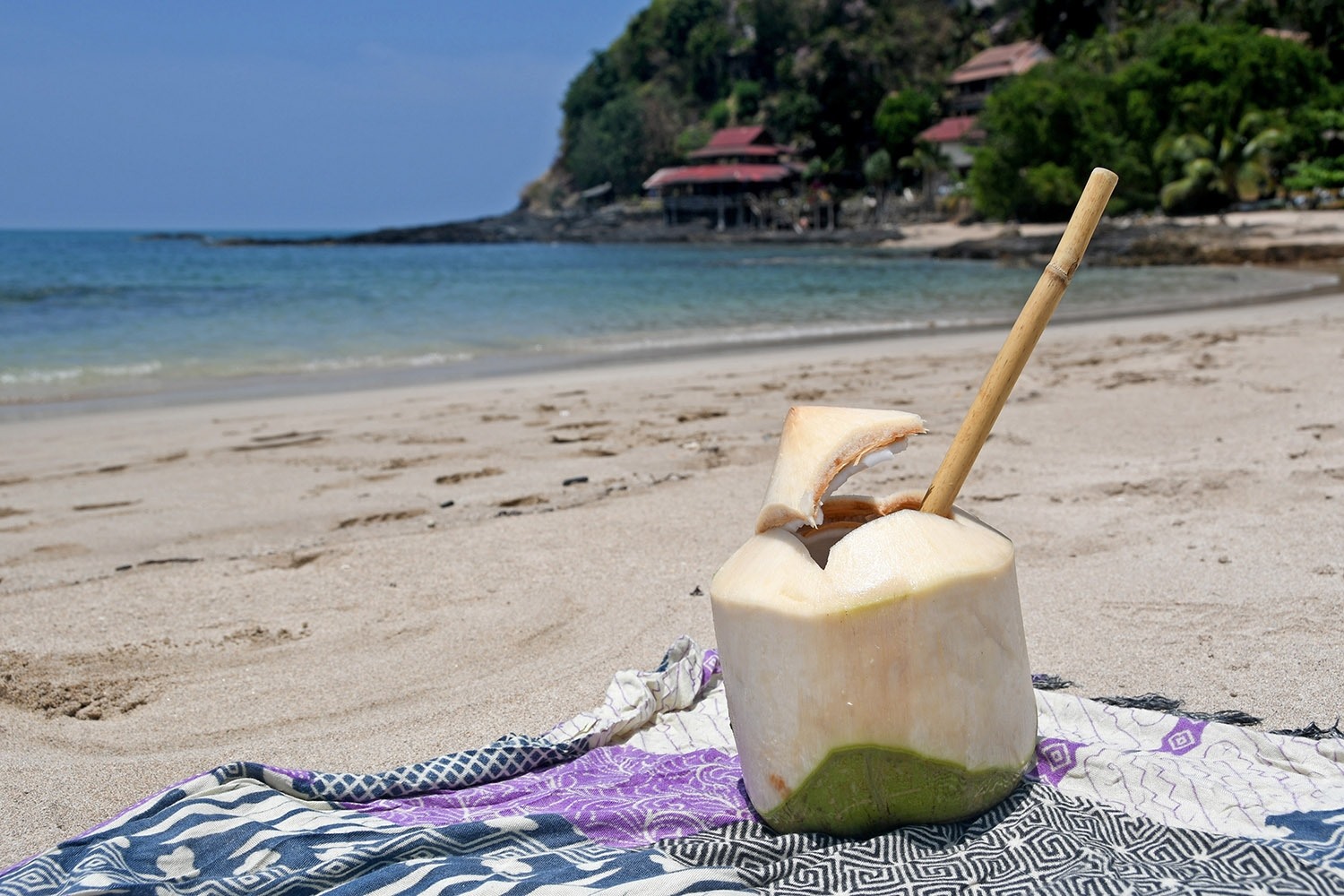
Responsible Travel Related Articles:
What is Sustainable Tourism?
Eco-friendly Product for Responsible Travelers
33 Responsible Travel Tips
How to Plan a Sustainable and Eco-friendly Trip
How Much is Your Selfie Worth?
Traveling in Thailand?
We have TONS of resources on travel in Thailand and destinations throughout the country.
Check out our Ultimate Thailand Travel Guide for all the answers to your most burning questions, or read some of our favorite articles below:
Perfect Thialand 2-Week Island-Hopping Itinerary
Absolute Best Things to Do in Chiang Mai
Things to Do in Koh Lipe: Thailand’s Island Paradise
Unique & Cheap Things to Do in Bangkok
Epic Things to Do in Pai, Thailand
Tell the world how to travel sustainably in Thailand. Share it on Pinterest!
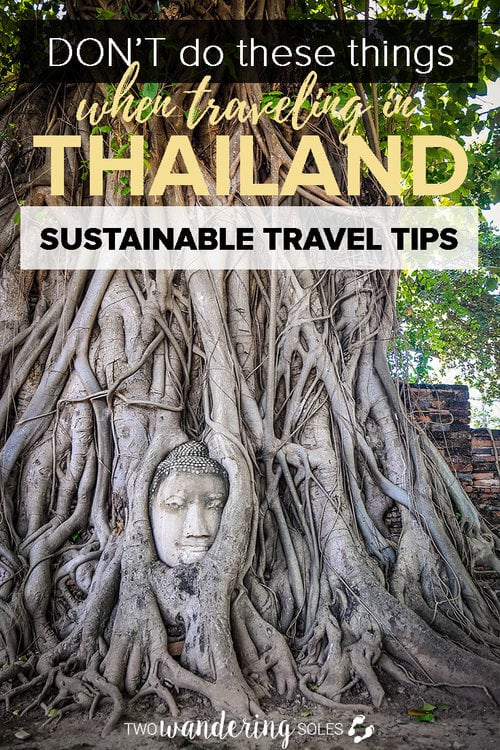
We want to hear from you!
Did you learn anything from this article? Do you have any other tips for sustainable travel in Thailand? We’d love to hear from you in the comments below!
Comments (3) on “ How to Travel Sustainably in Thailand and Why You Should Care ”
Great Travel guide about Thailand.
I love Thailand and I would go back there with great pleasure, but tourism is starting to have such a bad impact in this country. The elephant are abused and many tourists don’t know about it (or don’t care), pollution is a real problem (if you wonder late in the city you’ll see the street filled with so many waste and everything is plastic). The sex traffic is very famous in this country and indeed I never realized those "ping pong shows" were contributing to it in a way … so thank you for the article !
Hey Steven, We also love Thailand, but you’re right, there are somethings where tourism has really made a negative impact. But hopefully as more and more people become informed about these issues, the demand for the bad things will go away.
Leave a Reply Cancel reply
Your email address will not be published. Required fields are marked *
Save my name, email, and website in this browser for the next time I comment.

Eco-Tourism in Thailand: A Guide to Sustainable Travel
- September 21, 2023
- Attractions , Mountains , Thailand

Table of Contents
Rising global environmental concerns, like climate change, have led to an increase in the popularity of eco-tourism, as many travelers now look for opportunities to explore natural areas with as little impact on the environment as possible. For reasons which you’ll soon see, Thailand as a prime tourist destination occupies a unique position in sustainable travel, and the opportunities for eco-tourism Thailand provides abound.
Are you an environmentally-conscious traveler looking to explore this Land of Smiles in southeast Asia, and experience its wonders? Then you’re in good hands! Our Eco-tourism Thailand Guide reveals the most important things you need to know about sustainable tourism within this destination.
First, a look at eco-tourism in general.
Understanding Eco-Tourism
Eco-tourism, according to The International Ecotourism Society (TIES), is “responsible travel to natural areas that conserve the environment, sustains the well-being of the local people, and involves interpretation and education.”
In other words, an eco-tourist is one who – during their travels – is committed to respecting nature, promoting sustainability by not harming the environment, and supporting local cultures.
It’s important to travel sustainably or in an eco-friendly manner because this:
- Reduces all forms of pollution
- Combats climate change
- Helps in the preservation of natural wildlife and resources
- Promotes biodiversity
On the whole, sustainable travel is focused on minimizing the negative impact of tourism, while maximizing its benefits. So, for those who’ve been thinking that “eco-tourism” is just a buzzword, it really isn’t.
Why Thailand is an Eco-Tourism Hub

Like we mentioned at the start of this Eco-tourism Thailand Guide, there are several reasons why many travelers prefer the country as a responsible tourism destination.
One is the fact that it’s a natural fit for eco-tourism, with its rich cultural tapestry as well as diverse ecosystems including dense jungles and serene beaches. Thailand boasts many green and natural spaces, including homestay villages offering many exciting eco-friendly activities, and animal sanctuaries where one can support endangered wildlife.
As part of its Seven Greens of Tourism campaigns, the Government of Thailand supports and leads the push for responsible tourism; it’s also making long-term strategic policies to maintain the country’s ecosystem, while identifying new eco-destinations, promoting, and developing basic infrastructure for them.
Eco-Tourism in Thailand : The Top Destinations
The eco-tourism Thailand offers has always been attractive to responsible travelers; here are a few top destinations we recommend you check out as an eco-tourist interested in exploring the country.
1. Chiang Mai

Famous for its historical temples, cool weather and scenic landscape, this city amidst the mountains of northern Thailand is the ideal place for several eco-friendly activities, including trekking or hiking on nature trails, visiting hill tribe villages, and exploring nature parks like the Doi Inthanon National Park.
2. Phang Nga Bay

A well-sheltered bay between southern Thailand’s mainland and Phuket Island, great for sea kayak expeditions, with fascinating caverns, limestone karsts, emerald waters, and a National Park which is an absolute geological wonder. Conservation efforts here prioritize marine life preservation and responsible tourism promotion.
3. Khao Sok National Park

This nature reserve in southern Thailand hosts one of the world’s oldest rainforests – a dense virgin jungle prime for jungle treks, wildlife spotting, and sustainable camping experiences. The unique ecosystem includes towering limestone karst formations; a man-made lake; plus rare species like gibbons, tigers, and the giant, parasitic Rafflesia flower.

Pai, a quaint town within the mountains of the Mae Hong Soon Province of northern Thailand, offers hot springs, waterfalls and gorges. Pai is also a hub for organic farming, where you can participate in farm stays to savor farm-to-table meals and learn about permaculture.
5. Koh Yao Islands

The Koh Yao Islands (Koh Yao Noi and Koh Yao Yai) are just a short boat ride from Phuket. Community-based tourism is the focus on these islands which offer much to experience and learn about traditional fishing techniques and mangrove conservation.
Eco-Friendly Activities to Try
Now let’s talk about the sustainable activities to try in Thailand, as the country offers a plethora of them.
Wildlife Watching

There are several places where you can feast your eyes on Thai wildlife. Chief among them is the Kui Buri National Park boasting a variety of wildlife, like monkeys, elephants, water buffaloes, sambar deer, etc. Other interesting wildlife hotspots include the Mu Ko Chang National Park and the Pranburi Forest Park.
Trekking & Hiding

With the country full of jungles, you’ll have your fill of sustainable trekking or hiking. Popular hiking spots include Kew Mae Pan Nature Trail, Khao Yai National Park, and Krabi’s Tiger Cave Temple. The trails in Khao Sok also promise an unforgettable trekking experience.
Organic Farm Visits
Thailand offers some of the best organic agro-tourism farm stays and rural retreats. Visit one and enjoy the fresh mountain air, lush jungles, and organic home-style dishes, while learning about local farming practices, arts and crafts, natural construction, yoga, and even helping with the harvest.
Traditional Craft Workshops
Another eco-friendly, exciting activity to try is to learn a traditional craft from local artisans. You can learn to make many things, like jewelry, traditional Thai garlands, and silk; lessons can also include Moken weaving, leather designing, and traditional Lai Rod Nam.
Traveling Responsibly: Tips for the Conscious Tourist

We can’t wrap up this Eco-tourism Thailand Guide without including a few tips for the road. Here are ways to make your eco-travels as sustainable as possible.
- Choose eco-friendly accommodation : Eco-friendly lodges use renewable energy and adequate waste management systems; they also make local employment a priority. Choose such accommodations as they’re a vital aspect of sustainable travel.
- Respect local cultures and traditions : Be sure to respect the customs of any locality you find yourself in. Eco-tourism is as much about respect as it’s about fun and adventure.
- Minimize your environmental footprint : Try to keep the amount of waste you generate to a minimum, and dispose of same properly.
- Support local economies : You can do this by purchasing as much locally made products as you can.
- Choose activities that prioritize sustainability : Such activities as we mentioned earlier are great examples.
The Future of Eco-tourism in Thailand
The eco-tourism Thailand is popular for offers excellent opportunities to experience wholesome living, and these opportunities will only get better with time, more government initiatives, and increased community involvement; so expect a brighter, greener future for Thai tourism.
We hope our Eco-tourism Thailand Guide will make your sustainable journeys within and even outside the country smoother.

© 2023 by Bangkok Airways. All rights reserved.
Privacy Policy
- Luang Prabang
- Mae Hong Son
- In the News
- Route Network
- Book a Flight
- Flight Schedule
- South America
- United States
- TRAVEL GEAR
- Privacy Policy

- PHILIPPINES
- NETHERLANDS
- UNITED STATES
- OFF THE BEATEN PATH
- Responsible travel
- Animal tourism
- Eco friendly products
- Interview series
Sustainability , THAILAND
Sustainable tourism in thailand: 10 easy steps to ethical travel.
Thailand is one of the most popular countries to visit in Southeast Asia and is on most party backpackers’ bucket lists. However, the country is paying the hard toll of overtourism and devastated nature.
So, should we stop traveling to Thailand altogether?
Not likely.
The economy in Thailand is much dependent on tourism . So how can we as travelers make sure we leave a positive impact on the country, its inhabitants, nature, and wildlife?
Sustainable tourism sounds like an epic global effort and it sure is. But we can all make a difference by ensuring WE make the right choices when traveling.
To help you get started, I’ve put together these easy steps to sustainable tourism in Thailand that you can incorporate without considerable effort on your next trip to the land of smiles.
Disclosure: This post may contain affiliate links. That means that if you make a purchase through one of those links, I will get a small commission at no extra cost to you.
Table of Contents
Sustainable tourism in Thailand
Support local.
One of the easiest ways to support Thailand eco tourism is to support local. Whether it is by shopping in locally owned stores, or street stalls, choosing street food and local restaurants over foreign-owned chain restaurants, or checking in at a Thai-owned hotel or homestay instead of a foreign-owned chain hotel.
Luckily, when it comes to food, the local food is so amazing that it is hard to opt for anything else. When it comes to picking hotels, it might be trickier.
If you travel off-season (I’ll get back to that later,) you can easily walk around looking for a place to stay when you arrive at your destination. Other than large cities like Bangkok and Chiang Mai, you can easily find local bungalows and hotels a little bit away from the main streets.
This way, you support families that naturally get fewer guests and you might even save a few Bath since the hidden places often are more economical.
Community-based tourism in Thailand is also a great way to support sustainability.

Avoid Tiger Temples
When talking about responsible tourism in Thailand, I have to mention the tiger temples. I still see articles trying to seduce tourists saying that the tigers aren’t drugged and that it’s totally ethical to visit.
Well, it’s not. Generally, any place that lets you take selfies with wild captured animals is a no-go . The first few times I was in Thailand, everyone talked about one of the best things to add to your Thailand bucket list – visit the Tiger Temple where tigers and monks lived in harmony.
There, you could take a picture with a tiger, and even better, with a cute tiger cub. In 2016, the tiger temple was shut down due to unethical practices and trading tigers and their body parts.
According to the above article, tourists mainly wanted selfies with the tiger cubs. Thing is, these babies grow up in size in only 6 months and are no longer cute cubs. So how do they breed so many cubs constantly to constantly have them for tourism display?
How is it even ethical to make so many babies when the animals are going to live the rest of their lives in captivity and there are no plans for conservation or preparing rescued tigers for returning to the wild?
These places are literally tiger zoos. You can read more about why you should not visit for-profit sanctuaries and zoos in this post .

Don’t ride, bathe, or feed elephants
It’s already quite widespread that you shouldn’t ride elephants. Their spine is not created so that it should handle the weight.
Furthermore, the dreaded process of training elephants to obey humans is something that no one should support. It literally starts with the baby elephants being taken away from their mothers at a young age. They are then put through psychological and physical torture which is referred to as “ The Crush .”
Yet, there are a lot of sanctuaries that greenwash their business in Thailand.
There are even places that own two different elephant sanctuaries. One is where elephants are used for elephant rides and paintings, etc. while the other is for the ethical tourists that just want to see the elephants and have an ethical experience.
Thing is, the same elephants that you have an ethical meeting with today, might be sent to carry tourists around at the other venue the next day. In fact, the money you pay goes to the same owner and supports the same unethical activities that you don’t want to take part in.
Unfortunately, it’s hard to assure that the elephant sanctuary that you visit is ethical.
Further, some sanctuaries offer tourists bathing with the elephants. Think about it. Bathing the elephants means that the elephants have to take a bath at the exact time when tourists are around, they have to be watched over by a mahout so they won’t accidentally hurt the tourists, and they lose the sense of freedom to do what they feel like when they want to.
Which is kind of the point about being in a sanctuary, isn’t it?
You can find a list of ethical elephant sanctuaries in Thailand and beyond here .
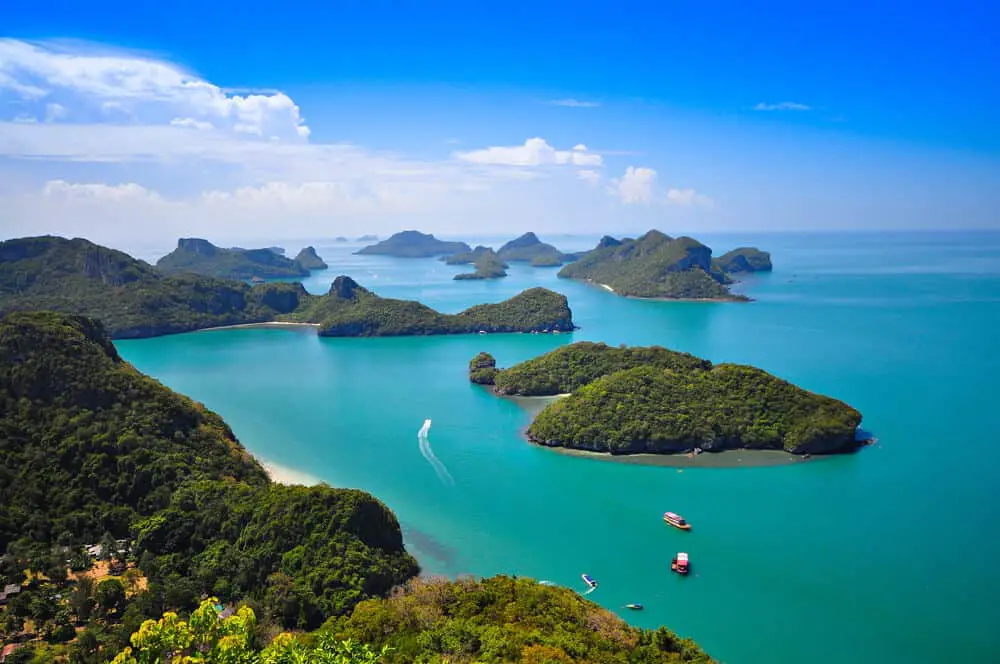
Travel long distances by boat, bus, or train
When traveling long distances, it can be tempting to take a flight. But sustainable travel in Thailand by train or bus (or boat) can be just as easy.
You avoid the check-in and boarding process, and unless you’re only carrying hand luggage, you save the painful wait for your bag.
If you head to one of the bigger islands with an airport, like Phuket or Koh Samui, why not make it an epic Thailand island hopping experience instead and explore some other islands along the way?
Islands like Koh Phi Phi , Koh Lanta , Koh Mook, and Koh Phangan are great for this, but there are also lesser-known islands worth tapping into.
You can save money both on accommodation and transport costs by taking the night train or night bus, though I have heard some dodgy experiences about night transport, thus I’ve avoided it myself.
However, if you have enough time and want to practice green travel, Thailand has an excellent network of public transport between places.
Travel in the shoulder seasons
When you consider sustainable tourism, Thailand is an epic destination to travel to in the shoulder seasons. If you don’t mind heavy rains, feel free to head there in the rainy (low) season too, which is considered the low season. I haven’t been there personally during this time (July to October,) but it rains A LOT!
In November, the tourist season starts to peak and even the beginning of December in Thailand is better than later in the month and throughout March.
The other shoulder season is from April to June and you might experience mild, dry weather as in the high season. But with fewer tourists.
This is excellent news! And on top of that, the prices of accommodation are often lower. However, some lesser frequented places and islands, like Koh Mook , might not be possible to reach, so make sure you do your research before your trip.
Traveling outside the peak season also contributes to a boost in the local economy at a time of the year when families usually don’t earn much money as well as less stress on the destinations in high season.
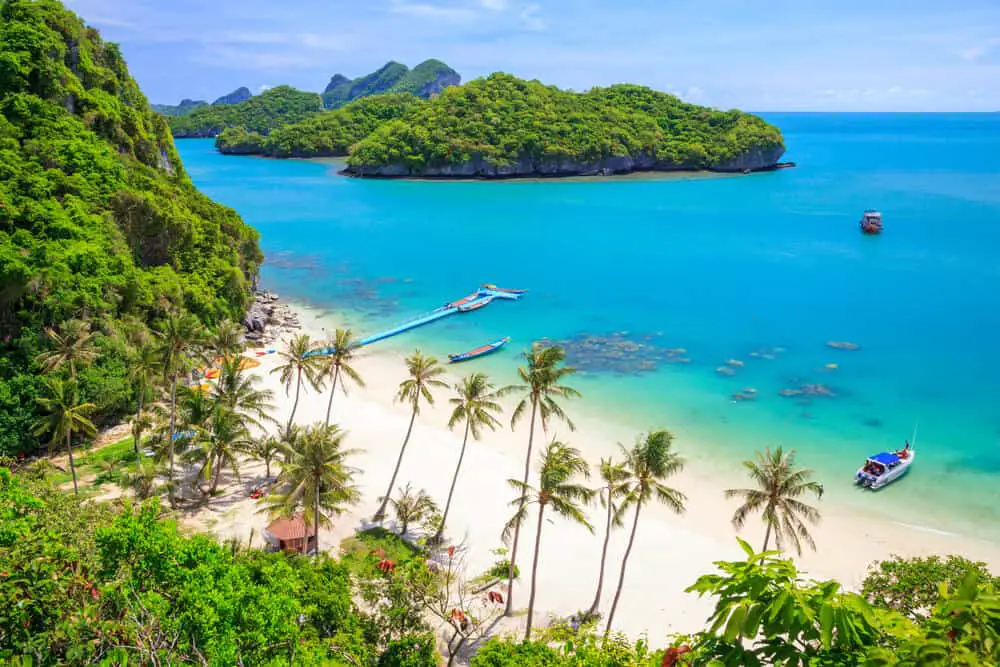
Travel off the beaten path
Traveling in Thailand off the beaten path is a great way to contribute to eco tourism. Thailand has a heavy tourist load in certain areas while others don’t see many travelers.
Spreading the tourist money to lesser-visited places supports a positive impact of tourism Thailand can benefit from as a country.
There are many amazing hidden gems in the country where you can enjoy long white-sanded beaches without the crowds, stay in homestays to get a deep dive into the local culture and customs, and head out into the untouched jungle. Even if it’s your first time in Thailand , it is well-worth traveling off the beaten path.
Traveling off the beaten path is truly one of the most rewarding ways to contribute to green tourism in Thailand.
Choose ethical tour companies
When you go on day tours in Thailand, make sure you choose ethical tour companies. First of all, make sure they only promote ethical activities on their tours, eg. no unethical animal tourism.
A company that’s locally owned and proactively supports ethical and eco friendly activities, supports conservation work or local organizations, is usually a good place to leave your money.
If you are unsure about their take on sustainable tourism in Thailand, you can always ask them a few questions about it. If they try to avoid answering, it’s often a bad sign.
On the other hand, if they can show for projects they support in any way, it means they are making a difference, or at least on their way to improving.

Choose ethical and local dive centers
If you go scuba diving in Thailand (which you totally should,) you should take time to carefully choose an ethical and locally owned dive center.
Most islands in Thailand have a variety of dive centers to choose from and in most places, there is at least one local dive center to choose from.
A dive center that promotes ethical diving and leave no trace, is usually a positive sign, though others might not show it, yet practice it.
Even if the dive center promotes ethical diving, it’s good to know that not all dive instructors or other employees follow these guidelines.
So if you go on a diving trip and experience dive masters and instructors touching corals, feeding fish, throwing cigarette butts in the water, or doing other unethical actions, let the managers know in a nice way.
It might be that they don’t know (even though as a diver I think that they should know,) or that they aren’t being a good example for the company.
Finally, make sure you, as a responsible traveler , pick up any rubbish you might find during your dive and put it in your pockets until you can dispose of it in a proper manner.
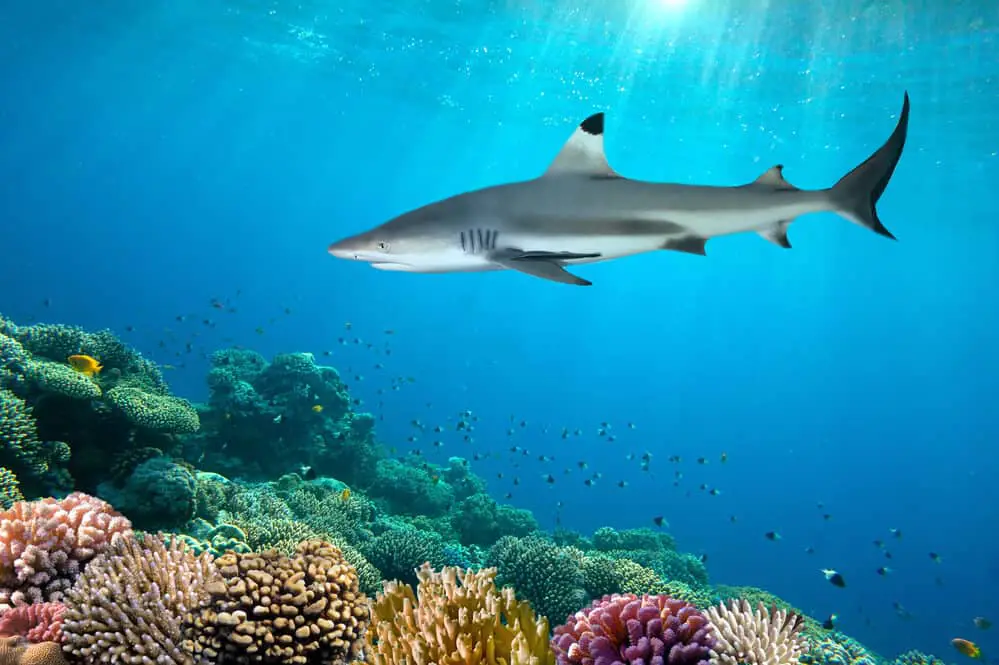
Do a beach clean-up
An easy way to contribute to responsible travel in Thailand is to do a beach clean-up. There are many local organizations to look up for organized clean-ups.
I suggest doing a quick Google search on the destination you’re at or checking local Facebook groups for beach clean-ups.
However, you don’t need to join an organized beach clean-up to make a difference. I often just brought a bag or five with me to the beach and started picking. Sometimes local kids or other travelers would come and join me, while other times I would pick a few bags by myself.
No matter how you do it, I can assure you that it feels really good to see the result!

Choose human-powered transport when possible
When traveling, it can be tempting to take tuc-tucs or taxis for shorter distances, while you could easily walk half an hour instead.
Instead of renting a scooter, consider the distances you plan to undertake and see if it’s possible to rent a bicycle to get around.
I get it, some areas can be too far apart for day trips with the bike, but I’m sure you can swap out the scooter at least on some excursions.
Finally, can you rent a kayak to explore around the island instead of booking that boat tour?
There are many possibilities and a slow pace travel experience often rewards you with a whole lot of unexpected adventures that you would never have had otherwise.
Reflections on eco tourism Thailand
There is no doubt that you can contribute to sustainable tourism in Thailand easily by incorporating a few of the above suggestions.
You can also focus on visiting eco tourism destinations in the countries you visit to make a positive impact while supporting great initiatives.
Thailand is truly one of my absolute favorite countries in Southeast Asia and the one I’ve returned to time after time, so seeing that you are concerned about exploring it in a responsible way warms my heart!
No matter where your trip to Thailand takes you, I’m sure you will have a blast. Thailand eco tourism is becoming more popular these days and the more we talk about traveling sustainably, the more people will join in with new knowledge.
Happy travels!
- Destinations
- Travel Guides

- Sustainable travel in Thailand
)
Airra Beatrice
Sustainable and responsible travel is an increasingly important concept that recognizes the impact of tourism in Thailand as well as other destinations and aims to promote practices that preserve natural resources, cultural heritage, and local communities.
Thailand , with its breathtaking landscapes, rich cultural heritage, and vibrant communities, is a destination that greatly benefits from responsible travel practices. By being mindful travelers, we can contribute to the preservation of Thailand's unique beauty and support the well-being of its people.
Overtourism in Thailand
Overtourism in Thailand has become a pressing concern due to the country's increasing popularity as a tourist destination. The rush of visitors has put significant strain on certain areas, leading to environmental degradation and challenges for local communities.
To lessen the negative impacts of overtourism, make sure to seek out lesser-known destinations in Thailand. Instead of going to the most famous and crowded spots, you might as well consider exploring off-the-beaten-path locations.
This not only reduces the burden on popular tourist hotspots but also allows you to discover hidden gems and experience a more authentic side of Thailand. Here are some examples of popular spots to avoid due to over-tourism, along with alternative, lesser-known destinations that offer a similar experience:
Avoid: Maya Bay, Koh Phi Phi Leh - Maya Bay became overly crowded after being featured in the movie "The Beach," causing environmental damage to the fragile marine ecosystem.
Alternative: Koh Lanta - Just a short boat ride from Koh Phi Phi, Koh Lanta offers a more relaxed and less crowded island experience with beautiful beaches and excellent diving opportunities.
Avoid: Patong Beach, Phuket - Patong Beach is known for its bustling nightlife and mass tourism, resulting in crowded beaches and a party-centric atmosphere.
Alternative: Kamala Beach, Phuket - Located just a short distance from Patong, Kamala Beach offers a more laid-back ambiance, ideal for families and travelers seeking a quieter beach experience.
Avoid: Floating Market, Damnoen Saduak - The popular Damnoen Saduak Floating Market can be overcrowded and overrun by tourists, losing its authentic charm.
Alternative: Amphawa Floating Market - Located near Bangkok, the Amphawa Floating Market is a more local and authentic option, where you can enjoy a traditional Thai market experience away from the crowds.
Avoid: Tiger Kingdom, Chiang Mai - Some animal welfare concerns have been raised about places like Tiger Kingdom, where visitors can interact with captive tigers.
Alternative: Elephant Nature Park, Chiang Mai - Instead of visiting establishments that exploit animals, consider supporting ethical elephant sanctuaries like Elephant Nature Park, where you can observe elephants in their natural habitat and learn about their conservation.
However, if you wish to visit popular attractions, consider doing so during off-peak hours. Arriving early in the morning or later in the afternoon can help avoid the large crowds and spread out the tourist flow throughout the day. This simple adjustment can make a significant difference in reducing the pressure on these locations.
- Environmental considerations
As responsible travelers in Thailand, it's essential to be mindful of our environmental impact and take actions to preserve the country's natural beauty. Here are some key environmental considerations and practices to adopt during your trip:
Water usage
Water is a valuable resource, especially in areas of Thailand facing water scarcity and drought. Areas such as Isaan in northeastern Thailand, parts of the Chao Phraya River basin, and some southern provinces experience significant water scarcity and drought.
So, as a responsible traveler, always be conscious of your water usage and try to conserve it whenever possible. Simple actions like turning off the tap while brushing your teeth or taking shorter showers can make a significant difference in reducing water waste.
To reduce your carbon footprint, use sustainable transportation options. Use public transportation like buses, trains, or shared tuk-tuks to get around Thailand whenever possible. Some cities in Thailand also offer bicycles and electric scooters for rent, providing eco-friendly alternatives for exploring urban areas.
Supporting local and eco-friendly businesses
Supporting local businesses is an important part of responsible travel in Thailand. When choosing accommodations, consider staying at locally owned guesthouses, boutique hotels, or eco-lodges that prioritize environmental and community-friendly practices.
Many of these establishments actively engage in initiatives that support local artisans, employ local staff, and encourage cultural exchange. By supporting local businesses, you preserve Thailand's cultural heritage and promote sustainable travel experiences.
You can also look for certifications or labels indicating their commitment to environmental responsibility. Here are some examples to look for:
Green Globe: This is a global certification program that acknowledges sustainable practices in the travel and tourism industry. Businesses with the Green Globe certification, including accommodations and tour operators, adhere to strict criteria in energy efficiency, waste management, water conservation, and community engagement.
Thai Green Label: The Thai Eco Label is a national certification system in Thailand that identifies eco-friendly products and services. Accommodations and tour operators with the Thai Eco Label have been evaluated for their eco-friendly practices and meet the country's sustainability standards.
Global Sustainable Tourism Council (GSTC): The GSTC provides a set of criteria for sustainable tourism that covers environmental, social, and economic aspects. Look for accommodations and tours that adhere to the GSTC standards to ensure responsible and sustainable practices.
In addition to these global and national certifications, keep an eye out for local initiatives or labels that support eco-friendly practices. Some businesses may have their own eco-friendly programs or partnerships with local conservation organizations.
How to reduce your impact on the natural environment
Thailand's diverse natural environment is home to a wide range of wildlife. When exploring nature reserves or national parks, follow the guidance of park rangers and stay on designated trails to protect delicate ecosystems. Here are some ways you can reduce your impact on the natural environment in Thailand:
Feeding wild animals can disrupt their natural behaviors, lead to dependency on humans, and even harm their health. Maya Bay is just one of many spectacular places in Phi Phi Island that has issues with tourists feeding marine life, particularly fish and sea turtles. While snorkeling or diving, some visitors may be tempted to feed the fish, leading to unnatural feeding patterns and potential harm to the marine ecosystem. So, to avoid contributing to these issues, make sure to avoid feeding wildlife.
Leaving trash behind not only damages the environment but can also harm wildlife that may ingest or become entangled in the waste. Always dispose of cigarette butts properly in designated bins or carry a portable ashtray for responsible disposal.
When enjoying picnics or outdoor meals, ensure that you properly dispose of any leftover food. Leaving food scraps behind can attract wildlife to human-populated areas, potentially leading to negative interactions and disturbances.
When snorkeling or diving, adhere to guidelines in marine protected areas to safeguard sensitive marine ecosystems and marine species.
Learn about the local ecosystems, wildlife, and environmental challenges in Thailand. OpenDevelopment Thailand provides some interesting information regarding Thailand's environment and natural resources. Share this knowledge with fellow travelers to collectively promote responsible and sustainable travel practices.
Choosing ethical tours and experiences
Choosing sustainable and responsible tours and activities is important for reducing our environmental impact and helping local people in Thailand. Try and avoid participating in activities that exploit animals or negatively impact the environment.
Instead, support tour operators and experiences that prioritize animal welfare and environmental conservation. Family-run businesses and small enterprises are excellent options to consider, as they are more likely to care about the environment and the local economy. Here are some local initiatives that promote sustainability and responsible travel:
Big Trees: Saving Thailand's Trees - this project is dedicated to preventing Thailand’s trees from being cut down for urban development.
Wonderfruit: Making Sustainable Events Trendy - creating popular events in Thailand while focusing on sustainability
Clean The Beach Boot Camp - a free beach boot camp in return for cleaning beaches in Thailand.
Some activities to avoid in Thailand include:
Tours or activities that involve animal exploitation, such as riding elephants or visiting animal attractions that prioritize entertainment over animal welfare.
Water activities that harm marine life, such as feeding fish or disturbing coral reefs.
Volunteering and Giving Back
Volunteering offers a unique way to connect with the destination and make a positive impact.
If possible, consider giving back to the local community through volunteering opportunities. Many organizations in Thailand such as Wildlife Friends Foundation , CARE International Thailand , and Caritas International Thailand work towards environmental conservation, community development, and wildlife protection.
Keep in mind that the project you’re volunteering for should not take away job opportunities from locals. Instead, it should complement and support the efforts of the community. Projects should prioritize involving and training locals to lead and sustain initiatives.
- Respecting local culture
Thai culture is deeply rooted in traditions, customs, and social norms that have been passed down through generations. When visiting religious sites, such as temples or sacred monuments, it is important to dress modestly as a sign of respect.
Both men and women should avoid wearing revealing clothing and should cover their shoulders and knees. Removing shoes before entering certain areas, as indicated, is also customary at many religious sites.
If you plan to visit rural or indigenous communities, make sure to be respectful and considerate of their way of life. Always seek permission before taking photographs of people, especially in sacred or private spaces.
- Introduction
- Theft and scams
- Local and eco-friendly businesses
- Reducing your impact
- Ethical tours and experiences
Share this article
)
Author - Airra Beatrice
Airra is a Filipino Gen Z, travel content writer driven by wanderlust. She started writing about her journeys for extra income, but stumbled upon an undiscovered passion for writing along the way.
She has travelled all over her cherished homeland, the Philippines, and was intrigued by Thailand, where she totally fell head over heels for mango sticky rice! She inspires others to explore the world's wonders and embrace the beauty of life's journey.
Last Updated 24 September 2023


- Southeast Asia
- North America
- Central & South America
- Middle-East
- Australia & South Pacific
- Luxury Awards
- Family Travel
- Solo Travel
- Beaches & Islands
- Zodiac Travels
- Wellness & Spas
- Accessories
- Points and Miles
- #TheGreenEdit
- T+L Tastemakers
- Sustainable Travel
- T+L Experiences
Tips on How to Travel and Shop Sustainably in Thailand, From a Mermaid Eco-Warrior
Notep, a famous artist, musician, environmentalist and freediver, shares her sustainable, regenerative travel guide to thailand. bookmark it..
By: Notep Published: Aug 14, 2023 11:13 AM UTC

Notep is a famous Thai artist, musician, environmentalist and freediver who has dedicated her time recently to encouraging eco tourism in her beloved Ko Tao and Chiang Mai. Here, she offers her sustainable travel guide to Thailand – where to visit, stay, shop and swim in the cleanest, greenest, most regenerative manner. Bookmark this page for your next trip to or around the Kingdom of Smiles.

ORIGINALLY FROM THE ANCIENT CAPITAL of Chiang Mai, Notep discovered her love of travel and exploration on an exchange program to Rimini, Italy, in 11th grade. “In this small town in the middle of Italy, I realized how much I love learning about new cultures and getting myself out of my comfort zone and seeing new things,” she says.

An artist, musician and environmental conservationist, she’s dedicated to helping others do the same, in a responsible and mindful manner. “All of my work focuses on connecting people back to themselves and nature,” Notep says. “My life’s passion is to spread this positive energy and truth about how humans, instead of going away from nature to technology and to the concrete jungle, we should come back to nature, appreciate nature again, because it’s what really matters and it makes us so much more happy when we are with nature. It’s the truth.”
Here, Notep shares with T+L her guide to sustainable, regenerative, low-impact travel in Thailand:
Five favorite destinations in Thailand ?
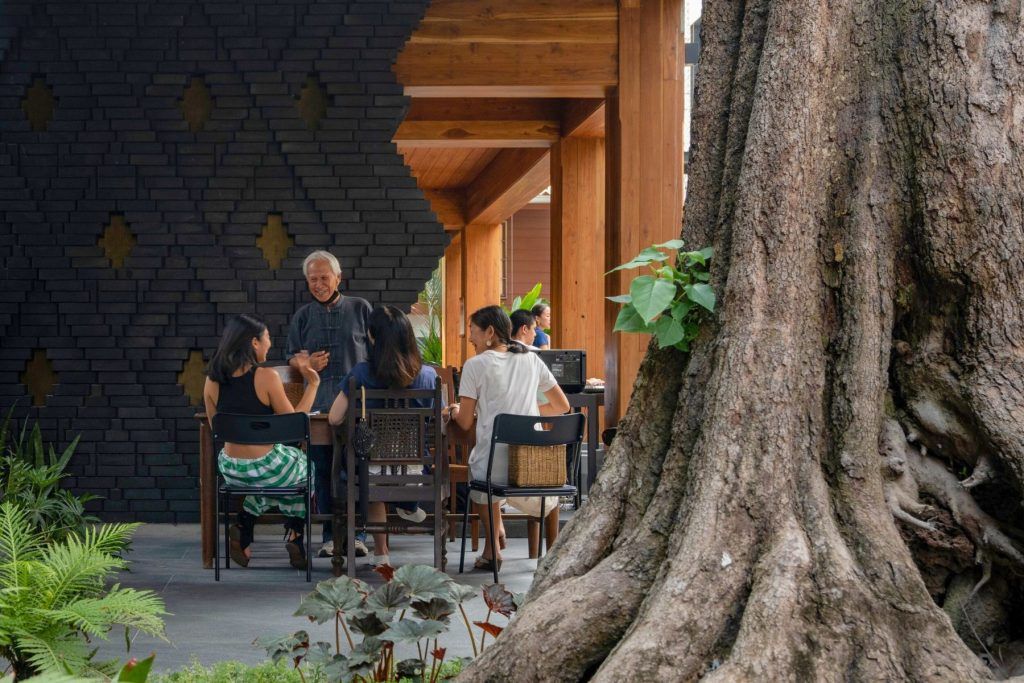
1) My favorite place is definitely Chiang Mai because it’s where I grew up. It’s where my family is based. I have a lovely home here with my dogs and every time I come back it’s like I’m coming back to my sanctuary, my comfort place. Chiang Mai is so cozy, everyone is so nice here. There are so many good food, cafes, art galleries, so many things going on that are on a small scale so it’s very well thought-through. I feel like people can make small-scale places better, as opposed to industrial size. It’s full of passion and it has so much charm.
2) Ko Tao . Again, it’s also a small place: everything is on a small scale as well. It’s like the perfect size and there’s this energy in Ko Tao. When everyone goes there, they feel more relaxed, they feel more at peace with themselves – and I feel like Ko Tao actually makes people nicer somehow, it removes the ego. It could be because the journey to Ko Tao is so long and it’s not easy. And the nature is beautiful there and the people in the community are also very open minded and nice.

3) Bangkok has its charm even though it’s so busy. It has so many hidden gems that if you explore you get to know it more and more. Instead of going to big shopping malls, you should go to these small places that are really charming. You can find anything and everything in Bangkok, and, most of all, everything is so cheap compared to the rest of the world.
4) I really like Chiang Dao . It’s close to Chiang Mai, about an hour drive from the city. The nature is beautiful, there are a lot of tribes doing a lot of interesting things.
5) Finally, Ko Surin because it’s very protected and you can only go there a couple of months per year. And so the corals are beautiful. I love how there are no big hotels in Ko Surin, only small bungalows or camping. So that’s really cool.
Where can we meet local artisans and shop for beautiful handmade goods?
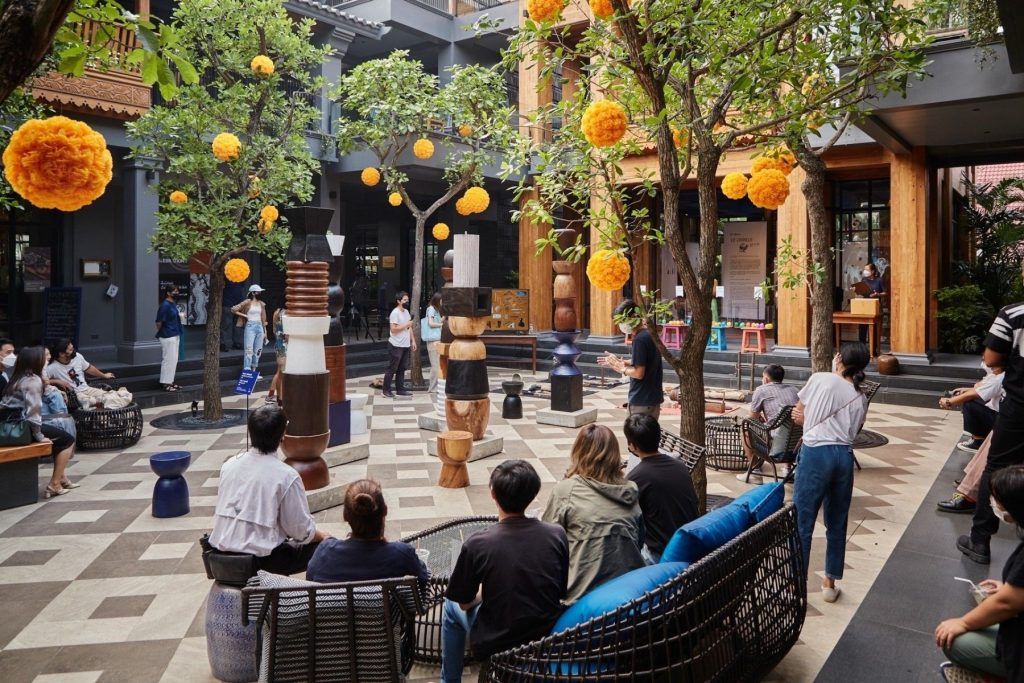
Notep: One of my favorite artisan spots is Kalm Village in Chiang Mai. Kalm Village really supports the local community and the local craftsmanship. They host a lot of exhibitions on textiles and craftsmanship, and I think the selection of their creations is amazing. They also have shops there that are really cool. They have restaurants and they have ongoing exhibitions all the time.
You have your own organic and upcycling-focused product line . What are other ‘noteworthy’ options for sustainable shopping in Thailand?

Image courtesy of Notep

Images courtesy of Notep
Notep: I suggest checking out these small businesses and collectives: Precious Plastic Bangkok Plas Tao , in Ko Tao Melt District in Chiang Mai Bope , in Chiang Mai Spirulina Society Fashion Revolution Thailand
Sustainable hotel pick
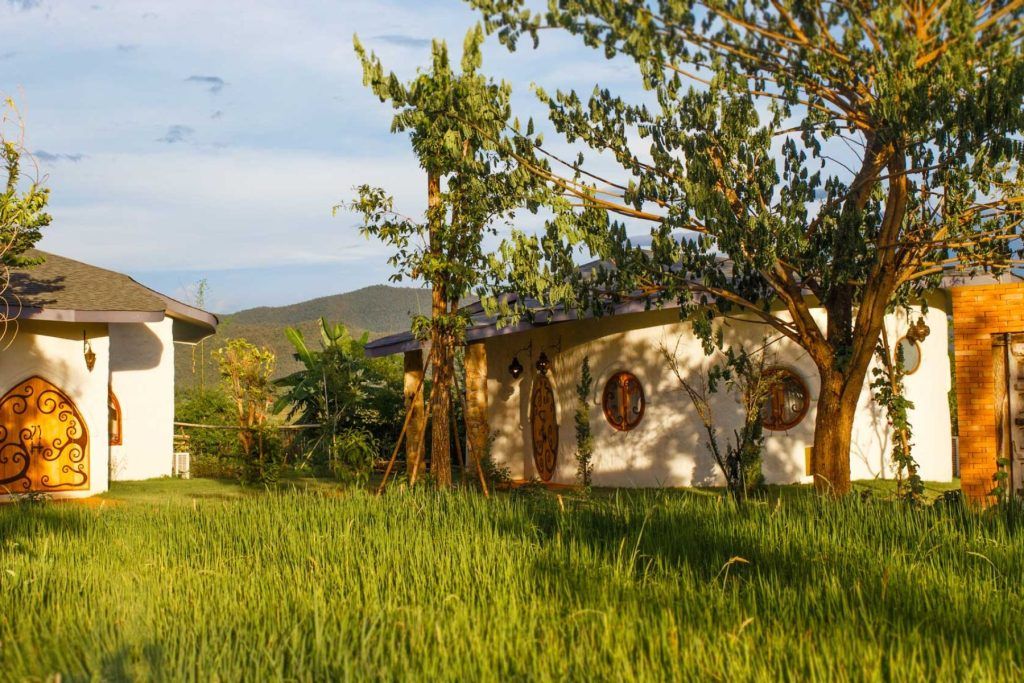
Image courtesy of Mala Dhara Eco Resort
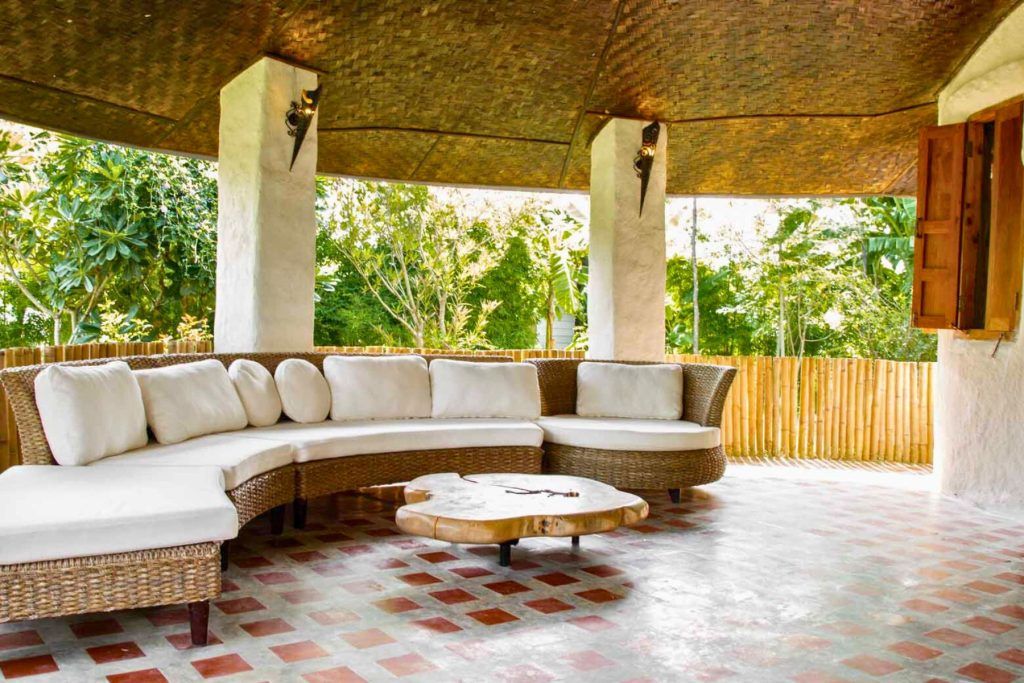
RAW Vegan Mango Cheese Cake. Image courtesy of Mala Dhara Eco Resort
Notep: I recommend Mala Dhara in Chiang Mai. It’s in Sansai, a beautiful, small resort that’s family-run and really simple. The food is great – it’s vegan, they have their own rice fields and Buffalo and they harvest their own vegetables, and they also host a lot of wellness retreats there. The owner is an amazing lady and a really good friend of mine, Ploy.
What can visitors to Thailand do to make sure that travel is as sustainable, regenerative or low-impact as possible?
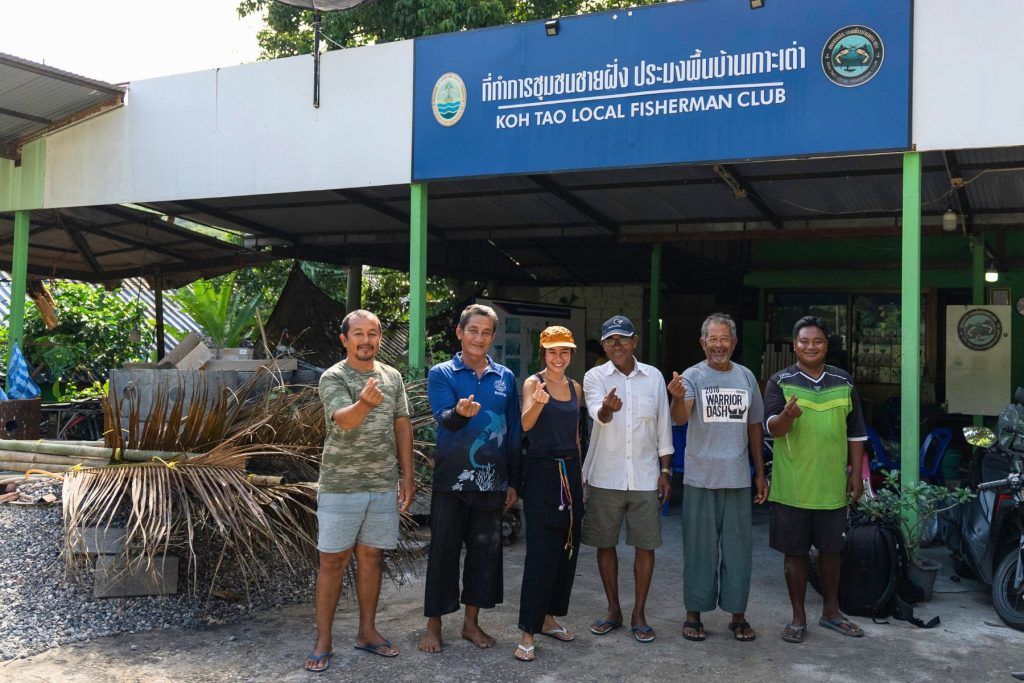
Notep: Be mindful of what you do. Respect the locals. And respect the culture. Leave nothing behind. Consume mindfully and consciously. Try traveling by train instead of plane – and trains are also really fun in Thailand. Try to say no to as much single use plastic as possible. Food-wise, try to eat at places where you know where the food comes from. For example, if you go to Chiang Mai, you probably want to eat local food. This is not the place for seafood because Chiang Mai doesn’t have an ocean. So they would have to import fish from another place. If you go to the sea then, yes, you can eat seafood and not something else from another place. Shopping-wise, try to buy things that are local, support the locals – I think that’s the most sustainable thing.
On any trip you always pack…

Notep: Reef-safe sunscreen. And I always pack my oil – Notep Beach Glow Oil – because it can be used in my skin and my hair, before and after every activity that I do. It’s organic, reef-safe, and environmentally friendly.
How did you get into freediving? And why do you love it?
Notep: Like a lot of Thais, I got into freediving during covid, and I love it because it’s a meditation, a meditation where you don’t have to sit still. And it’s a meditation where you really connect back to yourself through your breath. Because when you’re down there, you’re basically on your own with nothing. It’s you, your lungs, and nature, and it’s so amazing how the water just hugs you. You feel so free.
And with freediving, the more mindful you are, the more relaxed. The more in a meditative state you are, the better you will be underwater. So, I really love that and every time I go into the water, I just feel so connected and I feel like I’m going home.
Article sponsored by Tourism Authority of Thailand.
- Sustainable tourism
- Thailand Tourism
- thailand travel guide
- Tourism Authority of Thailand

Related Stories
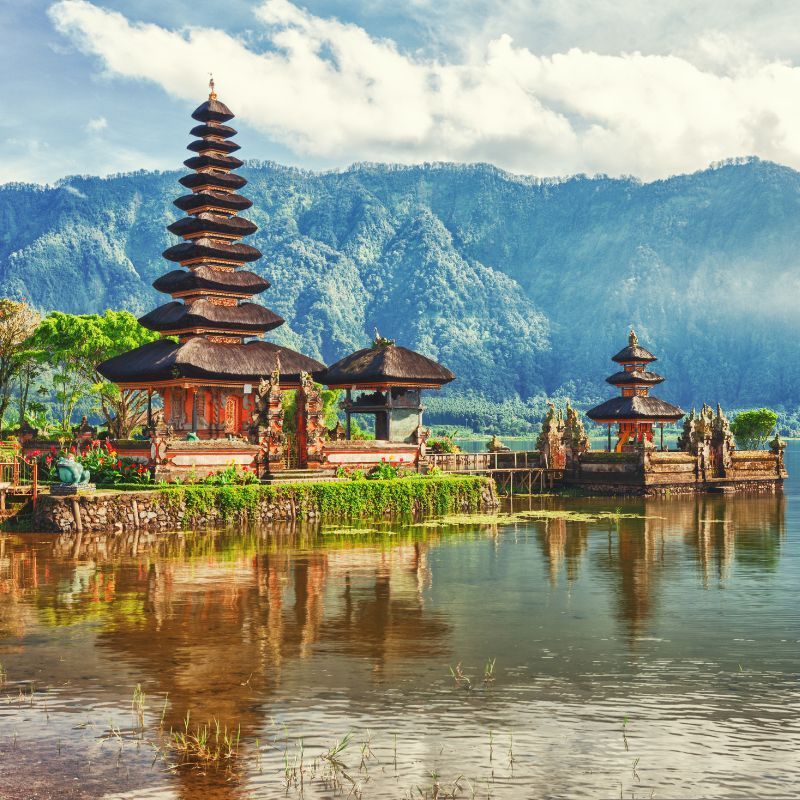
Nyepi Day – How A Revered Day Of Silence Marks The Balinese New Year
By Yashita Vashishth and Anushka Goel

Leap Year Lore: Unique February 29 Traditions And Customs Across The Globe
By Yashita Vashishth

Keegan-Michael Key On His Favourite Places To Travel
By Jesse Scott

The 'It Girls' Of Every Decade: Tracing Air India's Uniform Evolution Over The Years

How to Get Concrete Results in Design, According to Starchitect Tadao Ando
By Christian Barker

The New CEO of Sofitel and MGallery Hotels Says Deliberate Hedonism Plus Mindful CSR Are What Today’s Luxury Is Made Of
By T+L SEA Staff
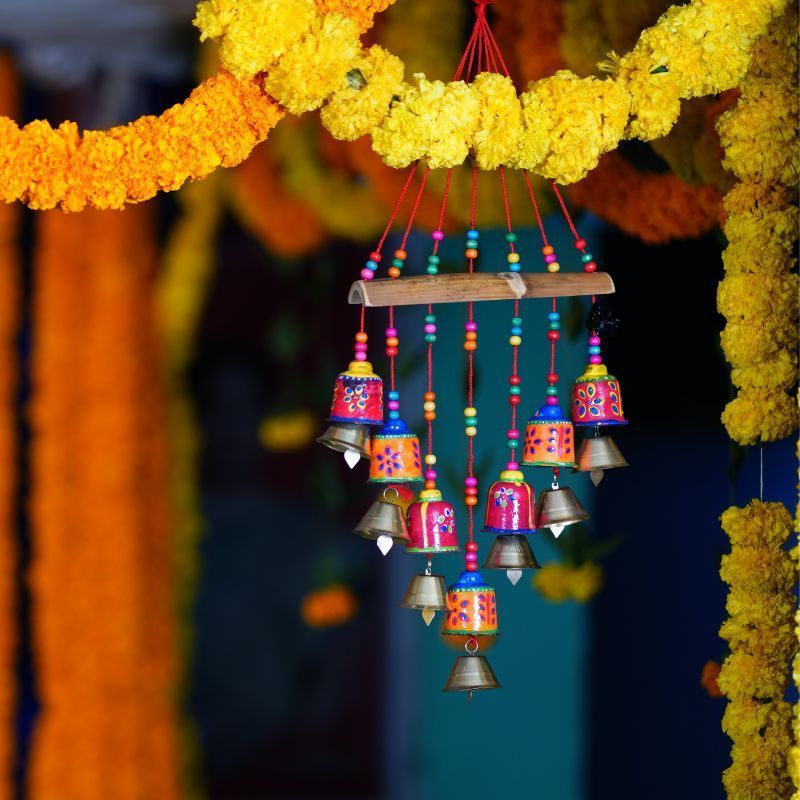
Significance Of Diwali And Its Sparkling Celebrations
By Trinetra Paul
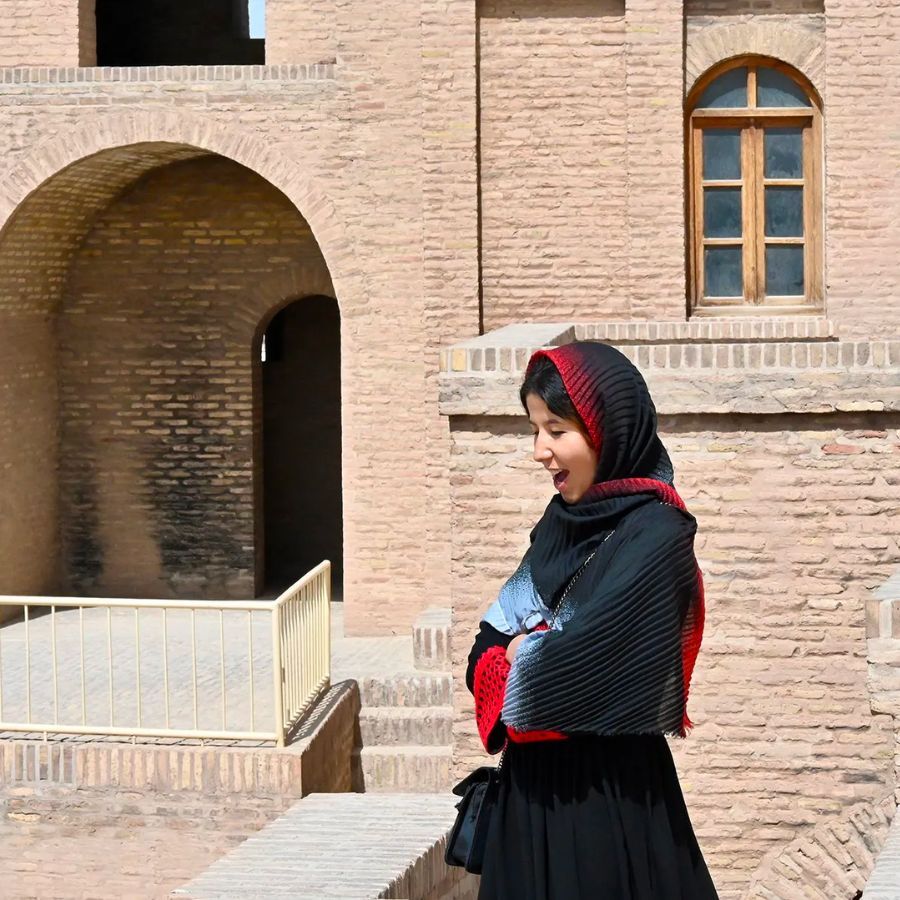
Afghanistan’s First Female Travel Guide Is Giving a Virtual Tour of Herat
By Nicola Chilton
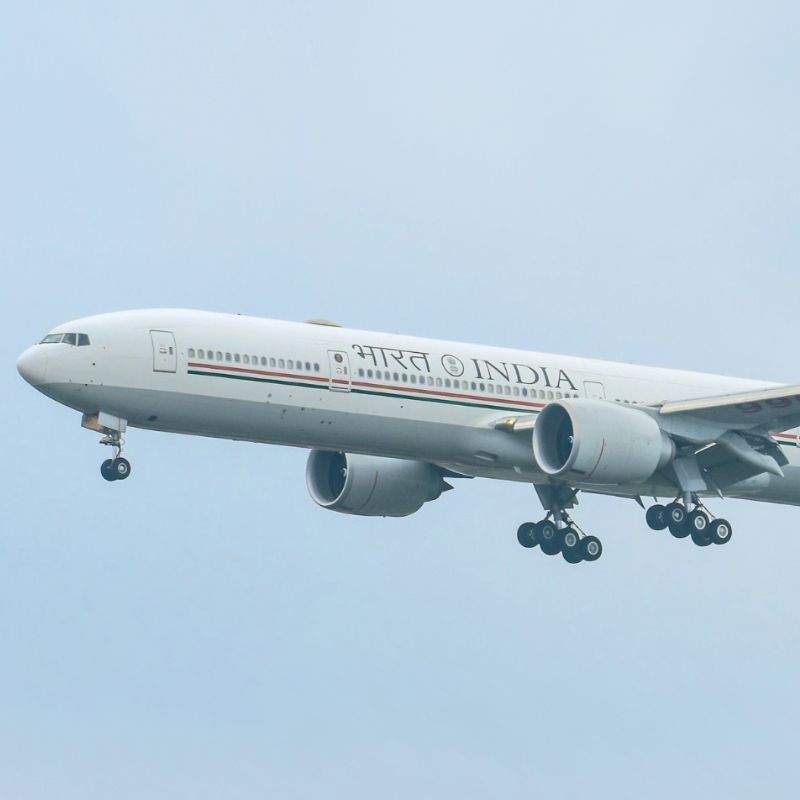
From The Skies To Diplomacy: All About The Planes Of Prominent World Leaders
By Priyaja Bakshi
Subscribe to our newsletter to get the latest on travel, stay & dining.

You’re all set
Thank you for your subscription.

Travel Guide
- Things to Do
- Getting Around
- Entry Requirements & Customs
- Tips on Dining
- Special-Interest Vacations
- Calendar of Events
- Staying Healthy
- Getting There
- Tips on Accommodations
- Escorted & Package Tours
- Sustainable Travel & Ecotourism
- Tips on Shopping
- Tips for Families
- Tips for Gay and Lesbian Travelers
- Tips for Senior Travelers
- Tips for Single Travelers
- Tips for Student Travelers
- Tips for Travelers with Disabilities
- Tips for Women Travelers
- Staying Connected
- Regions in Brief
- Suggested Itineraries
Sustainable Travel & Ecotourism in Thailand
Unfortunately, Thailand is way behind much of the world in general eco-awareness; conflicts between economic and ecological interests generally work out in favor of the former. Environmental problems include deforestation, air and water pollution, flooding, habitat loss, and consequent species loss. Among the 33 mammals in danger of extinction in Thailand are tigers, leopards, and elephants. The last of these is a particular shame, as it was once revered (and still is in some quarters) as a creature of great spiritual significance; the few thousand that remain spend their time either entertaining tourists at elephant camps or searching for food in a shrinking forest.
Fortunately, several nongovernment organizations (NGOs), such as the World Wildlife Fund, have an active presence in the country, attempting to draw attention to the most serious problems. Thai authorities are also finally taking tiny steps to preserve the nature and wildlife of its many different ecological zones, from swamp jungles in the south, to mountain forests in the north, to the many marine parks in the Gulf of Thailand and the Andaman Sea.
As the world's leading exporter of rice, Thailand is at the forefront of research into new strains of the crop that are both more nutritious and less harmful in terms of use of pesticides. More and more restaurants are serving brown rice as well as white rice. Also, look out for Doi Kham brand fruits, vegetables, juices, and preserves (on sale in many airports). These are products of the King's royal projects, which provide work for rural people while following organic farming principles.
Recycling in Thailand still refers to folks who go around buying up old papers, cans, and bottles, which they then sell for a pittance. Nowhere is trash separated at source before disposal. Your hotel may be your best bet for finding a place to deposit recyclable waste, especially if you choose a hotel that has instituted sustainable practices.
Visitors who choose to spend their time cycling, trekking, or kayaking in the kingdom inevitably have less detrimental impact on the country than those who breeze around in tour buses churning out carbon dioxide. However, choosing a responsible tour operator is not easy, as just about all of them these days use the buzzword "eco-tourism" in their sales pitches. Ask them exactly what they are doing to reduce their carbon footprint and to benefit the local community in the areas that their tours visit. For a list of local green operators, contact the Thai Ecotourism and Adventure Travel Association (tel. 02642-5465; www.teata.or.th ).
Some hotel groups, such as the Banyan Tree resorts in Bangkok and Phuket, have made huge efforts over the past decade to implement sustainable projects, including a pledge to reduce their carbon footprint in all their resorts by 10% each year.
When booking hotels, particularly on the beach, consider carefully whether you really need a room with air-conditioning and other power-draining equipment such as fridges, TVs, and DVD players. These days many eco-friendly, luxury resorts do not offer air-conditioning; instead, they provide well-designed, wooden bungalows with balconies that attract a delicious breeze, allowing you to appreciate your surroundings more than in an enclosed room, and mosquito nets over the beds can save you from nighttime discomfort. You can also sleep more soundly knowing your stay is making minimal impact on the environment.
In more than 110 national parks, visitors can see the local wildlife species in residence, as well as appreciate the delicate balance of each habitat. The more popular parks have clearly displayed interpretation facilities at their visitor centers, as well as trails with bridges and catwalks, and markers explaining the important elements of the environment and its inhabitants. They also provide log-cabin-style bungalow accommodations, plus tents and supplies for campers. Get in touch with the Department of National Parks at tel. 02561-0777, or visit their website ( www.dnp.go.th/parkreserve/nationalpark.asp ), where you can find information about the parks and also make online reservations.
General Resources for Green Travel
Responsible Travel ( www.responsibletravel.com ) is a great source of sustainable travel ideas; the site is run by a spokesperson for ethical tourism in the travel industry. Sustainable Travel International ( www.sustainabletravelinternational.org ) promotes ethical tourism practices, and manages an extensive directory of sustainable properties and tour operators around the world.
Carbonfund ( www.carbonfund.org ), TerraPass ( www.terrapass.org ), and Carbon Neutral ( www.carbonneutral.org ) provide info on "carbon offsetting," or offsetting the greenhouse gas emitted during flights.
For information on animal-friendly issues throughout the world, visit Tread Lightly ( www.treadlightly.org ).
Note : This information was accurate when it was published, but can change without notice. Please be sure to confirm all rates and details directly with the companies in question before planning your trip.

- All Regions
- Australia & South Pacific
- Caribbean & Atlantic
- Central & South America
- Middle East & Africa
- North America
- Washington, D.C.
- San Francisco
- New York City
- Los Angeles
- Arts & Culture
- Beach & Water Sports
- Local Experiences
- Food & Drink
- Outdoor & Adventure
- National Parks
- Winter Sports
- Travelers with Disabilities
- Family & Kids
- All Slideshows
- Hotel Deals
- Car Rentals
- Flight Alerts
- Credit Cards & Loyalty Points
- Cruise News
- Entry Requirements & Customs
- Car, Bus, Rail News
- Money & Fees
- Health, Insurance, Security
- Packing & Luggage
- -Arthur Frommer Online
- -Passportable
- Road Trip Guides
- Alaska Made Easy
- Great Vacation Ideas in the U.S.A.
- Best of the Caribbean
- Best of Mexico
- Cruise Inspiration
- Best Places to Go 2024

Ecotourism in Thailand -How to Have a Sustainable Travel Experience-
If you are planning a vacation in Thailand in the near future, there are many options for a more sustainable travel experience here. While Thailand has been popular with young backpackers for decades, it’s now becoming a great South-East Asian sustainable travel destination. Ecotourism in Thailand offers you the chance to experience the natural beauty of the land without disturbing the country you are visiting. Ecotourism aims to leave a destination just as you found it when you first arrived there.
About Ecotourism in Thailand

Sustainable travel has become increasingly popular in Thailand in recent years, thanks to its stunning natural destinations. Certain areas of Thailand, such as Koh Phangan, Bangkok, and Phuket, have been crowded with tourists for decades. The Thai government has even taken measures to reduce overcrowding in the country, closing the popular Maya Bay, which was featured in the movie The Beach, in 2018 to give the area a chance to recover.
Many travelers are looking for a more authentic and sustainable travel experience for their next vacation in Thailand, and want to spend time away from the crowds exploring the country’s UNESCO World Heritage sites and protected parks. Communities in areas such as Chiang Mai welcome tourists into their homes to experience their lifestyle and learn more about the local culture. Learning about the Hill Tribe culture is something more visitors are looking to do during their vacation in Thailand, and it helps to give back to the local community.
Thailand Ecotourism Initiatives

One area of concern surrounding tourism in Thailand is its elephant population. The Elephant Nature Park opened in the 1990s and offers a sanctuary for mistreated elephants. This sanctuary works to educate the population, and through their visitor and volunteer programs, it helps to look after these animals.
New Heaven Reef Conservation is a wonderful organization that is located on Koh Tao, a popular destination with divers. They work on a wide range of marine conservation activities and offer one-day experiences up to a full month program for visitors looking to enjoy a sustainable travel experience.
Trash Hero Thailand is a global NGO that originated in Thailand. During your vacation in Thailand, consider joining the local community in their activities with Trash Hero Thailand, which aim to unite locals and tourists to look after the land.
Unique Ecotours in Thailand
When planning your next vacation in Thailand, consider one of these unique, sustainable travel experiences. Chang Thun Village is located in Trat Province, which is about four and a half hours from Bangkok, and offers Community Based Tourism, which is where visitors engage in the traditional practices of the region. This works to preserve the local community, and the program is managed by the community itself.
If you are heading to Chiang Rai, which is just three hours away from Chiang Mai, the Phu Rua Highland Agricultural Research Station is an agrotourism center where you can experience local farm life and tour their facilities. You’ll learn more about the Hill Tribe plantations while giving back and assisting the local community during your time on the farm. During an agrotourism tour, you can also learn traditional Thai cooking skills and finish off your night staying in a mud house. All of these sustainable travel initiatives work with the local community, and the fees you pay all return back to the people you are staying with. When planning your future vacation in Thailand, head off the beaten path and consider searching for a more sustainable travel experience. These organizations listed above all work with local communities to preserve the land and leave it in as good condition as you found it. Would you like to know more about eco-friendly travel? To receive inspiration direct to your email inbox, please click here and subscribe to the Ecotourism World newsletter!

You May Also Like

Your Environment-Friendly Singapore Vacation

Sustainable Tourism and Community Development in Jeju Island, South Korea

An Unforgettable Eco-Friendly Trip to Cambodia

What Is Sustainable Tourism in Thailand?
As an expat living in Thailand for over 20 years, I’ve been amazed to witness firsthand the country’s efforts to preserve its spectacular natural landscapes, vibrant culture, and welcoming communities for future generations. With tourism numbers rising rapidly to nearly 40 million in 2019, Thailand has cemented itself as a top destination for its gorgeous beaches, dynamic cities, warm hospitality, and world-famous cuisine. However, the increasing popularity has inevitably caused growing pains and sustainability challenges.
Key Takeaways
- Thailand has implemented impressive sustainability initiatives to protect destinations from over-tourism while supporting local communities
- Travelers must show respect for Thai culture and people, follow appropriate conduct when visiting temples, and dress modestly
- Simple yet impactful efforts like minimizing plastic use, taking public transport, and not littering can drastically reduce environmental footprint
Exploring Thailand Responsibly: A Guide to Sustainable Travel
From speaking to local Thai friends, I’ve come to better understand the complex balancing act required to manage responsible tourism growth while allowing communities to benefit economically. There are always improvements to be made, but I’m continually impressed by Thailand’s proactive initiatives, from both governmental policies and conscientious businesses, to tackle issues head-on through smart regulations and incentives promoting environmental awareness. As travelers, it’s also our responsibility to educate ourselves on how we can positively contribute during our stays by making ethical choices.
Thailand Leading Sustainability Efforts in Southeast Asia
Over the past decade, Thailand’s government and local authorities have implemented diverse sustainability programs showing their commitment to protecting destinations from overtourism , while allowing visitors to keep enjoying the beauty of the Land of Smiles for years to come.
Popular initiatives include:
- Temporarily closing world-famous Maya Bay after extensive ecological damage, allowing native wildlife and coral reefs time to recover
- Banning smoking on many of Thailand’s top beaches to reduce pollution and cigarette waste
- Eliminating single-use plastics from national parks to cut down on trash overflow
Thai tourism businesses have followed suit by incorporating eco-friendly practices into their operations. For example, an explosion of environment and wildlife conservation projects allow travelers to contribute directly to critical research studies, protection programs, and rehabilitation centers focused on everything from marine life to elephants.
Resorts are ramping up sustainability efforts through renewable energy sources, local hiring, and profit shares funding local schools and temples. Eco-hotels certified by Green Hotel Standards help visitors easily identify properties committed to responsible water, waste and energy usage.
8 Ways Tourists Can Travel Conscientiously in Thailand
While systemic changes are essential, individual tourist choices before and during trips also make a monumental difference. By taking responsibility for our own environmental and cultural footprints, we show respect for the Land of Smiles and ensure our welcome lasts for generations more.
As Thailand’s tourism ministry urges, remembering simple mottoes like “Reduce, Reuse, Recycle” drastically helps to protect the country’s future.
1. Minimize Plastic Consumption
Avoid purchasing water bottles and instead carry a reusable container that can be endlessly refilled. Stylish options made of stainless steel, glass, and BPA-free plastics are perfect for staving off dehydration in Thailand’s tropical climate.
2. Dress and Act Appropriately When Visiting Temples
Cover shoulders and knees out of deference when entering sacred sites like the Grand Palace and Wat Pho in Bangkok . Shoes should be removed before entering structures with Buddha images, with feet pointing away.
3. Support Social Enterprises Empowering Local Artisans
Beautiful Thai handicrafts like ceramics, textiles, and carvings make wonderful mementos. Seek out fair-trade certified shops directly benefiting artists and ethical cooperatives like Thai Craft Fair Trade .
4. Take Public Transportation Over Private
Opt for public ferries, trains, and buses instead of chartered transport like taxis and tuk-tuks. This cuts down on traffic congestion and emissions, while allowing money to go towards municipal infrastructure improvements.

5. Don’t Discard Waste Irresponsibly on Land or Sea
Littering remains a huge problem, severely impacting Thailand’s otherwise idyllic landscapes. Dispose all trash appropriately in bins. When swimming or snorkeling, don’t touch or stand on delicate coral reefs.
6. Frequent Local Restaurants and Shops
Venturing to smaller family-owned establishments puts more tourist dollars directly into local communities compared to big chains. Chat with owners to discover hidden gems travelers normally miss. Food tours and cooking classes are fantastic for trying authentic dishes you can recreate at home.
7. Contribute to Community Development Initiatives
Many grassroots non-profits across Thailand like OpenMind Projects work tirelessly to support vulnerable groups with vocational training, education scholarships, childcare, and counseling services. Volunteer time or donate if possible.
8. Visit National Parks and Protected Areas Respectfully
Thailand contains stunning natural environments boasting indigenous species found nowhere else on Earth. Prevent disturbances by not feeding or getting too close to wildlife. Making purchases from local stores instead of bringing food helps remote communities.
While Thailand faces ongoing tourism challenges, clear improvements continue being made as visitors increasingly demand sustainable travel options. By taking simple actions ourselves and voting with our wallets to support conscientious businesses, we can positively shape the industry landscape for decades to come. With some planning and cultural awareness, Thailand offers endless possibilities for unforgettable and ethical trips of a lifetime.
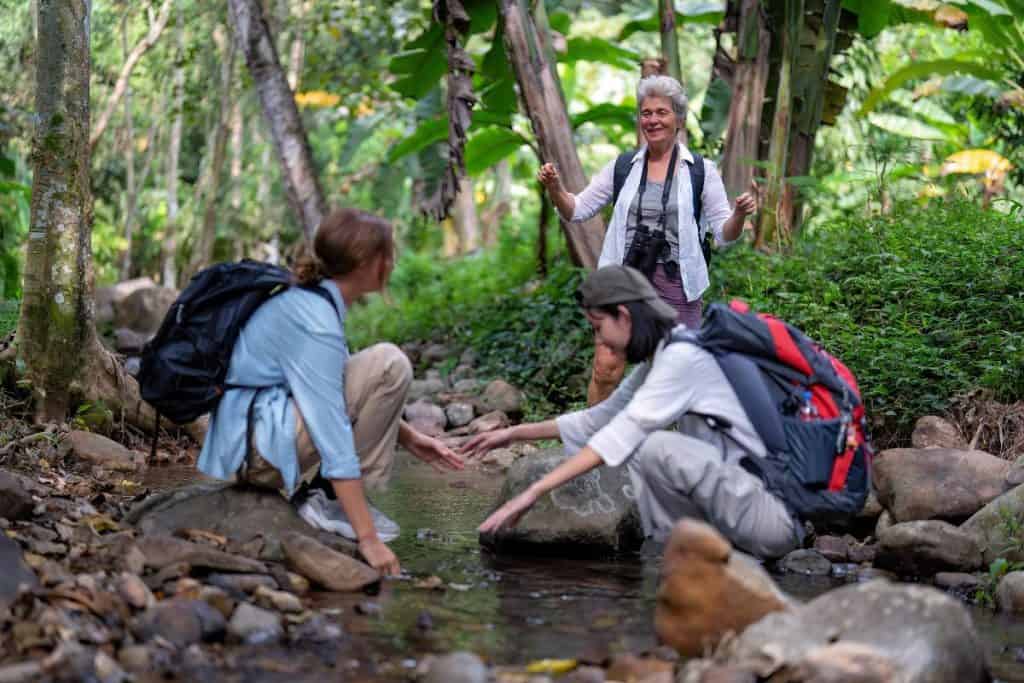
What exactly is community-based tourism in Thailand?
Community-based tourism refers to tourist activities, accommodations and services that directly benefit rural villages, tribes and local cooperatives. Income goes straight to families instead of outside companies.
How can travelers avoid unethical elephant attractions?
Do extensive research beforehand on elephant camps, avoiding venues allowing riding or bathing interactions. Support reputable sanctuaries like Elephant Nature Park focused exclusively on protection.
Why is it important to dress appropriately in Thailand?
Thais deeply value modesty and etiquette. Avoid revealing clothing when away from beaches. Both women and men should cover shoulders and knees when sightseeing, especially at sacred landmarks.
What eco-friendly certifications help identify sustainable hotels?
Resorts and hotels displaying credentials like Green Hotel Standards or Thailand Tourism Awards pass rigorous assessments across environmental and social criteria. This makes selecting responsibly straightforward.
What should someone visiting Thailand for the first time absolutely experience?
Nothing showcases Thailand better than its legendary food culture. Sign up for a cooking class or food tour in Bangkok, Chiang Mai or beach destinations to master flavorful dishes and appreciate intricate culinary craft.
I hope this overview has provided helpful tips for traveling respectfully and sustainably in captivating Thailand. Preserving this welcoming country’s cultural and environmental wonders for future generations is a shared priority.
If you have any other questions while planning your ethical adventures, from personalized trip advice to simply exchanging ideas on supporting local communities, I’m always happy to help however I can. Please subscribe to our newsletter or contact us if you’d like to continue the conversation.
Wishing you safe and meaningful journeys ahead. Through understanding and making mindful choices as tourists, we can protect the treasures of the Land of Smiles. I look forward to seeing Thailand prosper for years to come!
Similar Posts

Bridging the Gap: Thai Traditional and Modern Medicine

Thailand’s Temples: Beautiful Temples To Visit in Thailand

Thailand Public Holidays Guide: For Expats

Lifelong Learning Thailand As An Expat

Vocational Training Thailand: What Is It?

A Journey Through Thai Superstitions and Beliefs

Sustainable Travel in Phuket: Eco-Friendly Activities and Accommodations
Thailand’s picturesque island of Phuket has long been a sought-after destination for travelers seeking sun, sea, and relaxation. However, with the increased tourism comes the responsibility of maintaining and preserving its natural beauty. This article will explore sustainable travel options in Phuket, focusing on eco-friendly activities and accommodations that prioritise environmental conservation and support local communities. By making conscious choices, you can enjoy an unforgettable vacation while minimising your environmental impact.
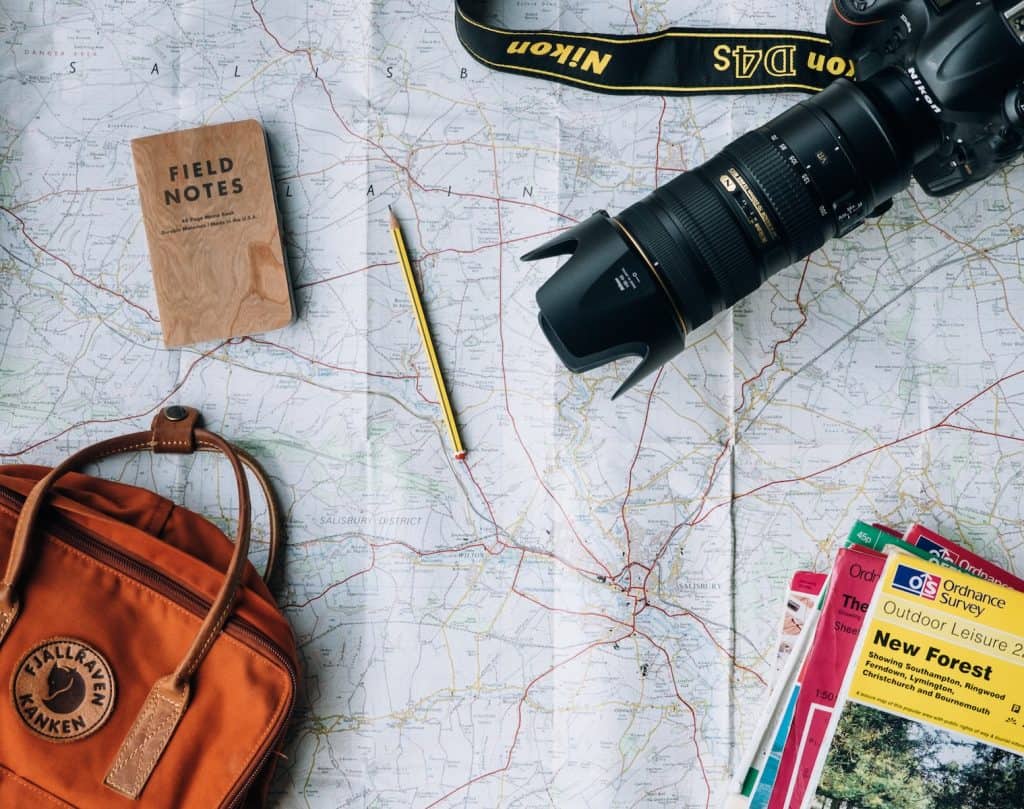
The Importance of Sustainable Travel in Phuket
The impact of mass tourism on the environment and local communities Mass tourism can have detrimental effects on Phuket’s environment and local communities. The influx of visitors can strain resources such as water and energy, generate pollution, and contribute to habitat destruction. Moreover, local communities can face increased cost of living and cultural dilution. By opting for sustainable travel, you can help mitigate these adverse effects on tourists and ensure that Phuket remains a thriving paradise for future generations.
The role of sustainable travel in preserving Phuket’s natural beauty and culture Sustainable travel encourages responsible tourism practices that protect the environment and promote socio-cultural and economic benefits for local communities. By supporting eco-friendly businesses and engaging in sustainable activities, travellers can contribute to the preservation of Phuket’s unique landscapes, vibrant culture, and rich biodiversity, ensuring that the island remains an idyllic destination for years to come.
The benefits of eco-friendly travel choices for travellers and the environment Choosing eco-friendly travel options can enhance your travel experience by deepening your connection with nature and local communities. Additionally, sustainable choices help conserve resources, reduce pollution, and promote biodiversity, ultimately contributing to a healthier environment for both travellers and residents.
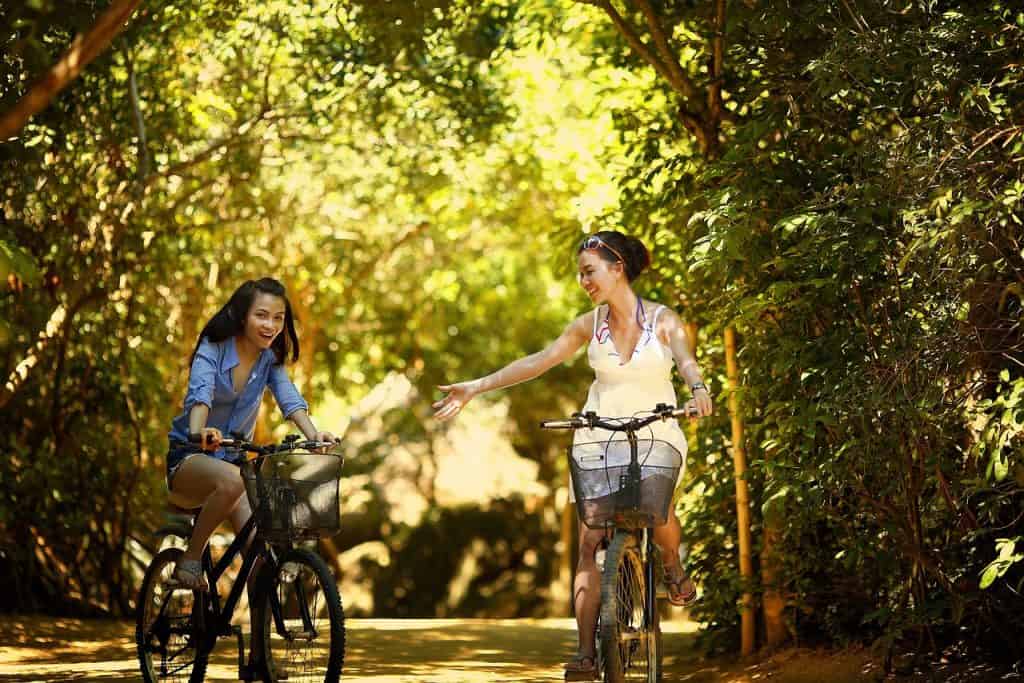
Eco-Friendly Activities in Phuket
Snorkeling and scuba diving with responsible tour operators Responsible snorkeling and scuba diving operators prioritise coral reef conservation and adhere to strict guidelines to minimize environmental impacts. By choosing eco-conscious operators, you can explore Phuket’s mesmerising underwater world without harming marine ecosystems. Participating in reef clean-up dives and citizen science projects can further support conservation efforts and enhance your experience.
Exploring Phuket’s natural wonders through eco-tourism Phuket offers several eco-tourism opportunities that allow you to immerse yourself in its breathtaking natural surroundings. Hike through the lush Khao Phra Thaeo National Park , guided by knowledgeable locals who can share insights on the region’s flora and fauna. Visit the Gibbon Rehabilitation Project to learn about the rescue and rehabilitation of these endangered primates. Alternatively, kayak through the mesmerising mangroves at Ao Phang Nga National Park, a serene and eco-friendly way to appreciate the area’s diverse ecosystems.
Sustainable island hopping and sailing When embarking on island-hopping excursions, opt for small-group tours or eco-friendly boat charters that minimize environmental impact. Responsible operators follow guidelines for waste disposal, noise pollution, and wildlife-watching practices, ensuring a more sustainable experience. By with sea turtles and supporting marine conservation initiatives, you can contribute to the preservation of Phuket’s exquisite marine environment.
Eco-friendly cooking classes and organic farm tours Phuket’s rich culinary tradition is best experienced through organic cooking classes that source ingredients from local farms. These classes teach traditional recipes while emphasizing sustainable farming practices, supporting local farmers and reducing food miles. Visiting organic farms allows you to learn about sustainable agriculture, sample fresh produce, and connect with the land in a meaningful way.
Green Accommodations in Phuket
Choosing eco-friendly resorts and hotels When selecting accommodations, look for properties with environmental certifications and sustainable practices. These establishments often prioritize energy and water conservation, waste reduction, and use eco-friendly materials. Examples of eco-conscious resorts in Phuket include The Slate, Keemala, and Six Senses Yao Noi, which offer luxurious stays while minimizing their environmental footprint.
Staying in eco-lodges and boutique hotels Smaller properties such as eco-lodges and boutique hotels often emphasize sustainability and community involvement. These accommodations integrate green practices and support local artisans, farmers, and businesses. Some notable sustainable boutique hotels in Phuket are The Naka Island, Anantara Layan Phuket Resort, and The Surin, which provide unique experiences without compromising their eco-friendly principles.
Opting for eco-friendly homestays and guesthouses For a more immersive cultural experience, consider staying at eco-friendly homestays and guesthouses that support community-based tourism initiatives. These accommodations offer authentic local experiences and often prioritize sustainability through practices like rainwater harvesting, solar power, and organic gardening. Examples of sustainable homestays in Phuket include Ban Raya Homestay, Patong Hillside Homestay, and The Memory at On On Hotel.
Tips for Sustainable Travel in Phuket
Reducing your carbon footprint To minimize your environmental impact while exploring Phuket, consider using public transportation, biking, or walking instead of renting a private vehicle. This not only helps reduce emissions but also allows for a more authentic experience. When flying to and from Phuket, opt for direct flights to reduce your carbon emissions, and consider offsetting your flights’ carbon footprint through verified carbon offset projects.
Supporting local businesses and communities Engage with the local community by dining at locally-owned restaurants and purchasing souvenirs from local artisans. This helps support the local economy and promotes cultural exchange. By using local people and participating in community-based tourism initiatives and cultural experiences, you can contribute to the preservation of Phuket’s rich heritage and traditions.
Practicing responsible tourism Being a responsible tourist means respecting local customs, wildlife, and the environment. Avoid using single-use plastics, dispose of waste properly, and refrain from touching or stepping on coral reefs while snorkeling or diving. Educate yourself about ethical tourism practices and make informed decisions to ensure your travel choices are in line with sustainable principles.
Sustainable travel in Phuket is not only possible but essential for the long-term preservation of the island’s unique environment and culture. By choosing eco-friendly activities and accommodations, supporting local communities, and practicing responsible tourism, you can play a vital role in safeguarding Phuket’s natural beauty and cultural heritage for future generations to enjoy. Get more Thailand Travel Tips here .
Sustainable Travel in Phuket FAQ’s
What is the impact of mass tourism on phuket’s environment and local communities.
Mass tourism can strain resources of local population like water and energy, generate pollution, contribute to habitat destruction, increase the cost of living for locals, and dilute their culture.
How does sustainable travel help preserve Phuket’s natural beauty and culture?
Sustainable travel encourages responsible practices that protect the environment, promote socio-cultural and economic benefits for international travellers and local communities, and contribute to the preservation of the island’s landscapes, culture, and biodiversity.
What should I look for when choosing an eco-friendly snorkeling or scuba diving tour operator?
Opt for operators who prioritize coral reef conservation, adhere to strict guidelines, and offer reef clean-up dives or citizen science projects to support the marine life and ecosystems.
What are some eco-friendly activities to enjoy in Phuket?
Examples include hiking in Khao Phra Thaeo National Park, visiting the Gibbon Rehabilitation Project, kayaking through Ao Phang Nga National Park’s mangroves, and participating in organic cooking classes.
How can I identify eco-friendly accommodations in Phuket?
Look for properties with environmental certifications, sustainable practices, and a commitment to supporting local communities and businesses.
What are some examples of eco-friendly resorts, boutique hotels, and homestays in Phuket?
Examples include The Slate, Keemala, Six Senses Yao Noi, The Naka Island, Anantara Layan Phuket Resort, The Surin, Ban Raya Homestay, Patong Hillside Homestay, and The Memory at On On Hotel.
How can I reduce my carbon footprint while traveling in Phuket?
Use public transportation, bike, or walk when possible, choose direct flights, and consider offsetting your flights’ carbon emissions through verified carbon offset projects.
How can I support local businesses and communities in Phuket?
Dine at locally-owned restaurants, purchase souvenirs from local artisans, and participate in community-based tourism initiatives and cultural experiences.
What are some responsible tourism practices I should follow in Phuket?
Avoid single-use plastics, properly dispose of waste, respect local customs and wildlife, and educate yourself about ethical tourism practices to make informed decisions.
Why is it important to choose eco-friendly activities and accommodations in Phuket?
By opting for sustainable options, you can minimize your environmental impact, support local communities, and contribute to the long-term preservation of Phuket’s unique environment and culture.

Lisa Boonmee
Are you looking to retire in phuket, the ultimate guide to vegan and vegetarian dining in phuket.
GREEN PEARLS® – UNIQUE PLACES
Sustainable travel in Thailand – green initiatives and hotel projects

Thailand is one of the most popular destinations in the world and invites with white beaches and turquoise sea. Sustainable travel in Thailand is becoming increasingly popular. We are especially happy to see that there are not only many tourists, but also more and more green projects. Here we present two Green Pearls® hotels and their sustainable concepts and initiatives.
Recycling projects in Thailand
Did you know that the Asian country implemented a nationwide ban on single-use plastic bags in January 2020? Thailand also wants to stop producing polystyrene food containers, plastic straws, and plastic cups by the end of 2022. The plastic problem received enormous media attention thanks to pictures showing the plastic-filled intestines of Thailand’s popular marine mammal, the dugong. But things are changing: projects such as “Net Free Seas”, for example, are committed to plastic-free seas. In cooperation with local fishermen, ghost nets are being collected and recycled. These nets are then used, for example, to produce creative products such as protective visors against covid-19 disease made by the Qualy brand. You may already be familiar with the organization Trash Heroes, which organizes beach cleanups around the world. The heroes also work with Tlejourn Shoes, for example. Through the project, collected recycled marine waste is turned into shoe soles for flip-flops.
Clean beach at Zeavola
Beach cleanups are also happening at the sustainable Zeavola Resort . Every day, employees and people from the local community work together to clean the beach. The trash that is collected is then disposed of separately in Phuket. Meanwhile, the collected organic waste ends up in the resort’s garden as fertilizer. On Koh Phi Phi, too, true garbage dumps can be found under the surface of the sea. This is why diving teams regularly clean the coral reef near the eco-resort. You can help out if you want. By the way, there are no plastic bottles at the resort. All drinking water is self-produced and bottled in reusable glass bottles.

Plastic ban in the hotel
At Tongsai Bay , there is even a plastic ban for the entire hotel. As an alternative to plastic straws, the hotel uses lemongrass as an alternative. Here, too, organic waste is recycled as fertilizer for the hotel’s own garden and the remaining waste is separated. The hotel makes its own cleaning agent for the bathrooms from fermented pineapple peel. This means that no chemicals end up in the wastewater. When you treat yourself in the spa with a scrub, coffee grounds are used for this purpose. By the way, this is also a great beauty and recycling tip to use at home. So it’s always worth considering what else you can do with so-called waste.
Read more: THAILAND GOES GREEN: SUSTAINABILITY WITH HISTORY
Do you like the article? Share it!

Related Posts

More than waste: Sustainable Gastronomy
Tomorrow we celebrate “Sustainable Gastronomy Day”, which was launched by the UN. For us, sustainability is an important topic in all areas of life — as well as for our Green Pearls® partner hotels. Our hoteliers understand the importance of agriculture and food for the […]

Eco wedding: rites and ceremonies in the Indian Ocean
Have you always dreamed of a beach eco wedding? Fortunately, such symbolic ceremonies abroad are no longer uncommon these days. Barefoot in the sand or under palm trees – we introduce you to five very special locations that host traditional ceremonies and ensure you unforgettable […]
2 thoughts on “Sustainable travel in Thailand – green initiatives and hotel projects”
- Pingback: sustainable tourism - good perspectives - Green Pearls® Hotels
- Pingback: Support sustainable projects while on vacation - where it's possible
Leave a Reply Cancel reply
Your email address will not be published. Required fields are marked *

- Data Privacy Policy
Stay in touch
Love to travel green subscribe here to our newsletter and get travel inspirations to spark your wanderlust directly to your inbox..
- Circular Economy
- Manufacture
- Hospitality
- Institution
- Humanitarian Aid disaster relief
- Environment and climate protection
- Animal and species protection
- Education and culture Support
Sustainable Travel Destinations in Thailand: Giving Back to the Environment
- by KIND Global
- August 25, 2023 August 20, 2023
- Environmental protection , News , Tourism
Sustainable Travel Destinations in Thailand: Giving Back to the Environment Through KIND Global
Sustainable Travel: Thailand, with its rich cultural heritage, stunning landscapes, and vibrant cities, has long been a top destination for travelers seeking diverse experiences. In recent years, the concept of sustainable travel has gained traction, encouraging tourists to not only enjoy their trips but also contribute positively to the environment. KIND Global, an innovative platform, offers travelers the opportunity to make passive donations to environmental causes. This report highlights some of the best travel destinations in Thailand that align with sustainable travel principles and outlines ways to give back while exploring these destinations.
1. Chiang Mai: Embrace Nature and Local Culture: Chiang Mai, nestled in northern Thailand, offers a blend of natural beauty and cultural experiences. Travelers can visit ethical elephant sanctuaries, which promote responsible elephant tourism and conservation efforts. Additionally, they can explore local markets, support traditional handicrafts, and participate in community-based tourism initiatives that benefit local communities.

2. Phuket: Coastal Beauty with a Purpose: Phuket, known for its picturesque beaches, offers opportunities to support marine conservation. Travelers can participate in beach clean-up activities, snorkel in marine-protected areas, and engage in coral reef restoration projects. KIND Global’s passive donation feature can enhance these efforts by contributing to organizations dedicated to preserving the marine ecosystem.
3. Koh Lanta: Eco-Friendly Island Getaway: Koh Lanta is a prime example of sustainable island tourism. With a focus on eco-friendly accommodations, renewable energy initiatives, and community-driven projects, travelers can enjoy a serene getaway while minimizing their environmental footprint. By utilizing KIND Global’s platform, they can contribute to local initiatives aimed at maintaining the island’s ecological balance.
4. Bangkok: Urban Exploration and Social Impact: Bangkok, Thailand’s bustling capital , offers a unique blend of cultural heritage and modern experiences. Travelers can support local social enterprises, visit ethical markets, and participate in community projects that address urban challenges. KIND Global’s passive donation mechanism can amplify the impact of these endeavors, benefiting marginalized communities.
5. Khao Sok National Park: Nature Conservation and Adventure: Khao Sok National Park showcases Thailand’s natural beauty and biodiversity. Travelers can participate in ecotourism activities such as guided jungle treks, wildlife watching, and responsible kayaking. Partnering with KIND Global can facilitate passive contributions to conservation efforts that protect the park’s pristine ecosystem.
Find the dream trip for you on Booking.com

Conclusion: Sustainable travel in Thailand goes beyond enjoying picturesque landscapes and immersing oneself in local culture. It encompasses a commitment to leaving a positive impact on the environment and communities visited. By exploring destinations like Chiang Mai, Phuket, Koh Lanta, Bangkok, and Khao Sok National Park, travelers can contribute to local conservation and community development initiatives. KIND Global’s passive donation platform further enhances these efforts, providing an avenue for travelers to give back while creating lasting memories. Additionally, responsible travel practices, such as not leaving garbage in nature, are crucial to preserving the beauty of Thailand’s destinations for future generations. Through these combined efforts, travelers can ensure that their experiences enrich both themselves and the places they explore.
Author: KIND Global
Director from KIND Global
Leave a Reply Cancel reply
Your email address will not be published. Required fields are marked *
Save my name, email, and website in this browser for the next time I comment.
-cutout.png)
SMU Economics Intelligence Club
- Jun 21, 2023
- 11 min read
Thriving with Nature: Exploring Ecotourism in Thailand
Written by Li Laiyi and Woon Shijie , with inputs from Ng Yu Kang

Executive Summary
The reopening of Thailand’s international borders in the post-pandemic era has heralded a new direction of tourism, one that is aligned with safe and sustainable travel. Overall, Thailand’s tourism industry has bounced back through the adoption of ecotourism. First, we seek to explore Thailand’s commitment to sustaining ecotourism under its Bio-Circular-Green (BCG) model, along with its significant schemes. Given that Thailand’s tourism sector is a significant contributor to its Gross Domestic Product (GDP), we would then examine the positive economic impact brought about by Thailand’s move into ecotourism as well as its accompanying limitations.
Thailand is in a good position to take advantage of the move, given the intersections between a high reliance on tourism, as well as 21st century trends. Already, we are seeing success in job creation and growth. However, it is equally crucial for the Thai government to sustain its progress by acknowledging and addressing limitations that threaten its long-term prospects, such as those of overcrowding, ecotourism’s high vulnerability to disasters, and greenwashing. Moving forward, we have suggested standards and frameworks for Thailand to secure the profits of a sustainable eco-tourism sector in the long run.
Introduction to Ecotourism in Thailand
Ecotourism: What is it all about?
Ecotourism is a “form of tourism that attempts to take responsibility for its current and future economic, social, and environmental impacts, by looking at the needs of visitors, the industry, the environment, and host communities”. Around the globe, ecotourism is rising in demand and popularity, with over 80% of global travellers believing that ecotourism is important to counter the adverse impacts of tourism. With the growing availability of eco-friendly tourist accommodations and activities, given its environmental sustainability and enhanced travel experiences, the global ecotourism market is expected to reach an astounding USD526.16bn by 2027 with a compound annual growth rate (CAGR) of 14.24%.
Ecotourism in Thailand and the Bio-Circular-Green (BCG) model
Tourism is especially significant in Thailand, being one of the world’s leading travel destinations known for its rich historical sites, unique culture, and delectable local cuisines and landscapes. Accounting for a fifth of its Gross Domestic Product (GDP) and about 20% of national employment , as well as knock-on impacts on informal sectors, Thailand’s tourism industry is a major contributor to the country’s employment and economic wealth. Prior to the COVID-19 pandemic, Thailand received 39.8 million international visitors in 2019 alone and collected USD60.5bn in international tourism receipts. Tourist revenues were more than the likes of the United Kingdom, Germany, and Japan. As seen in Figure 1, Thailand’s tourism industry only seems to be growing exponentially from 2017 to 2019 with the total value of tourism’s contribution to Thailand’s GDP amounting to THB3028.78b in 2019, up until the 2020 pandemic-fuelled economic downturn, when Thailand’s GDP fell by about -6.1% y/y in 2020.

Post-Pandemic Tourism Revival: Going Green
The Thai government in 2021 announced plans to revive its tourism industry creatively in line with the Bio-Circular-Green (BCG) model , signalling Thailand’s commitment to furthering ecotourism in its national agenda following the COVID-19 pandemic. Spanning from 2021 to 2026, the BCG model seeks to aid in Thailand’s recovery post-pandemic while targeting global environmental concerns . Taking inspiration from the United Nations Sustainable Development Goals (SDGs), the BCG model capitalises on Thailand’s strengths in biological diversity and cultural richness to employ technology and innovation in promoting secondary cities and rural communities as tourism spots. They also target niche market segments such as wellness tourism and cultural tourism, in their bid to stimulate sustainable economic growth.
Being supported by both the abundance of natural resources and man-made infrastructure as important enablers, the Thai government has pushed for local tourism businesses to adopt the BCG model. In turn, businesses have generally responded positively .
Notable Schemes in Thailand
The UNESCO Sustainable Travel Pledge
In line with its existing ‘No Foam No Plastic’ initiative, Thailand has been the first country to implement the UNESCO Sustainable Travel Pledge nationwide , with more than 500 hotels signing the pledge to eliminate single-use plastic and promote local culture. The changing nature of business needs also leads to a shift along the supply chain needed to sustain regular operations. This has resulted in a diverse range of support coming from local businesses, and profits as well. The growth of eco-tourism is important not just for greater tourism revenues, but also to support the growth of local businesses and productive labour.
Greater local conservation through activities in Nature
Thailand, being home to a myriad of natural attractions, provides ample opportunities for visitors to engage more in local conservation and activities that promote sustainability. This includes activities such as interactions with the mistreated national animals.
At the elephants of Thailand’s Elephant Nature Park, for example, visitors can learn more about the endangered species. Meanwhile, the new heaven reef conservation program ensures visitors can experience first-hand the range of marine conservation activities, including the maintenance of coral reefs to caring for baby turtle hatchling s.
Community-based tourism
More importantly, the BCG model has made a major impact through its greater promotion of community-based tourism, a type of excursion created for tourists to experience local communities. Community-based tourism is often concentrated in rural areas, extending the benefits of tourism to areas that historically had lower footfall and income streams as well.
Collaborative initiatives under the BCG model such as the joint effort between the Tourism Authority of Thailand (TAT) and the Thai Organic Consumers Association (TOCA) seek to promote organic tourism. In Phuket, for example, tourists are able to learn more about organic farming first-hand and collect their own produce to cook - straight from farm to pot. Local restaurants and hotels in Thailand are also sourcing directly from organic farmers. These initiatives are in conjunction with TOCA’s current platform which allows businesses to order local produce and consumers to search for organic farms for farm tours and restaurants that source their ingredients from local farmers.
In the process, ‘Earth Points’ can be earned through greater eco-friendly contributions from both businesses and consumers in the formation and sustenance of an organic society while increasing tourism revenue. These ‘Earth Points’ can be fully redeemed for rewards and promotions on the TOCA platform, further incentivising sustainable practices through the TOCA platform.
This creates a gamified ecosystem that creates a greater appreciation for the environment and strengthens tourism sustainability. Overall, greater exposure of local communities to tourist and business traffic helps create more revenue streams for local farmers, and their communities.
Positive Economic Impact
Rise in GDP and job opportunities for Thais
Following Thailand’s committed move to ecotourism within its tourism sector, TAT hosted an “Amazing Thailand Countdown 2023” on Dec 22 to celebrate its tourism achievements going into the new year. Mr Yuthasak Supasorn, the TAT Governor, commented that Thailand’s tourism sector has generated THB1.5tr in total tourism revenue, half of the pre-pandemic level seen in 2019.
Despite not being at pre-pandemic levels, Thailand’s revitalised tourism sector has boosted its GDP to reach a +4.5% y/y expansion in 3Q22, going against the odds of rising inflation and the global economic slowdown .
The Thai economy is now “growing at an accelerating rate” according to Thailand’s National Economic and Social Development Council (NESDC) which is predicting further growth of +3% to +4% in 2023 . With the revival of tourist arrivals in Thailand in accordance with its BCG model, tourism in Thailand is expected to be among the main sectors to contribute to overall GDP growth once again. This is as it continues to strengthen in supporting jobs and incomes in related sectors as well.
Improved quality of life and income for local farmers
More specifically, given the greater prevalence of community-based tourism, greater income and work opportunities are automatically granted to local communities. The additional effects should not be understated. Tourism infrastructure is often a chicken-and-egg problem, with insufficient tourist amenities in rural areas often being a problem in raising revenues. However, through branding and natural tourism pipelines, Thailand is able to increase the amount of exposure and tourism less affluent communities receive without them supplying much capital in the first place. From these tourist activities, naturally, more hotels and restaurants can be set up, and survive. These benefits are further entrenched into local communities, for example when local farmers sell their produce to these establishments.
Eco-Tourism: Limitations and Challenges
Tourism is considered to be one of the most essential drivers of Thailand’s economic progress and in alleviating unemployment. Overall, Thailand is fortunate enough to have multiple geographical and comparative advantages in terms of lifestyle, culture, and food agronomy to make the sustainable tourism market a sizable one. However, eco-tourism comes with its own sets of limitations which must be addressed or at least mitigated by the public sector for continuity.
Overcrowding
Overcrowding is one of the major concerns for Eco-tourism , as it can lead to undesired impacts on the wildlife, habitats, eco-system and even the indigenous community living in the area. Greater exposure to untouched areas leaves an environmental footprint the area might not be sufficiently well-equipped to handle.
One prominent example would be the closure of Maya Bay on Koh Phi Phi in southern Thailand. It was a popular tourist destination for many years, known for its crystal-clear blue water, and towering limestone monoliths that have been worn by millions of years of seawater ebbing. Having this magnificent scene destroyed by tourists is considered by many to be heartbreaking. The effects are detrimental: in June 2000, 70-80% of the bay’s reef was intact. In 2018, less than 8% remained. Thai authorities had to resort to a closure of the bay in June 2018 for conservation efforts despite the large revenue it was generating for the country.
Fortunately, COVID-19 has allowed Thailand’s ecosystem to reset and recover in a more sustainable way. While COVID-19 has negative effects on Thailand’s tourism industry in terms of the economy, it provides plenty of opportunities for sustainability efforts in 2022, such as natural resource restoration. With the abundance of eco-tourism hotspots, the right question to ponder is not how natural resources can be recovered. But instead, how the recovered natural resources may be sustained in the long run.
The solution to sustained usage of natural resources to meet the demands of eco-tourists is through public sector strategy and action. Overcrowding is not the sole result of eco-tourism. Overcrowding is the result of unplanned and poor regulations, that prioritise maximising revenue over conservation. If organisations carry out their operations at the expense of the communities and indigenous people's way of living, Thailand can expect many recurrences of Maya Bay’s tragedy. Repeated offences might mean that rescue efforts may no longer suffice.
High Vulnerability to Natural and Human-Induced Hazards
Thailand is highly vulnerable to natural and human-induced hazards such as tsunamis, storms, droughts, landslides, forest fires and epidemics. The most recent trending disaster in Thailand is flooding. Despite the nature of the hazard, the number of casualties remains relatively high in the millions in regions since the 1990s. The areas being hit the hardest by the hazards are normally eco-tourist hot spots such as the Phuket Tsunami disaster in 2004.
While eco-tourism as a driver of growth is good news for the Thai economy, eco-tourism is highly prone to the effects of natural disasters. One event can lead to a loss of revenue lasting weeks or even months before tourists deem it safe to return. Thailand would also incur high costs to fund relief and restructuring efforts. Hence, it is crucial for the Thai government to consistently upgrade the country’s capital to dampen the effects of natural disasters on Thailand’s economic growth. Having strong industrial policy upgrades would also allow room for career mobility such that the employment rate does not take a sudden dip.
Some policy suggestions by the Asian Development Bank for Thailand include strengthening research and development to support technology absorption. While a reliance on tourism is not inherently wrong, the natural inherent risk means that aggressively diversifying through adopting high-growth sectors is important. With the increasing prevalence of natural disasters due to climate change, diversification becomes especially more pressing.
The Thai government can consider strategically positioning itself to promote the country as a high-tech centre and research base for global firms. This would entice more foreign direct investments which in turn generate more jobs and boost the Thai economy. However, climbing up the technological ladder also requires a simultaneous improvement in workers’ skill levels. It is crucial to increase availability and access to highly specialised vocational education and training and ensure that content is systematically aligned with industry needs. Nonetheless, over the past few decades, Thailand has established a robust manufacturing sector. The focus is on attracting investments for mid/high-tech manufacturing. One area that Thailand could exploit would be Electric Vehicles (EV) and other sustainable products, which align with the eco-tourism sector’s objective to better protect the environment. Already, there are plans to increase EV production to 30% of all cars by 2030. Thailand is also the world’s fifth-largest rare earth metals producer. As renewables become more widely produced due to the world’s quest for net-zero, and the West looking to diversify its renewable production sources outside of the Middle Kingdom, Thailand has a potential opportunity to increase its exports or move up the renewable supply chain with the abundance of these metals.
Greenwashing
Greenwashing is another prominent issue. Greenwashing is a practice in which businesses make false or misleading claims about their environmental practices to appeal to consumers. Unfortunately, greenwashing is a common practice in the tourism industry, including in Thailand's eco-tourism sector.
Naturally, the booming sector allows eco-tourism operators to reap high revenue and accelerate expansion. Hence, firms are more likely to jump onto the trend hoping to get a fair share of the eco-tourism business. Rushing into the sector with profits as the main objective, while neglecting the essence of sustainability, would inevitably cause greenwashing.
Fortunately, the Thai government launched a few initiatives to tackle the issue of greenwashing. One of the notable ones is the ‘GSTC-Recognized Standard’ status launched by the Global Sustainable Tourism Council. Attaining the GSTC-Recognized status signifies that a sustainable tourism standard has been reviewed by GSTC technical experts and the GSTC Accreditation Panel and deemed equivalent to the GSTC Criteria for sustainable tourism. This prevents firms from fabricating results as the certificate can only be achieved after an in-depth and comprehensive check by the experts. The GSTC programs serve to recognise genuine practitioners of sustainable tourism, which in turn builds confidence and credibility with consumers.
However, GSTC has its limitations. The GSTC uses a compliance-based approach, meaning that businesses are expected to meet specific requirements in order to be certified. While this approach can be useful in ensuring that businesses meet minimum standards, it may not necessarily encourage innovation or continuous improvement beyond the requirements of the standard. One possible outcome could be that thriving firms may not see the need to transition to cleaner energy or better environmental practices so long they can continue generating profits.
Moving Forward
To sum it up, a healthy and sustainable eco-tourism practice should aim to have the following:
Ensure sustainability by limiting the number of tourists in an area. This prevents overcrowding which can lead to detrimental damage to the environment as mentioned above. It did lead to the closure of popular tourist hot spots, taking a toll on Thailand’s eco-tourism revenue.
Maximise local economic benefits by including residents in projects, encouraging local investments and regulating foreign ones. Not only would an inclusive eco-tourism sector generate more jobs for the locals, but the Thai government could also better control the extent of exploitation of natural reserves when the operators are local as compared to when it is foreign companies. This includes fair distribution of the eco-tourism revenue to locals whose spaces were used in the process.
Regular collaboration between government officials and conservation groups. It is crucial to tap into the environmental knowledge and advice of non-governmental groups in the space. In doing so, it allows for the better and timely protection of the natural reserves. It adds resources and capital to groups already doing good work while reducing the need for more costly government intervention. Enhancing these synergies could strike a sustainable balance between economic growth and environmental protection.
While Thailand’s eco-tourism sector has its merits such as the abundance of guided environment tours, sustainable resorts and nature conservation, the country still has some ways to go. The introduction of Thailand’s Bio-Circular-Green Economy Model (BCG), which aims to use natural assets more efficiently with the least impact on the environment, is a good stepping stone moving forward for the eco-tourism sector. However, it is essential that the Thai government continues to ramp up efforts in protecting the country’s natural resources given the surge in tourists following China’s reopening. Moving forward, Thailand's sustainable tourism market size is estimated to grow tremendously at a 17.8% CAGR from 2022 to 2032, which represents nearly 3-4% of the share in the global tourism industry. Such a bright outlook for the eco-tourism market is not an opportunity to miss out on. With proper regulation and new initiatives, Thailand can anticipate many fruitful years ahead.
Li Laiyi is a Research Analyst covering Southeast Asia the SMU Economics Intelligence Club (SEIC) and a third-year social sciences undergraduate majoring in Politics, Law, and Economics.
Woon Shijie is a Research Analyst covering Southeast Asia at SEIC, and a second-year economics undergraduate.
Ng Yu Kang is the Director of the Southeast Asia desk at SEIC.
The views expressed are the authors’ own and do not represent the official position of the SMU Economics Intelligence Club. This article may not be reproduced without prior permission from SEIC and due credit to the author(s) and SEIC.
Recent Posts
Dollarisation in Argentina: A Mistargeted Silver Bullet
The 'Right' to Govern.
The Philippines Maharlika Investment Fund: Boon or Bane
TAT strengthens tourism sustainability commitment through low-carbon initiatives
Under an mou with the thailand greenhouse gas management organisation and thai ecotourism and adventure travel association.
Bangkok, 16 June, 2021 – The Tourism Authority of Thailand (TAT) recently signed a Memorandum of Understanding (MOU) with the Thailand Greenhouse Gas Management Organisation (TGO) and the Thai Ecotourism and Adventure Travel Association (TEATA) to promote low-carbon tourism and implementation of climate action for sustainability.
TAT Governor Mr. Yuthasak Supasorn said, “This MOU forms part of the TAT’s ongoing commitment to drive the Thai tourism industry towards safe and sustainable travel in line with Thailand’s Bio-Circular-Green or BCG Economic Model and the United Nations Sustainable Development Goals or SDGs. This is under the goal of making tourism part of Thailand’s commitment to reduce greenhouse gas emissions by no less than 50 million tons of carbon dioxide equivalents.”
TAT has been promoting awareness of green tourism with the long-established 7 Greens project.
Under the MOU, TAT will be prominently involved in technical workshops with the TGO and TEATA to enhance understanding of the impacts of climate change and to strengthen competency development of tourism industry members on low-carbon initiatives.
“TAT will also encourage tourists and travellers to support the sustainability of green tourism and enhance their travel experiences with a small or neutral carbon footprint towards the goals of achieving sustainable net-zero greenhouse gas emissions,” Mr. Yuthasak said.
The TGO, as the key agency on driving greenhouse gas mitigation in Thailand towards a sustainable low-carbon economy and society, has announced its commitment to taking part in any partnerships to promote implementation of greenhouse gas reduction activities in line with the BCG Economic Model.
TGO Director Mr. Kiatchai Maitriwong said, “Tourism is responsible for roughly 8 per cent of the world’s carbon emissions, and this MOU will lead the Thai tourism industry towards greater understanding of climate change and the implementation of actions to reduce greenhouse gas emissions from tourism.”
The TGO has already worked with the TEATA on a number of projects and initiatives, including the recent “Low-carbon Tourism” training on accounting the greenhouse gas emissions of business activities; such as, travelling, resource and energy consumption, camping, and waste.
Meanwhile, TEATA has been working with TAT and the TGO along with other tourism-related public and private organisations on a carbon balance project to create a carbon neutral tour programme, carbon neutral CBT village, carbon neutral tour company, and carbon neutral souvenir, as well as carbon offset schemes.
Based on the TAT’s 7 Greens project and TGO’s greenhouse gas mitigation guidelines, TEATA has created 5 carbon neutral routes, which are: Prachin Buri – Nakhon Nayok; Chiang Mai; Phuket – Phang Nga; Kanchanaburi, and Udon Thani – Nong Khai and Bueng Kan.
Each route corresponds with the TAT’s tourism development strategy under the BCG Economic Model, which focuses on five categories: wellness tourism, sports tourism, cultural tourism, ecotourism, and spiritual tourism.
TEATA President, Ms. Vasumon Netkijcharoen, said, “TEATA has been promoting neutral carbon tourism for the Thai tourism industry through our ongoing trainings and workshops on carbon offset schemes and the green economy. In addition, we are utilising the TGO’s carbon credit trading as a way of corporate social responsibility or CSR activities to create greater awareness on sustainable tourism and environmental conservation among customers.”
For more information on low-carbon tourism, visit the website: www.tourismthailand.org/7greens , or Facebook: 7greensThailand and TGO , or call the TAT Contact Centre 1672.
TAT Newsroom
Thailand covid-19 situation as of 16 june, 2021, 12.30 hrs, thailand covid-19 situation as of 17 june, 2021, 12.30 hrs, related articles.

‘ASEAN + India Shoppers in Thailand’ activity to boost Thai economy with soft power

Tourism Authority of Thailand invites travellers to experience the wonders of Songkran


STORIES OF THE PEOPLE, PLACES & PARTNERS THAT MAKE TRAVEL AND TOURISM TICK
- March 6, 2024
Biochar Carbon Removal Training in Thailand
- March 5, 2024
Kudos Carbon Offsetting Feature Demo
- January 31, 2024
Kudos Travel Technology’s integration with Sustainable Travel International’s Climate Impact API allows companies and individual employees to seamlessly offset their business travel carbon footprint from within the Kudos Travel Platform. This video provides a brief demo of the feature. Learn More
[Webinar Recording] Cleaning Our Skies: Innovative Solutions That Are Removing Carbon From the Air
- December 7, 2023
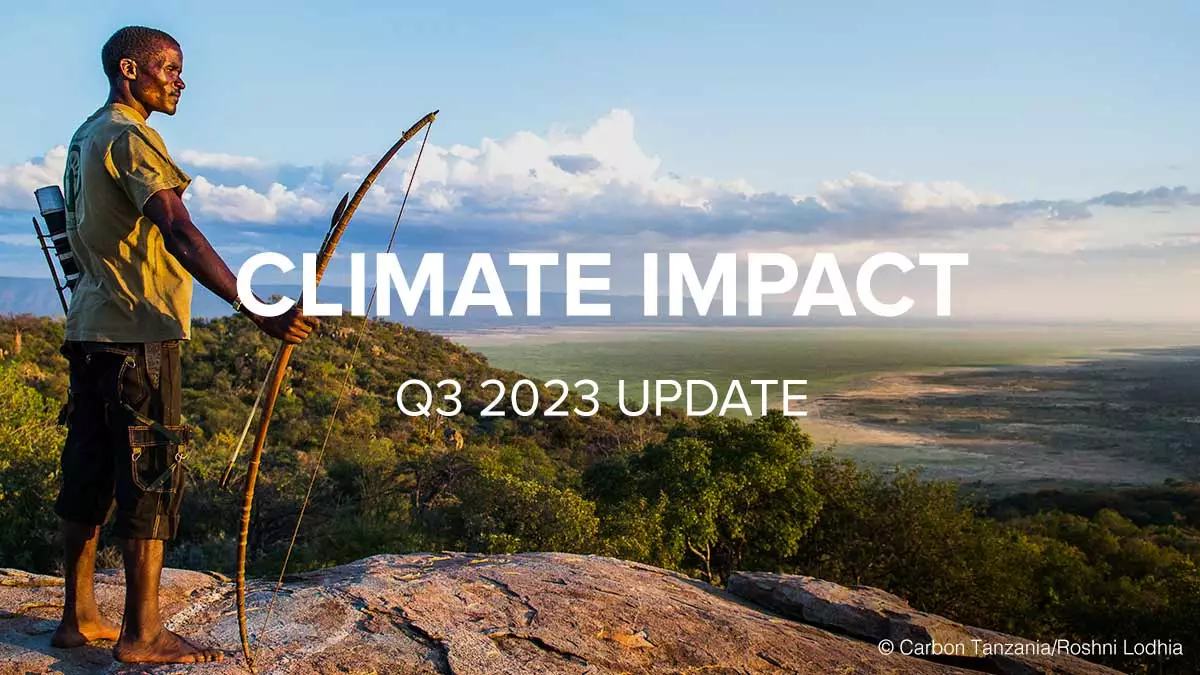
Climate Impact Update – Q3 2023
- October 19, 2023
RECENT POSTS
What is biochar and how is it a tool for sustainable tourism, kudos travel technology partners with sustainable travel international to implement its climate impact apis to scale carbon mitigation efforts.
- January 2024
- December 2023
- November 2023
- October 2023
- September 2023
- August 2023
- January 2023
- November 2022
- October 2022
- September 2022
- February 2022
- January 2022
- December 2021
- October 2021
- September 2021
- January 2021
- December 2020
- November 2020
- October 2020
- August 2020
- February 2020
- January 2020
- December 2019
- November 2019
- October 2019
- September 2019
- August 2019
- October 2018
- September 2018
- February 2018
- December 2017
- November 2017
- October 2017
- September 2017
- August 2017
- February 2017
- October 2016
- September 2016
- February 2016
- November 2015
- October 2015
- September 2015
- August 2015
- September 2014
- © 2024 | Sustainable Travel International
- Privacy Policy
Eco, Sustainable & Green Travel Thailand Tours & Trips
837 eco, sustainable & green travel trips. tours from 266 tour companies. 1,605 reviews. 4.8/5 avg rating..
Filter by trip style:
Private Guided
Small Group
River Cruise
Self-Guided
Small Ship Cruise
Large Ship Cruise

Andaman Sea, Ayutthaya, Chiang Mai
- Royal Grand Palace (Bangkok): the official residence of the Kings of Siam since 1782
- Ayutthaya Historical Park: a UNESCO World Heritage site, Ayutthaya was the second capital of the Siamese Kingdom which was founded in 1350
- Elephant sanctuary: spend a day learning about Asian elephants and the conservation efforts taken to protect these giant mammals
- Island hopping through the Andaman Sea: tour the magnificent karsts with our private boat and swim in hidden lagoons
- Thai cuisine: indulge in the curries and spices of Thailand at local food stalls
18 - 30's, Cultural, Eco, Sustainable & Green Travel, High Adventure, Hiking & Walking, Rafting, Kayaking, Canoeing, Small Ship Cruise
What travelers are saying
"I had an amazing time on the Costa Rica starter trip. This was my first time traveling solo and U30X was a great way for me to safely see another part of the world and meet new people. Our trip leaders were Adrian and Delphine; they were very knowledgeable and fun. It felt more like we were just hanging out with our friends who happened to know a lot about the country rather than following around tour guides."

Thailand to Myanmar – Bangkok to Mae Sot to the Golden Rock
Ayutthaya, Shwedagon Pagoda, Yangon
- Discover Ayutthaya
- Visit caves in Hpa An
- Explore Sukhothai and Mae Sot
- Visit Shampoo Island and Mudon
- Explore Yangon and Bago
Cultural, Eco, Sustainable & Green Travel, Education / Learning, Local Immersion & Homestays, National Parks, Nature & Wildlife, Transformative
"It is a difficult job to make everybody happy all of the time, but you ladies do a superb job. We were definitely off the beaten path, and when following that path there are sometimes unexpected surprises, but every bump was handled beautifully."

Thailand: The Untraveled Northeast – People, Nature and Archaeology
Ayutthaya, Vientiane
- Explore Bangkok
- Visit the Grand Palace
- Enjoy Grand Pearl Cruise boat on Chao Phra River to the Summer Palace
- Visit Khao Yai National Park and Mahawirawong National Museum
- Visit Sukhothai Historical Park
Cultural, Eco, Sustainable & Green Travel, Education / Learning, Local Immersion & Homestays, National Parks, Nature & Wildlife
All Eco, Sustainable & Green Travel , expedition cruises, self guided adventures and vacation packages. Find the best guided and expert planned vacation and holiday packages. Read more about Eco, Sustainable & Green Travel

Bangkok to Mae Sot to the Golden Rock
Ayutthaya, Yangon
- Palace, Klong tour to Klong Bang Luang with puppet show
- Drive Ayutthaya. Visit ruins, Bang-Pa-In Summer Palace, Muslim Quarter
- Drive Sukhothai via Uthai Thani and Pitsanuloke
- Mae Sot to Mawlamyaing through the Dawna Mountains
Cultural, Eco, Sustainable & Green Travel, High Adventure

Hill Tribes of Northern Thailand
Chiang Mai, Chiang Rai, Phuket
- Explore Bangkok.
- Visit Karen and Lahu villages and Wat Thaton
- Discover Grand Palace, Klongs, Wat Po and Wat Arun.Evening visit to China Town
- Visit the Floating Market, River Kwai and museum.
- Explore Vachiratharn Waterfall
Cultural, Eco, Sustainable & Green Travel, Education / Learning, Hiking & Walking, Local Immersion & Homestays, National Parks, Nature & Wildlife, Transformative

Holland & Belgium Bike & Boat: Bruges to Amsterdam
Amsterdam, Bruges, Holland
- Cycle along tranquil rivers and past meadows, dairy farms, quaint villages, and polder countrysides.
- Get acquainted with local people — and local life — during a visit to a family home.
- Join a local guide for a boat tour of Ghent, whose history dates to around 600 AD.
- View the famous Kinderdijk windmills, a UNESCO World Heritage site.
- Sip authentic Belgian beer during a special tasting on board.
Cultural, Cycling & Biking, Eco, Sustainable & Green Travel, Local Immersion & Homestays, Nature & Wildlife, Sailing
"This was the first organized tour my husband and I have ever joined, so we were not sure what to expect , but it turned out to be the best vacation we've ever had. The scenery and food were amazing. We stayed in beautiful hotels. Most of the riding was on paved bike paths so we hardly ever had to deal with car traffic. Our leaders, Andrea and Martin, were funny, informative , and so helpful. We are already planning to go back to Italy with VBT this summer."

El Calafate & Torres del Paine Tour
El Calafate, Los Glaciares National Park, Patagonia, Punta Arenas, Torres del Paine National Park
- Hike and discover the amazing nature of Patagonia on our El Calafate and Torres del Paine tour.
- Meet massive glaciers, rugged mountains, and wide open, star-lit skies.
- Best time to travel: From October to April.
Eco, Sustainable & Green Travel, National Parks, Nature & Wildlife, Sailing
"Just wanted to take this opportunity to thank you and your team for a fantastic holiday in Argentina! We loved the country and the people. The highlights for us was Iguazu Falls, the wine tour & the little hotel in Mendoza and the Glacier trekking. The Glacier was amazing!!! All flights were on time and your guides were always there to meet and great. Please pass on a special thank you to Carla who looked after us in BA and kept in touch all through our travels. Thanks again to Lujan, who did a fantastic job putting it all together and we will recommend you and your company to all our friends & family."
Health Safety

Hiking the French Riviera : from the back country to Antibes
- Wonderful contrast of mountain peaks & deep blue Mediterranean Sea
- Grasse the perfume capital & Vence source of inspiration for painters and writers
- Most beautiful villages in France: Gourdon, St Paul de Vence, Tourrettes sur Loup
- Moderate hikes above the French Riviera with wind sweeping views
- A mild climate : perfect to hike in winter-spring & automn !
Cultural, Eco, Sustainable & Green Travel, Hiking & Walking, Nature & Wildlife, Overland Journeys
"The variation in the scenery from La Brigue to Menton was spectacular, especially as we took it day by day and could see the gradual difference as we descended through the Maritime Alps. Our favorite towns were St. Agnes and Menton. We did our one-week tour in June, with super weather both in the Alps and down on the coast. This was the perfect way to get away for one week, but feel like we had been on a two-week holiday - fresh air, exercise, good food and nothing to arrange or worry about. Thank you"

Holland & Belgium Bike & Boat: Amsterdam to Bruges
Amsterdam, Antwerp, Barge, Bruges, Holland
- Get acquainted with local people—and local life—during a visit to a family home.
- View the famous Kinderdijk windmills, a UNESCO Heritage site.
Cultural, Cycling & Biking, Eco, Sustainable & Green Travel, Local Immersion & Homestays, Nature & Wildlife, Small Ship Cruise, Sailing, Photography

Azores walking holiday: Faial, Sao Jorge and Pico
- The discovery of 3 authentic and wild islands far away from mass tourism
- The diversity of the hikes: on coastal paths, over craters and cinders, through pastures
- The ascent of Mount Pico (2351 m) with a local guide,
- All transfers included from the airport on day 1 to the airport on day 8
- Swimming in natural pools dug into volcanic rocks
Eco, Sustainable & Green Travel, Hiking & Walking, Nature & Wildlife, Photography

Chile: Coastal Vistas & Vineyards
Casablanca Valley, Champa, Concon, Puerto Natales, Santa Rita Vineyards, Santiago, Zapallar
- Marvel at Humboldt penguins and sea lions as they lounge on islands just offshore.
- Join a captain in his small boat and help him bring in the catch of the day.
- Admire the pride of Viña del Mar, the Reloj de Flores—a large clock made of flowers.
- Stroll the cobbled, winding streets of hillside Valparaiso, a UNESCO World Heritage site, with a local guide.
- Blend your own wine with a sommelier, then have it bottled and labeled to go.
Culinary & Wine, Cultural, Cycling & Biking, Eco, Sustainable & Green Travel, Nature & Wildlife, Photography

The Beautiful Blue Danube
Bratislava, Budapest, Passau
- CRUISE HIGHLIGHTS Tour the major capital cities along the Danube
- Bask in the idyllic landscapes of the Wachau Valley
- EXCURSIONS INCLUDED: Imperial Vienna and Schoenbrunn Palace, the former summer residence for the Hapsburg monarchs, with splendid gardens and lavish rooms
- Budapest, 2000 years of history
50 plus, Eco, Sustainable & Green Travel, Family Friendly, Small Ship Cruise
"Summary over a cruise on the Haute Seine and Yonne on a barge. As seasoned cruisers, knowing well all aspects of cruising on seas and rivers, we had no experience about traveling on a barge in a canal. It was also time to overcome this lack. A number of companies offer this kind of cruising on barge with 8 to 16 passengers, however very often at exorbitant prices. Luckily, we discovered that the company CroisiEurope offers one week cruise on various canals in Europe, at very decent price, especially considering that all is inclusive (full board, all alcoholic and non-alcoholic drinks and all excursions) on modern barges with a maximum of 22 passengers. We opted for the barge Ms Deborah, which cruises on the canal de la Loire, with the Briare to Nevers’ route. We were looking forward to this itinerary because the proposed excursions particularly suited us. Unfortunately, only a few days before departure, we were informed that due of a lack of water in the Loire canal the Ms Deborah was switched over to the Haute Seine and Yonne for a new itinerary from Paris to Sens. Despites the fact that this new itinerary didn’t really meet our desires, especially the excursions, we decided to accept the change. Our group of 6 persons from Switzerland was very warmly greeted by all members of the crew when arriving on the quai de Grenelle in Paris where we see the MS DEBORAH for the first time, our floating home for the week. With its two dominating colours blue and white, it is difficult not to fall in love with this beautiful small ship. We were invited immediately for the welcome cocktail during which we met officially the crew and the other six individual passengers originating from New Zealand, England and the USA. With less time than it needs to tell, the relation between us was created, so that everyone felt part of a bunch of friends knowing each other for long time. There is no need to present here the MS Deborah itself, as this is already thoroughly done on the Cruise Critic page. The crew of 6 persons is composed of a captain, a sailor, a cruise director, a chef, a waitress and a cabin hostess who put all their efforts to satisfy the passengers and offer them the best possible service. The captain as well as the sailor are always trying to make passengers at ease, answer questions or even bring a drink. The lady cruise director is omnipresent, taking care of the passengers better than a mother hen would do. The talented young French chef aims to produce dishes which please everybody. His outstanding sauces and excellent desserts should be particularly praised. However, referring to comments we made during a cruise on the Seine Princess two years ago, we cannot understand that why today it is not possible to offer the choice of a light buffet at lunch instead a three or even four course menu! The always smiling and friendly Hungarian waitress was very caring and attentive, without forgetting the cabin hostess doing a great job in the cabins, the public spaces and even the kitchen. It wouldn’t be fair to name a single person as all members of the crew, without any exception, do all they can to make the cruise unforgettable. Our one-week cruise on the barge Ms Deborah enables us today to make the following comments: ~ a cruise on a barge cannot be compared to any other kind of cruise ~ despite all the comfort offered on modern barge, one must be very aware that life on board happens at a restraint space, requiring therefore much flexibility and understanding in all aspects from all passengers ~ in our case, being only 12 passengers, we had the opportunity to take our meals on the terrace. We also never had the feeling that the boat was overcrowded. This can be different when the ship is full, especially by bad weather ~ the state of mind between the passengers who are mostly of foreign nationalities, who don’t know each other and don’t speak French, must function well right from the beginning ~ if the interrelation works, it is difficult to find a more relaxing and enjoyable way of travelling ~ the success on a barge is mainly due on the quality of its crew. Ms Deborah’s crew members have quickly created a family spirit on board, showing also that they genuinely like what they do ~ excursions can play a major role in choosing an itinerary. Not speaking French or English can be a handicap Do we recommend to do a cruise on a barge? Yes, definitively! It’s affordable, the atmosphere on board is unique, the routes can be very interesting. In our case, this second try with CroisiEurope gives them a better note."

The Loire Valley, a Royal legacy
- CRUISE HIGHLIGHTS Cruise on board a paddle steamer
- EXCLUSIVE TO CROISIEUROPE the Loire from above(1)
- EXCURSIONS INCLUDED Full-day excursion to the castles of the Loire Valley: guided tours of the castles of Ussé, Azay-le-Rideau and the gardens of Villandry
- Wine-tasting in the cellars of the Brissac castle(3)
- Secret courtyards and covered passageways in Nantes
Best Eco, Sustainable & Green Travel Tours by Duration
Tours, Cruises & Private Trips
Best Eco, Sustainable & Green Travel Tours by Price
Related Tours
Eco, sustainable & green travel reviews & ratings, all in great company and superbly organised..
What an experience - a 3 day trip in the Atacama desert. Big skies, glorious stars, geysers, deserts, valleys and mountains - all in great company and superbly organ...
Tour: Atacama ( Chile ) And Uyuni ( Bolivia )
We will be happy to recommend your company to others.
We found Say Hueque by accident in an internet search and liked the fact that we could shape our own trip and pick and choose. The booking process with Lujan was ver...
See all Eco, Sustainable & Green Travel reviews
Eco, Sustainable & Green Travel Tour Selection Trips
- Destinations like Costa Rica , the Galapagos, and some of the Balkan countries in Eastern Europe make eco and sustainable tourism a priority - these can be some great places to start looking for inspiration!
- When it comes to Eco tours, low impact is the goal. For accommodation, think tents or lodges built with sustainable materials vs large hotels and resorts. For transport, taking local transport as much as possible is best - taking trains and buses over private cars or short-haul/domestic flights. Check what type of accommodation and transport is included in your trip.
- Read the sustainable or responsible travel commitment of your tour operator before booking. Many, like G Adventures or Intrepid Travel , have foundations that they have set up to support sustainable tourism and setup projects to support local communities in developing countries where they operate trips to, or to support endangered wildlife.
- Pick a tour that uses local country guides, who can show you the best of Eco or Sustainable Tourism in their destination(s).
- Eco friendly activities look to protect nature, wildlife, and the environment, so make sure any trips you pick do not include riding of wild animals (such as elephants) or (directly or indirectly) encourage the keeping of animals in captivity for tourism purposes.
- When going on safari , look for operators that prioritize the protection of animals and respect them in their natural habitats.
- While we often can’t avoid talking flights to reach our travel destination, there are carbon offset programs available which you can choose to contribute to - your tour operator may be able to advise further on the options available.
Additional details
Always Find the Best
On Travelstride you can find 837 trips to Eco, Sustainable & Green Travel and more than 20,000 trips worldwide ranging from budget to luxury and private guided to group tours and everything in between. Only on Stride can you find and compare expert-planned trips from 1,000+ tour operators, cruise lines and local experts. Read traveler and professional reviews so you can confidently find your perfect trip.

Making destructive tourism sustainable
Tourism accounts for around 8% of global greehouse gas emissions, with around half coming from flying to and from destinations.
As airlines and hotels out-compete each other on price, post-pandemic tourist numbers are breaking records , with one million people arriving in Greece per week in the summer of 2022 — despite high inflation and an energy crises driven by the war on Ukraine, and intense wildfires linked to climate change .
The ecological and climate impact of this overtourism is forcing the industry to act, and to follow in the footsteps of some sustainable tourism pioneers.
'The Beach': Thailand's Maya Bay closes for restoration
Maya Bay , an an idyllic beach on an uninhabited island in Thailand's Phi Phi archipelago, become globally famous when it was the location for "The Beach," the 2000 film starring Leonardo DiCaprio.
Flanked by vast limestone cliffs, the secluded cove with its white sand and turquoise water became jammed with flotillas of boats and cruisers as thousands of tourists flocked to the beach daily for nearly two decades.
Tourist traffic led to pollution from discarded trash and damaged coastal vegetation, but the main problem was the boats dropping their anchors onto the coral below.
When "The Beach" was sealed off to the public in 2018, there was only 8% of the coral coverage in the bay, compared to up to 70% some 30 years before.
A restoration team set about replanting the destroyed coral to rehabilitate the reef in five to 10 years. Boats have to dock at a new pier rather than come ashore on the beach, swimming is forbidden, and new boardwalks keep visitors from trampling the delicate coastal ecostyem.
When Maya Bay finally reopened in early 2022, visitor numbers were cut from the previous height of around 7000 to around 400 per day, noted Thon Thamrongnawasawat, head of the restoration team, in an interview with China's State news agency, Xinhua.
"It is one of the most successful marine actions in many years not only for Thailand but for the whole world," he said.
Bhutan adapts to climate change via tourism fee
The tiny Himalayan kingdom of Bhutan, known for its philosophy of promoting " gross national happiness ," introduced a Sustainable Development Fee (SDF) of $65 (€61) around three decades ago to limit mass tourism in the mountainous nation.
Under the mantra of "high-value, low-volume" tourism, the tax revenue has been invested into conservation and sustainability through planting trees, clean and maintain trails and to electrify transport. The fee has helped Bhutan become South Asia's only carbon-negative country as its protected forests continue to store more carbon than the country emits.
The money also addresses high vulnerability to climate change , with impacts ranging from severe drought to melting glaciers.
In 2022, the Bhutan government raised the daily fee to $200 dollars per person when it reopened following the pandemic, saying the cash would be used to offset tourism emissions.
But the fee hike hit tourist numbers and resulted in losses across the sector. In August, Bhutan halved the amount to US$100 to stimulate tourism as it strikes a balance between climate protection and the local economy.
Costa Rica fights deforestation with ecotourism
In 1997, Costa Rica implemented a Certification for Sustainable Tourism that became a pioneering blueprint for a climate- and environment-friendly travel industry.
The reform was in line with an attempt to reverse decades of deforestation, with around half the forest that once covered 75% of Costa Rica lost between the 1940s and 1980s.
Small ecotourism entrepreneurs soon created low impact resorts and ecolodges aimed at more affluent travellers wanting to explore the country's rich biodiversity and natural beauty.
Sustainable tourism is integral to the fact that over half the nation is again covered in forest. Meanwhile, more than 98% of the Latin American nation's energy comes from renewable sources.
As part of its strict ecotourism certification, Costa Rica has continued to prove the fact that some visitors will pay more for a genuine sustainable travel experience.
Mallorca: Can sustainability tax offset overtourism?
During peak tourist season, an airplane lands or takes off in the Balaeric Sea island of Mallorca every 90 seconds.
"There are few places in the world that contribute as much to global warming as Mallorca," Jaume Adrover, a spokesperson for the Mallorca-based environmental group Terraferida, told DW in 2022 of the tourist mecca. "And this is due to only one activity: tourism."
During its 2019 peak, 12 million visitors descended on an island whose population is a little over 900,000 people. The sheer weight of numbers has forced the government to limit the ecological and climate impact of the industry.
A new 2022 tourism law addresses issues of energy efficiency and CO2 reduction in the hotels sector. Hotels need to eliminate fuel oil or diesel boilers to reduce CO2 emissions, and also install water-saving devices while banning single-use plastics. A moratorium on any new tourist accommodation until 2026 aims to reduce the explosion in tourism numbers.
This follows the introduction in 2016 of a daily eco tourism tax, currently as high as €4 euros per day, that is being reinvested in sustainability, including the restoration of Posidonia seagrass meadows.
Dubbed the "lungs of the Mediterranean," the seagrass produces oxygen, absorbs carbon, provide habitat and shelter for a variety of species, yet has receded around Mallorca due to pollution, and like in Maya Bay, boat anchors.
But without significantly reducing the number of tourists, and therefore flights, local ecologists like Jaume Adrover still fear that not enough is being done to transform the tourist hotspot into a model of sustainability.
Edited by: Tamsin Walker
Author: Stuart Braun
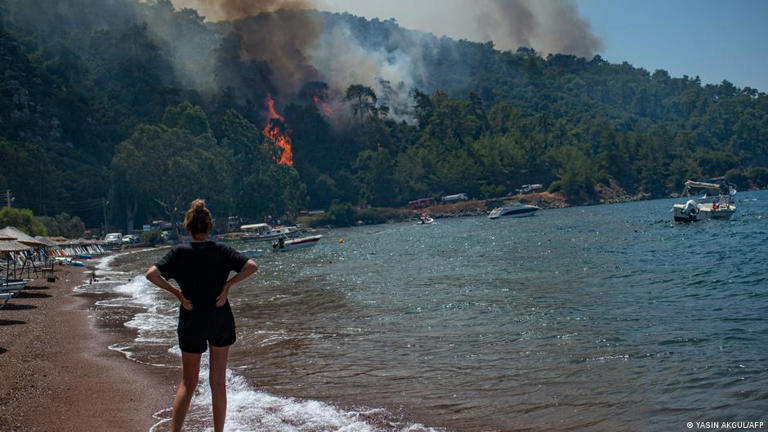

IMAGES
VIDEO
COMMENTS
Sustainable Tourism in Thailand - Ecotourism, Wildlife and Culture Guide. Thailand, the Land of Smiles, has firmly cemented itself as one of the most popular tourist destinations on the planet. With 39 million people visiting the Southeast Asian nation in 2019, the word is well and truly out on just how magical Thailand really is.
Green spaces. There is perhaps no better way to appreciate Thailand than its raw, natural state, and with more than 100 national parks dotted around the country, there are plenty of options to do so. The kingdom's first protected swathe of jungle, Kho Yai National Park, is also its most popular.With around 50 kilometres of hiking trails, you can choose from easy rambles to more challenging ...
Remember, every small choice adds up to a significant impact on sustainable travel in Thailand. 5. Bring eco-friendly essentials. To round off your green travel tips for Thailand, packing eco-friendly essentials is non-negotiable. Invest in reusable water bottles, bamboo utensils, and biodegradable bags. Your efforts to minimize plastic waste ...
2. Be proactive. Sustainable travel in Thailand can be about much more than making sure you are making a minimal impact on the environment. In many ways, you can actually do something positive! There are tons of volunteering options available in the Southeast Asian nation that can help you in this aim.
Stop in a village and support the locals by getting lunch, buying a coffee or purchasing a handicraft. If you do choose to visit a hill tribe with a tour, be sure to choose a reputable company. 4. Avoid sex tourism. Unfortunately, Thailand is well-known for its sex tourism industry.
4. Pai. 5. Koh Yao Islands. Rising global environmental concerns, like climate change, have led to an increase in the popularity of eco-tourism, as many travelers now look for opportunities to explore natural areas with as little impact on the environment as possible. For reasons which you'll soon see, Thailand as a prime tourist destination ...
As eco-tourism takes centre stage in the global travel agenda, Thailand emerges as a shining example of how natural beauty and sustainability can be harmoniously balanced.With a dedication to preserving its rich ecosystems and cultural heritage, Thailand offers eco-conscious travellers a plethora of destinations that cater to a sense of adventure, while minimizing the impact on the environment.
Don't ride, bathe, or feed elephants. Travel long distances by boat, bus, or train. Travel in the shoulder seasons. Travel off the beaten path. Choose ethical tour companies. Choose ethical and local dive centers. Do a beach clean-up. Choose human-powered transport when possible. Reflections on eco tourism Thailand.
Sustainable and responsible travel is an increasingly important concept that recognizes the impact of tourism in Thailand as well as other destinations and aims to promote practices that preserve natural resources, cultural heritage, and local communities.
Notep is a famous Thai artist, musician, environmentalist and freediver who has dedicated her time recently to encouraging eco tourism in her beloved Ko Tao and Chiang Mai. Here, she offers her sustainable travel guide to Thailand - where to visit, stay, shop and swim in the cleanest, greenest, most regenerative manner.
For a list of local green operators, contact the Thai Ecotourism and Adventure Travel Association (tel. 02642-5465; www.teata.or.th ). Some hotel groups, such as the Banyan Tree resorts in Bangkok and Phuket, have made huge efforts over the past decade to implement sustainable projects, including a pledge to reduce their carbon footprint in all ...
Sustainable tourism allows travelers to explore amazing landscapes while encouraging respect and appreciation of local culture and nature. With its stunning geography, Thailand can inspire profound connections between visitors and their natural environment through meaningful ecotourism experiences. Ecotourism connects us to natural and cultural ...
Sustainable travel has become increasingly popular in Thailand in recent years, thanks to its stunning natural destinations. Certain areas of Thailand, such as Koh Phangan, Bangkok, and Phuket, have been crowded with tourists for decades. The Thai government has even taken measures to reduce overcrowding in the country, closing the popular Maya ...
As Thailand's tourism ministry urges, remembering simple mottoes like "Reduce, Reuse, Recycle" drastically helps to protect the country's future. 1. Minimize Plastic Consumption. Avoid purchasing water bottles and instead carry a reusable container that can be endlessly refilled. Stylish options made of stainless steel, glass, and BPA ...
Get more Thailand Travel Tips here. Sustainable Travel in Phuket FAQ's What is the impact of mass tourism on Phuket's environment and local communities? Mass tourism can strain resources of local population like water and energy, generate pollution, contribute to habitat destruction, increase the cost of living for locals, and dilute their ...
Thailand is one of the most popular destinations in the world and invites with white beaches and turquoise sea. Sustainable travel in Thailand is becoming increasingly popular. We are especially happy to see that there are not only many tourists, but also more and more green projects.
ㅤ. Thailand is the first country to implement the UNESCO Sustainable Travel Pledge nation-wide. This pilot initiative is part of a larger partnership between UNESCO and Expedia Group, with the aim to promote sustainable tourism. A year after launching the UNESCO Sustainable Travel Pledge in Thailand, more than 500 hotels have signed the ...
Conclusion: Sustainable travel in Thailand goes beyond enjoying picturesque landscapes and immersing oneself in local culture. It encompasses a commitment to leaving a positive impact on the environment and communities visited. By exploring destinations like Chiang Mai, Phuket, Koh Lanta, Bangkok, and Khao Sok National Park, travelers can contribute to local conservation and community ...
The reopening of Thailand's international borders in the post-pandemic era has heralded in a new direction of tourism, one that is aligned with safe and sustainable travel. With the adoption of #ecotourism under its Bio-Circular-Green (BCG) model, Thailand's new tourism scene has proven to provide much job creation and growth in the green sector.
Sustainable travel in Thailand aims to preserve natural habitats and ecosystems, preventing the need for such emergency action from governing bodies. We also believe that it is incredibly important to travel in a way that is respectful to local communities; we're conscious that over-tourism can have a huge impact on people's livelihoods ...
Bangkok, 16 June, 2021 - The Tourism Authority of Thailand (TAT) recently signed a Memorandum of Understanding (MOU) with the Thailand Greenhouse Gas Management Organisation (TGO) and the Thai Ecotourism and Adventure Travel Association (TEATA) to promote low-carbon tourism and implementation of climate action for sustainability.. TAT Governor Mr. Yuthasak Supasorn said, "This MOU forms ...
This video takes viewers to the WongPhai Bamboo Biochar carbon offset project in Thailand. During this visit, two members of the project team, Fred Hornaday and Benjamin Bennett, delivered a five-day training. ... Kudos Travel Technology's integration with Sustainable Travel International's Climate Impact API allows companies and ...
Eco, Sustainable & Green Travel Thailand Tours & Trips 833 Eco, Sustainable & Green Travel trips. Tours from 266 tour companies. 1,605 reviews. 4.8/5 avg rating. Filter by trip style: Group Tour. Private Guided. Small Group. River Cruise. Self-Guided. Small Ship Cruise. Large Ship Cruise.
In 1997, Costa Rica implemented a Certification for Sustainable Tourism that became a pioneering blueprint for a climate- and environment-friendly travel industry. The reform was in line with an ...
Accessibility serves as the fundamental link for mode shifts, enabling access to activity areas and facilitating connections to other forms of travel. However, navigating the transportation network in urban areas of Bangkok, Thailand, reveals persistent inconveniences, discomfort, and safety concerns, thereby failing to adequately meet the needs of users. This study aims to examine urban ...
Venice council has earmarked €27.7 million to repair and redevelop around 500 apartments in the historic centre, islands and mainland. There are reportedly around 2,000 properties currently ...